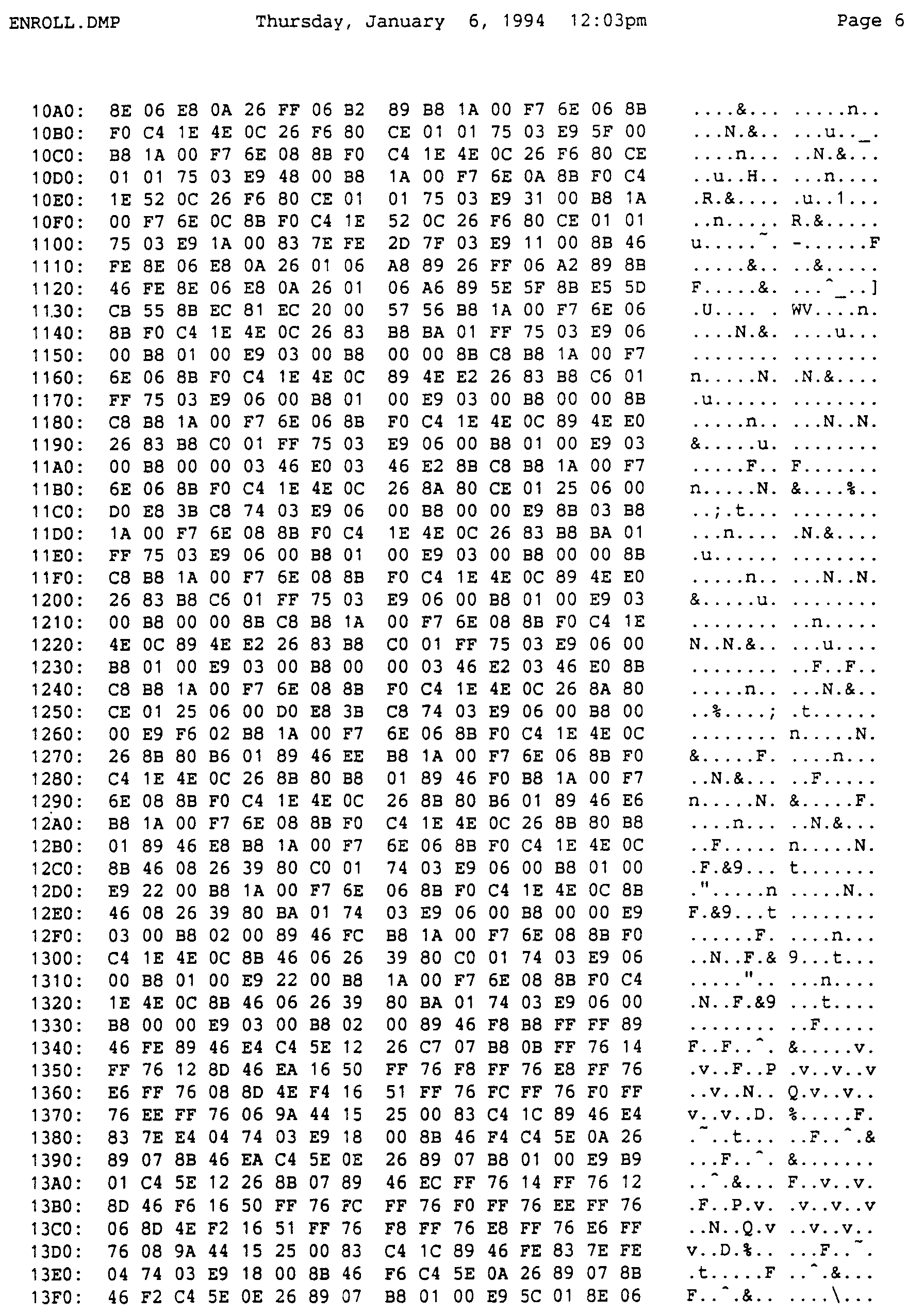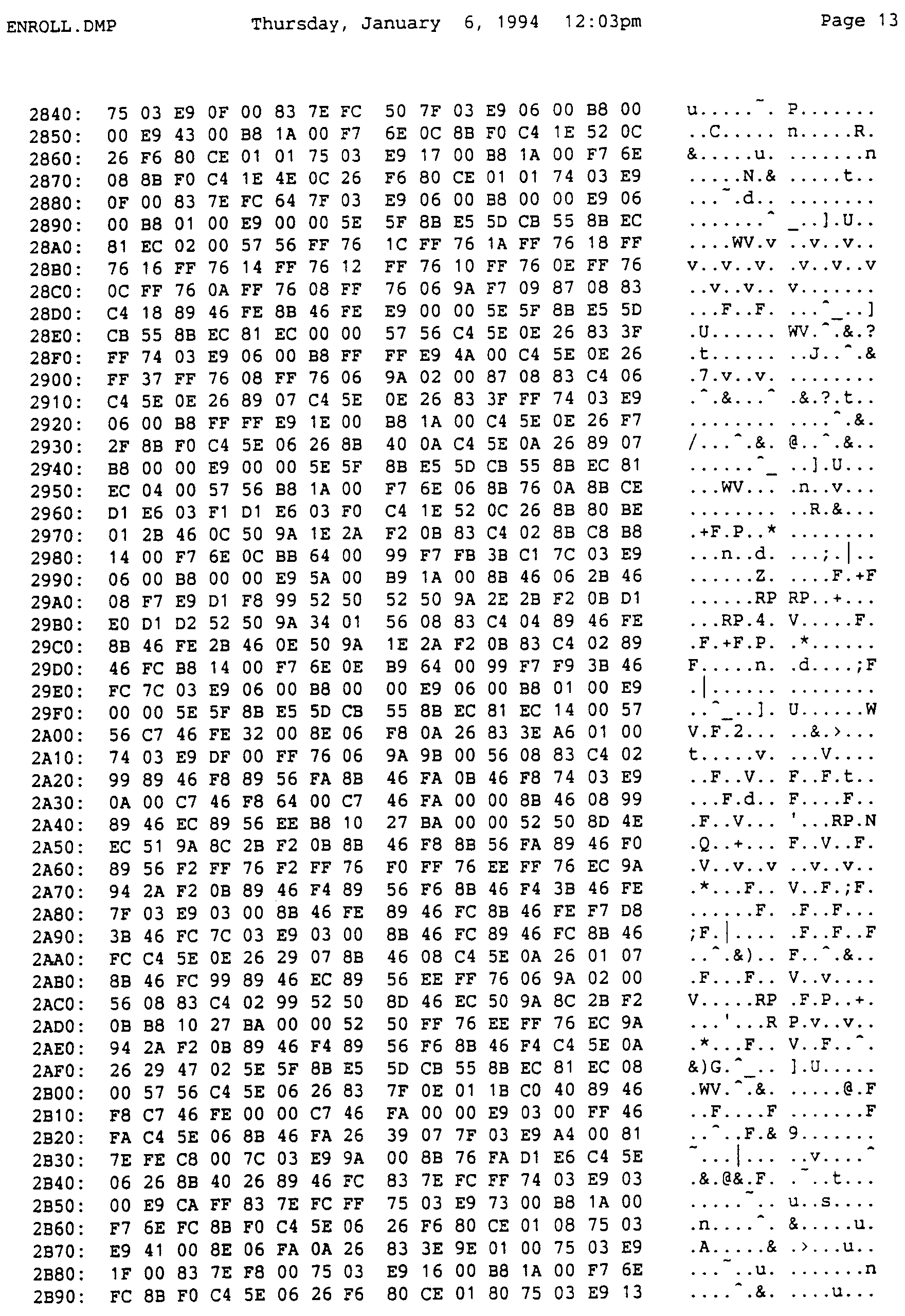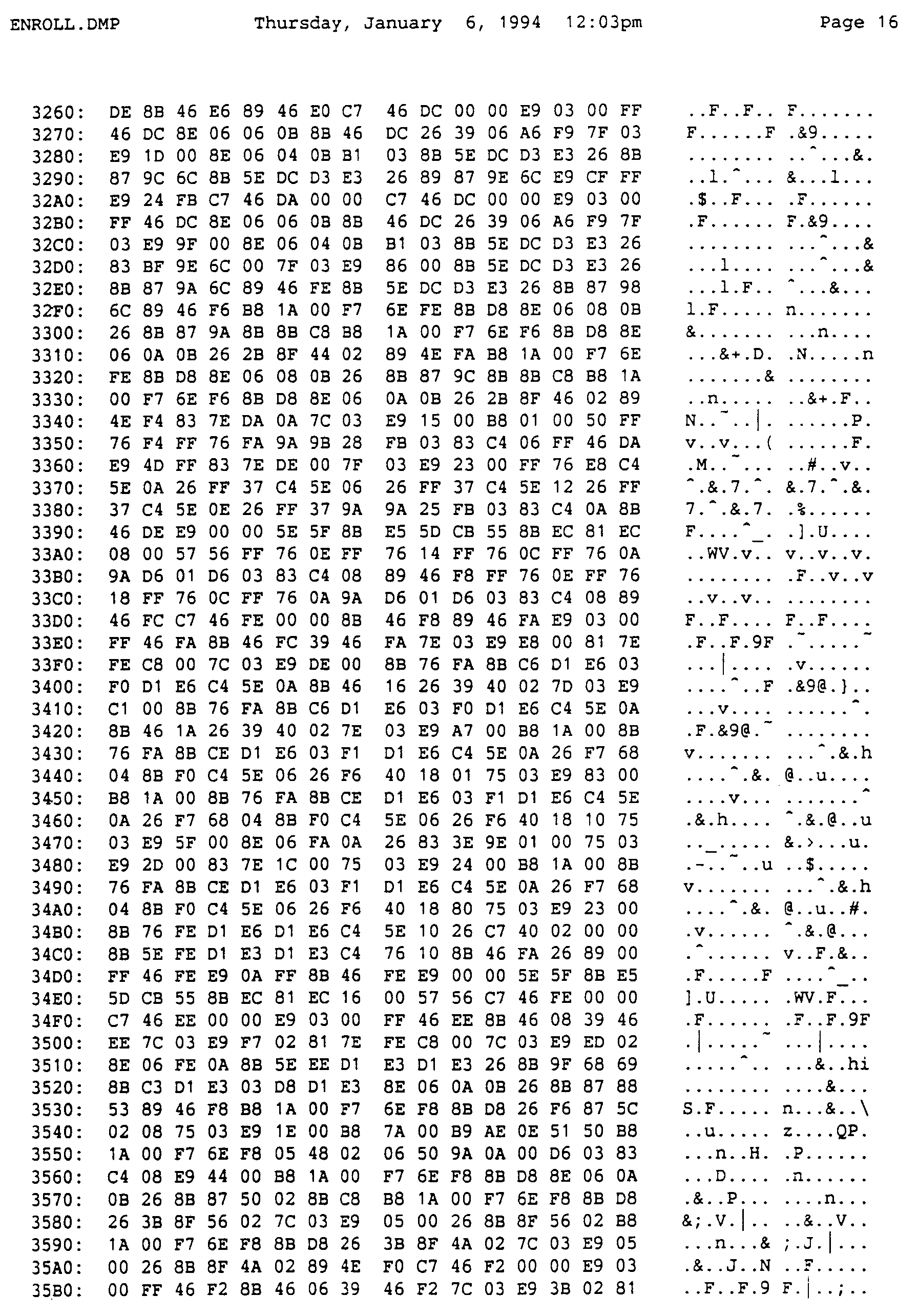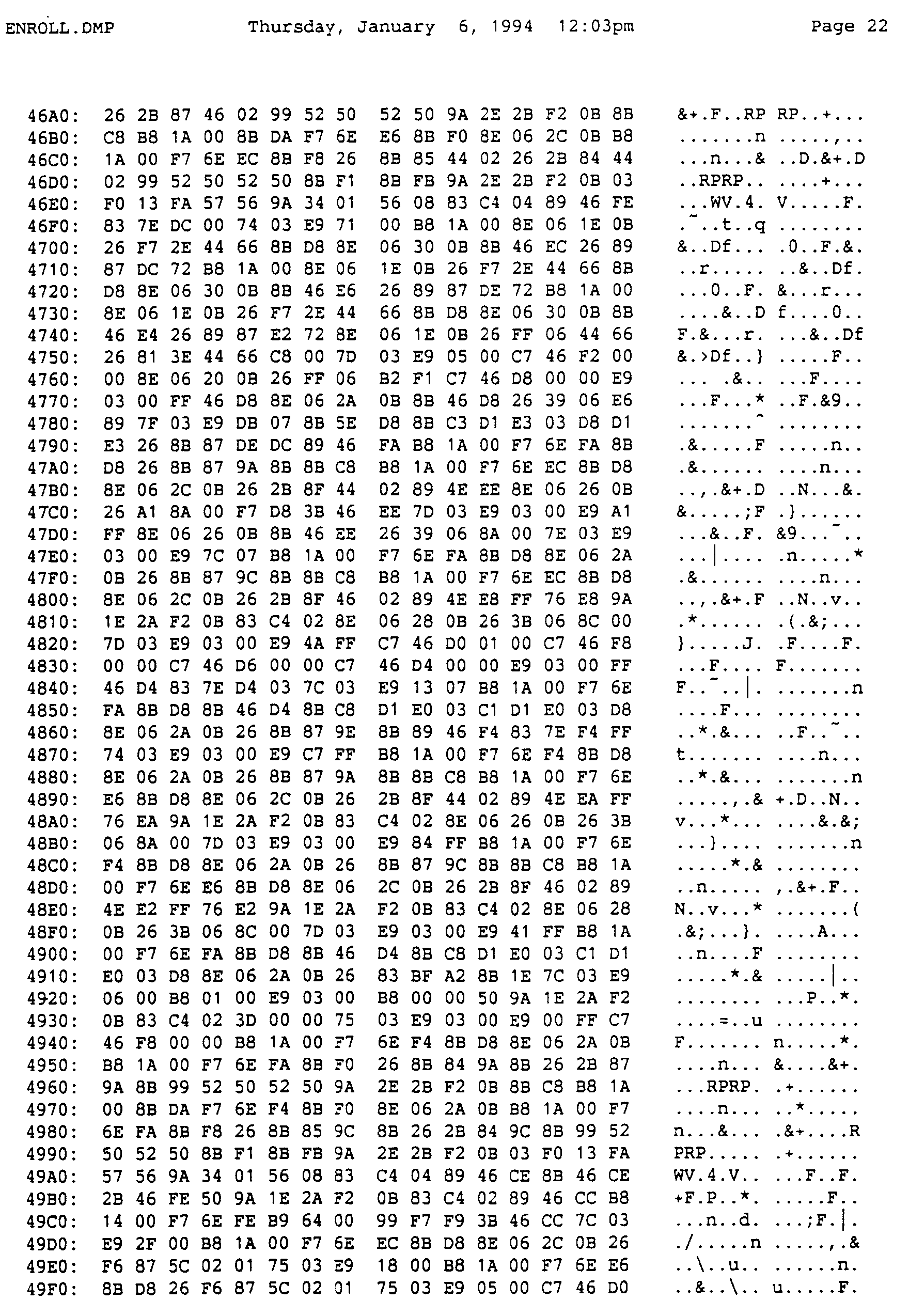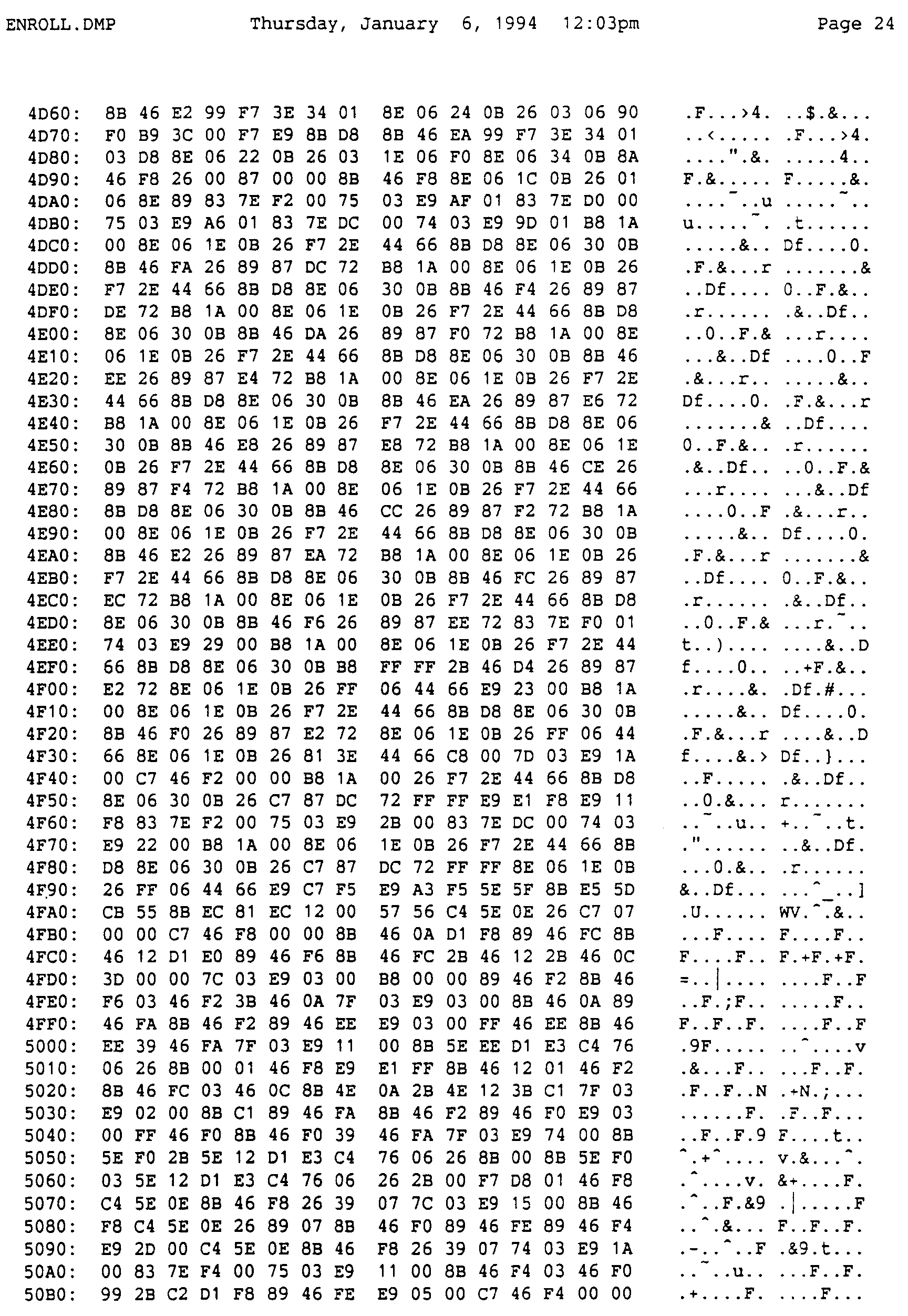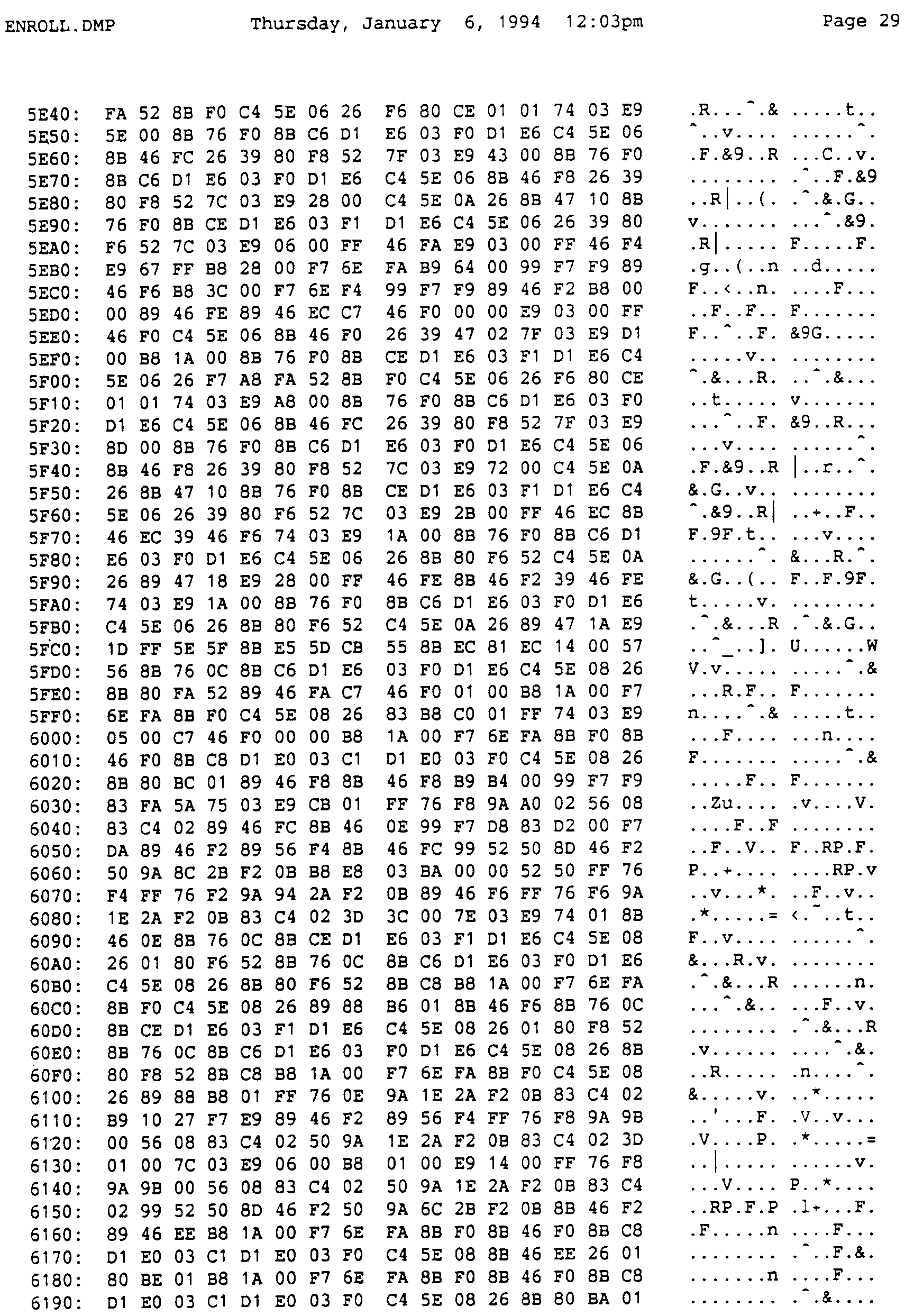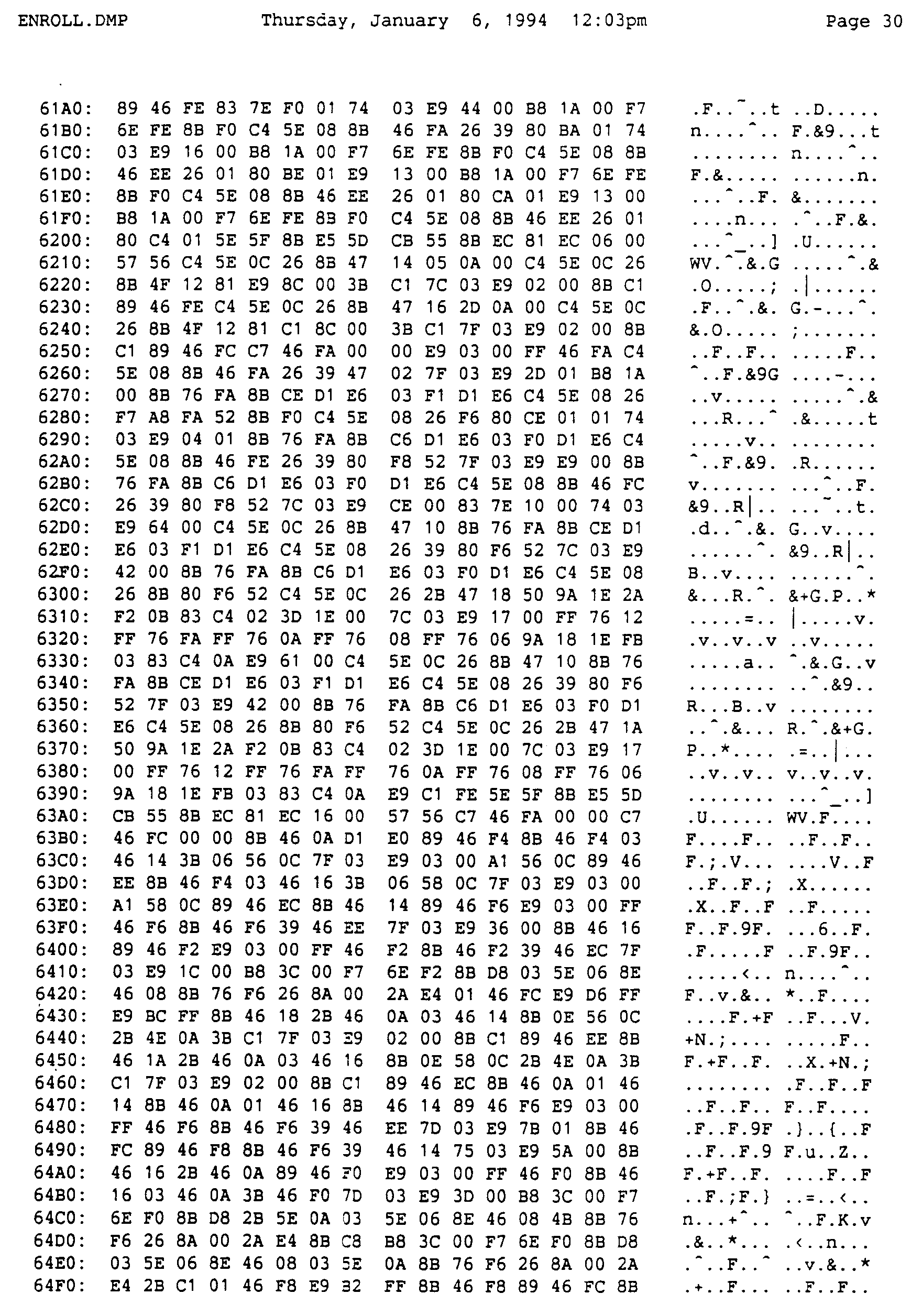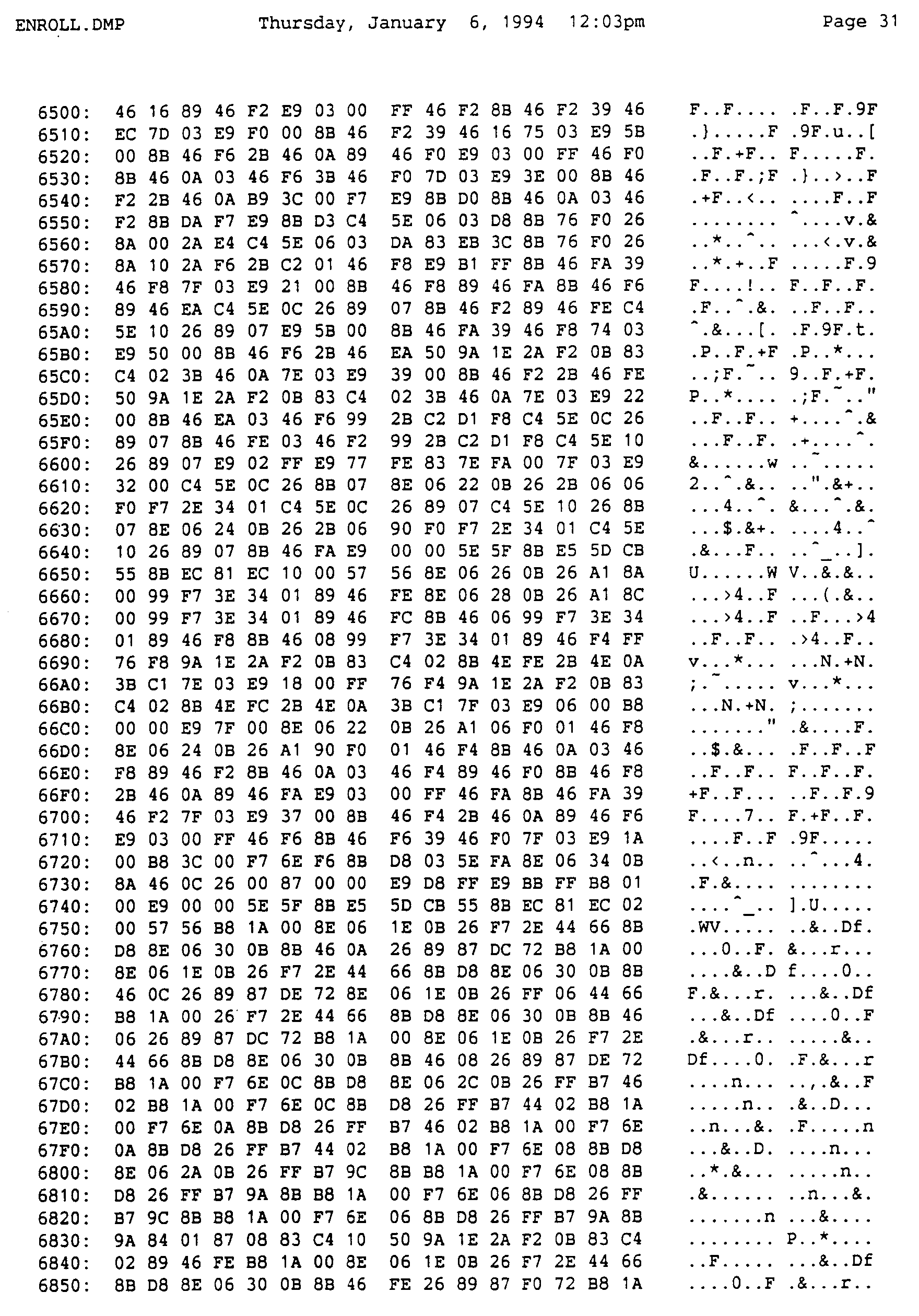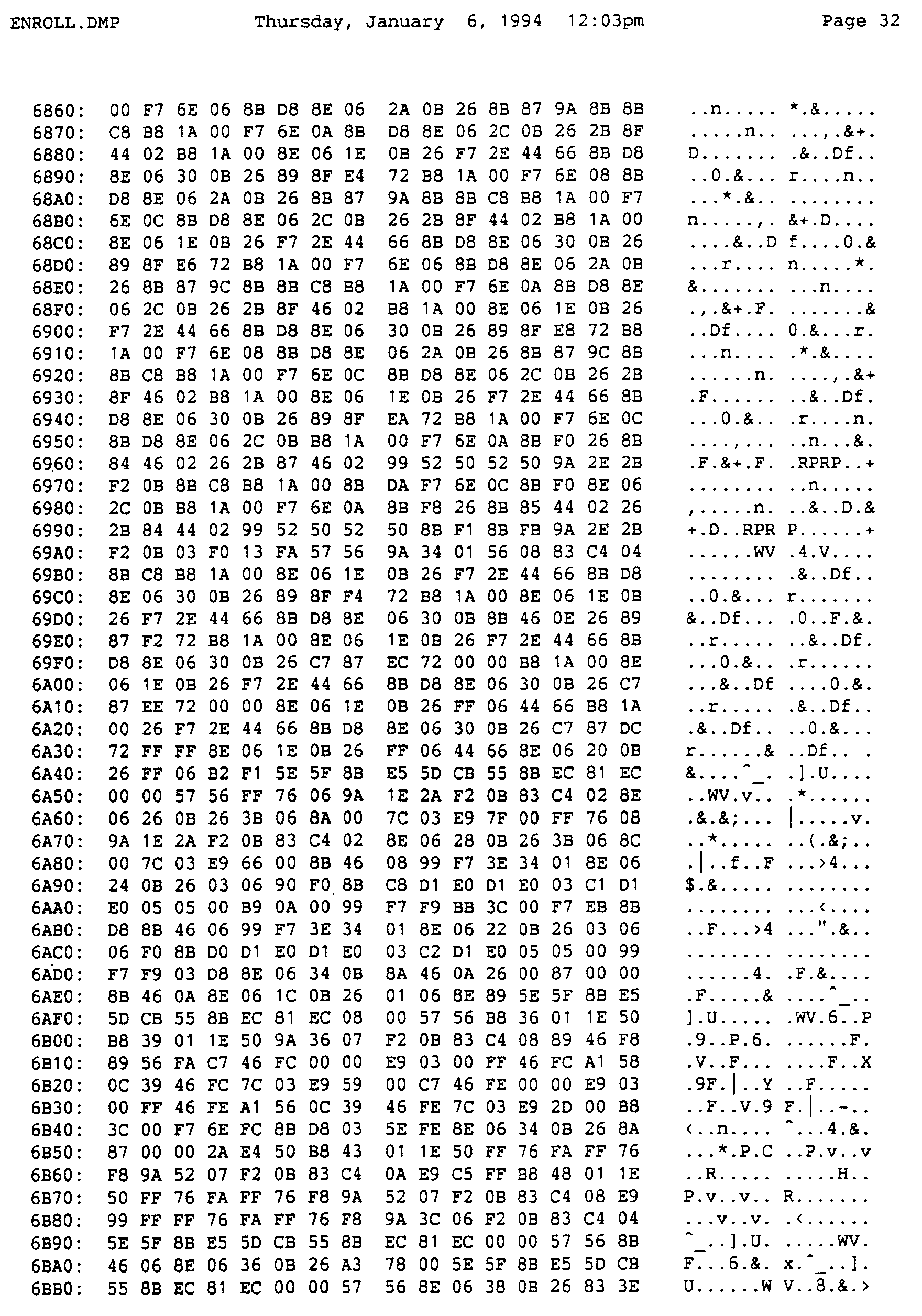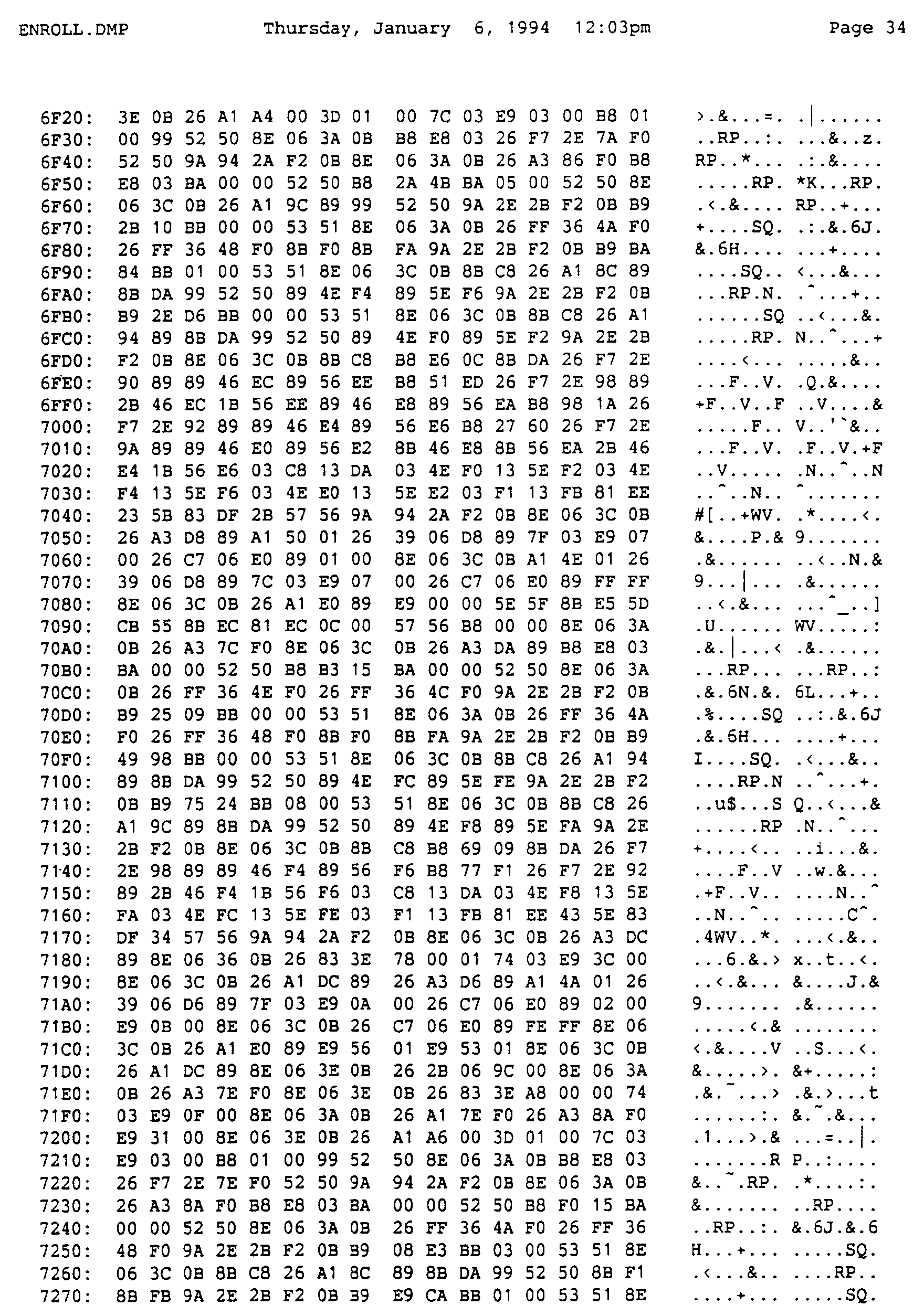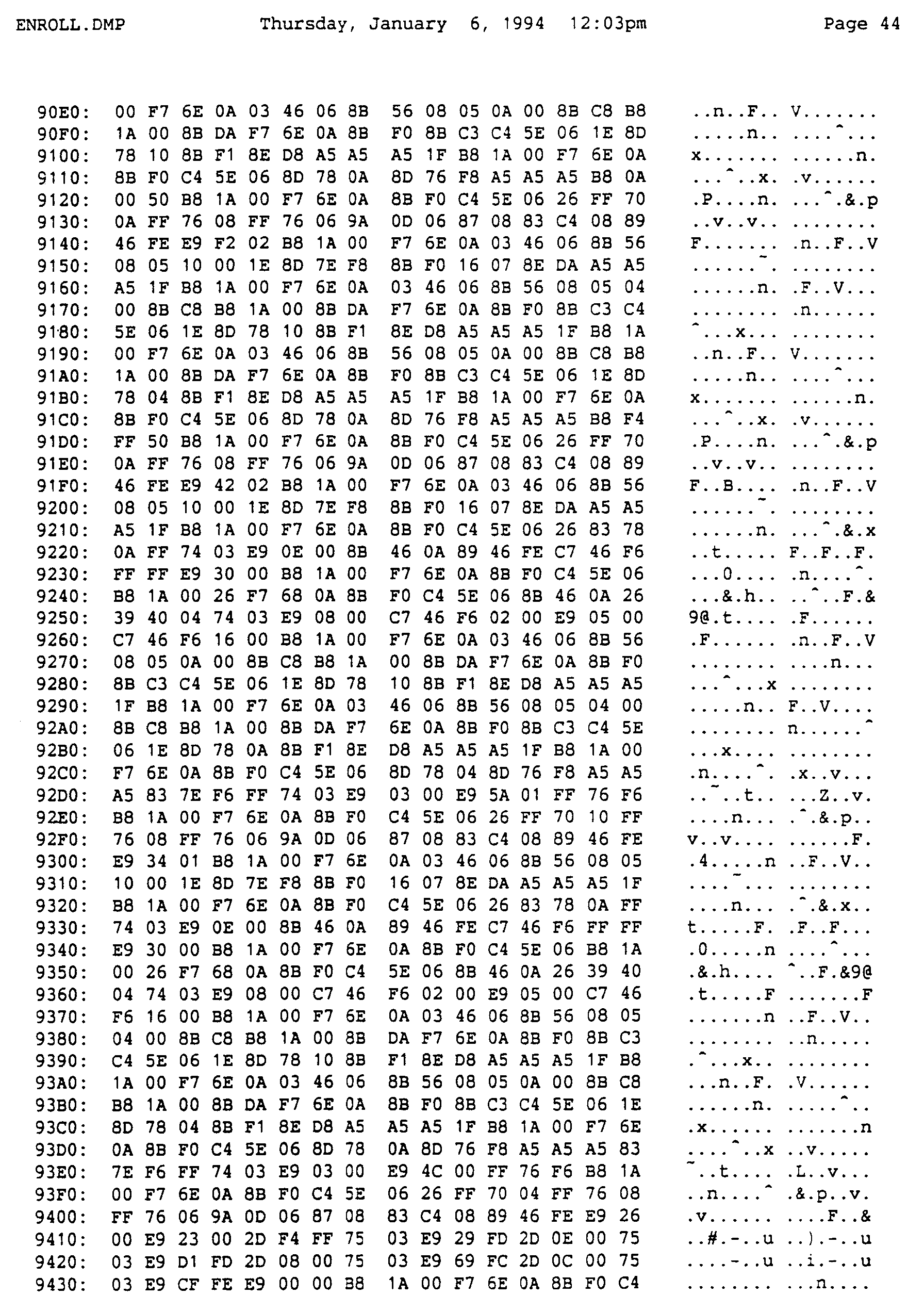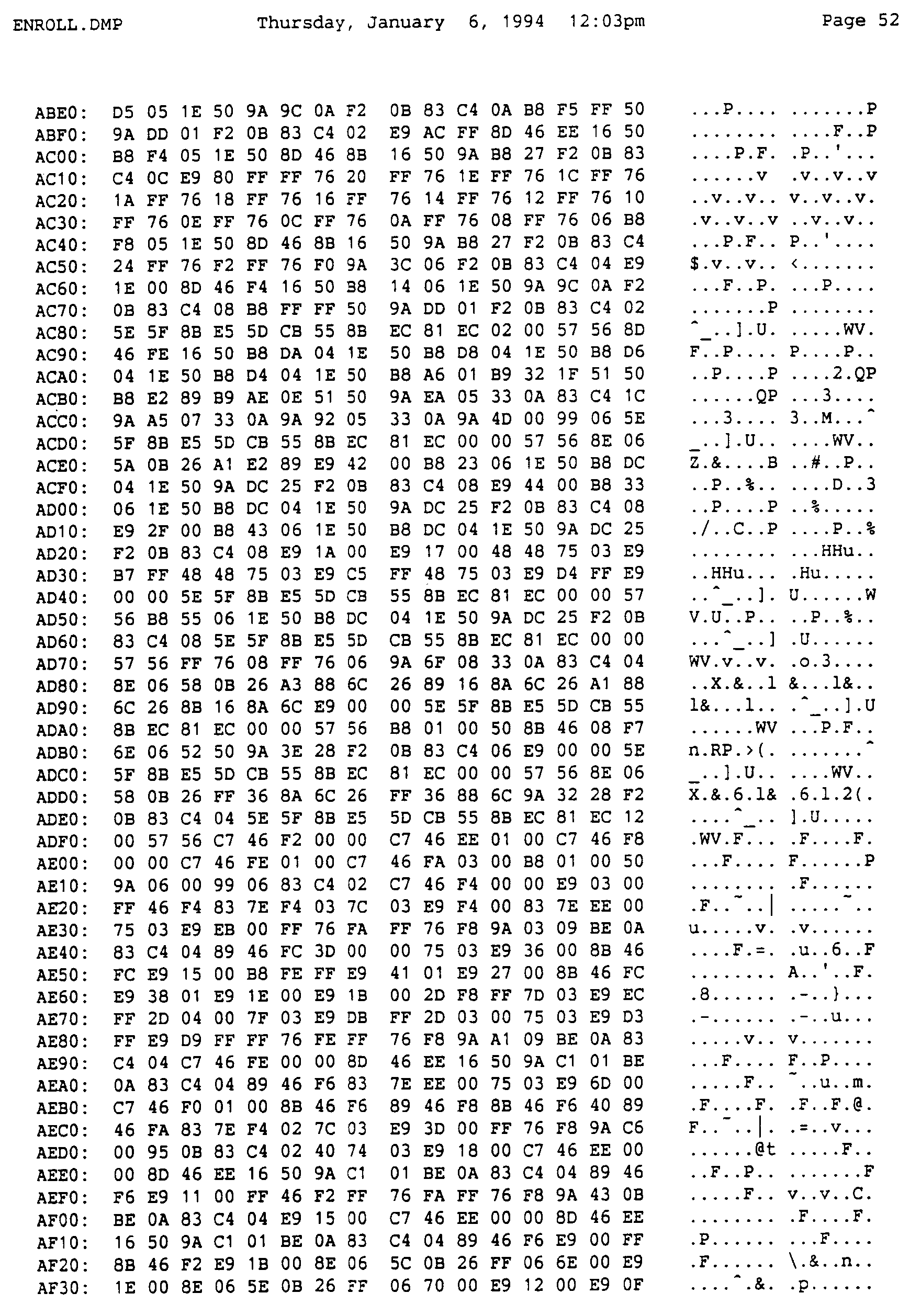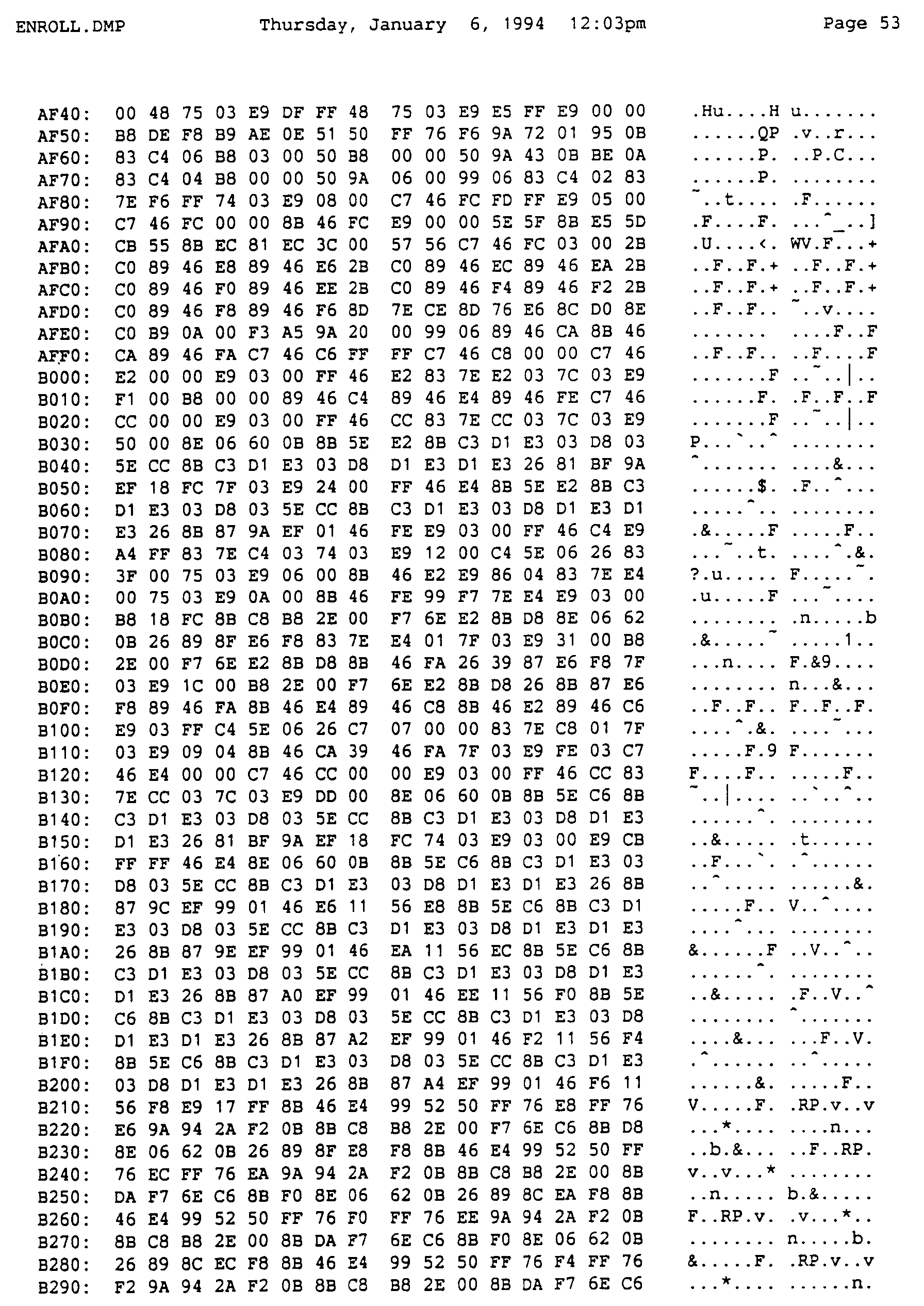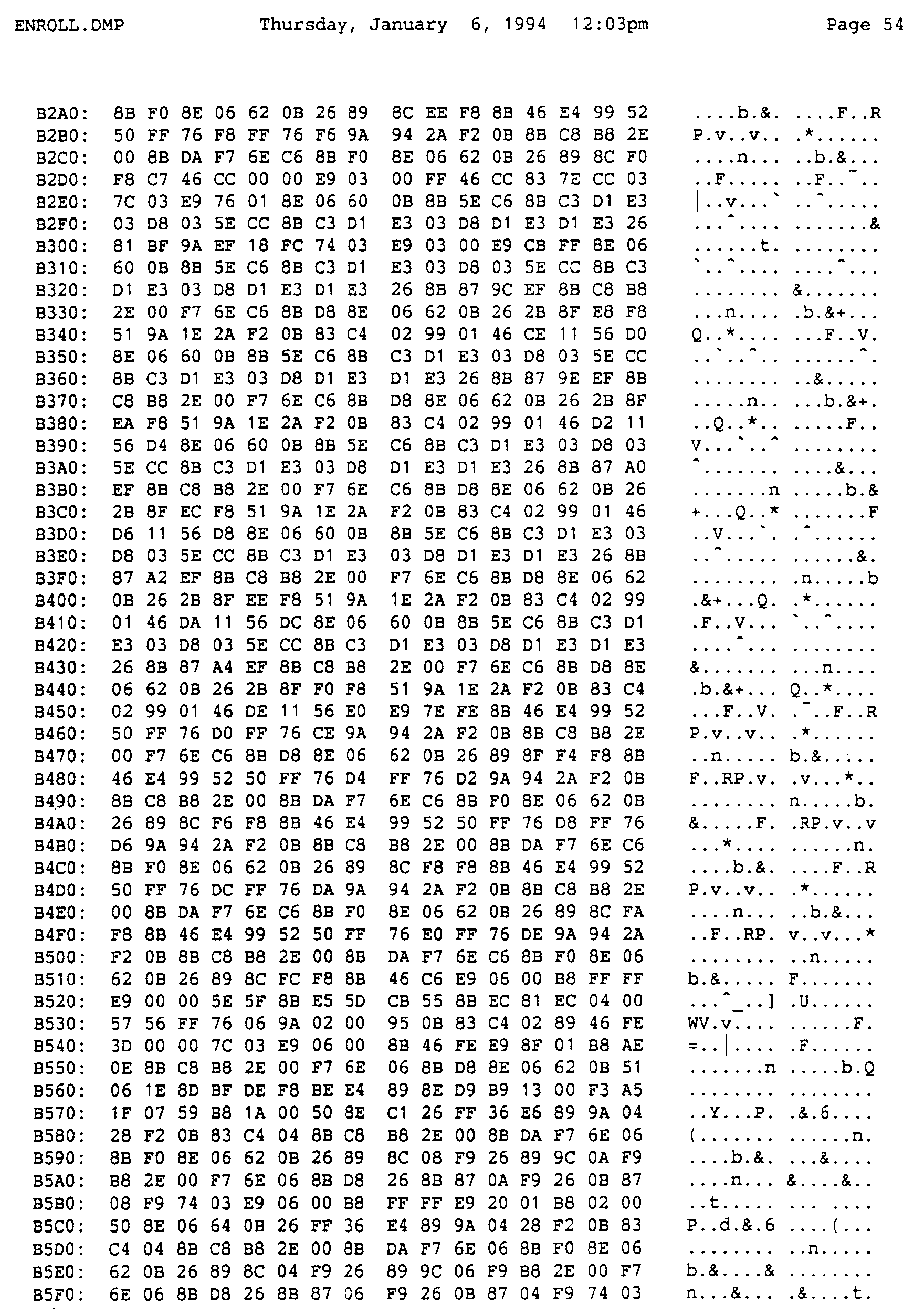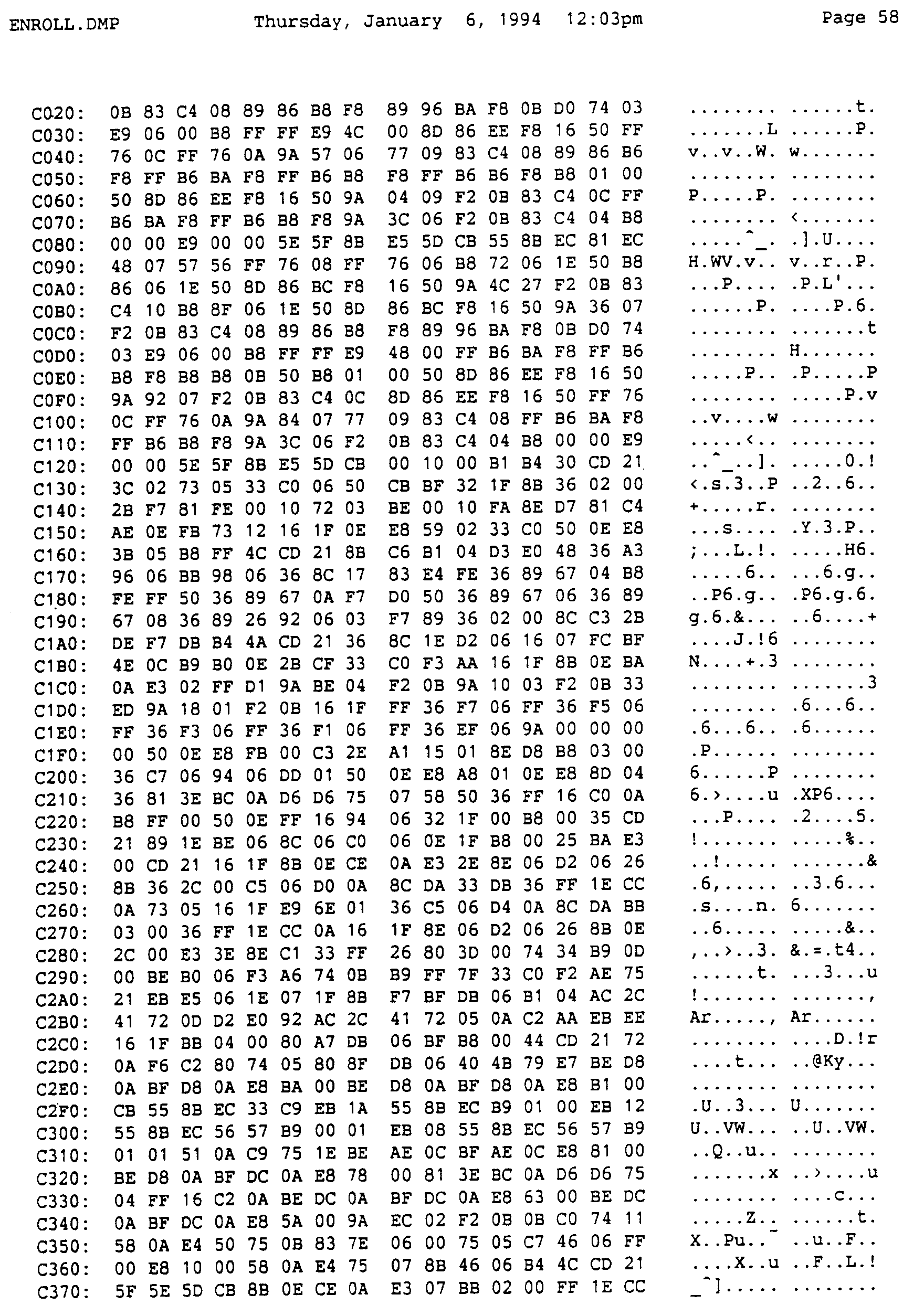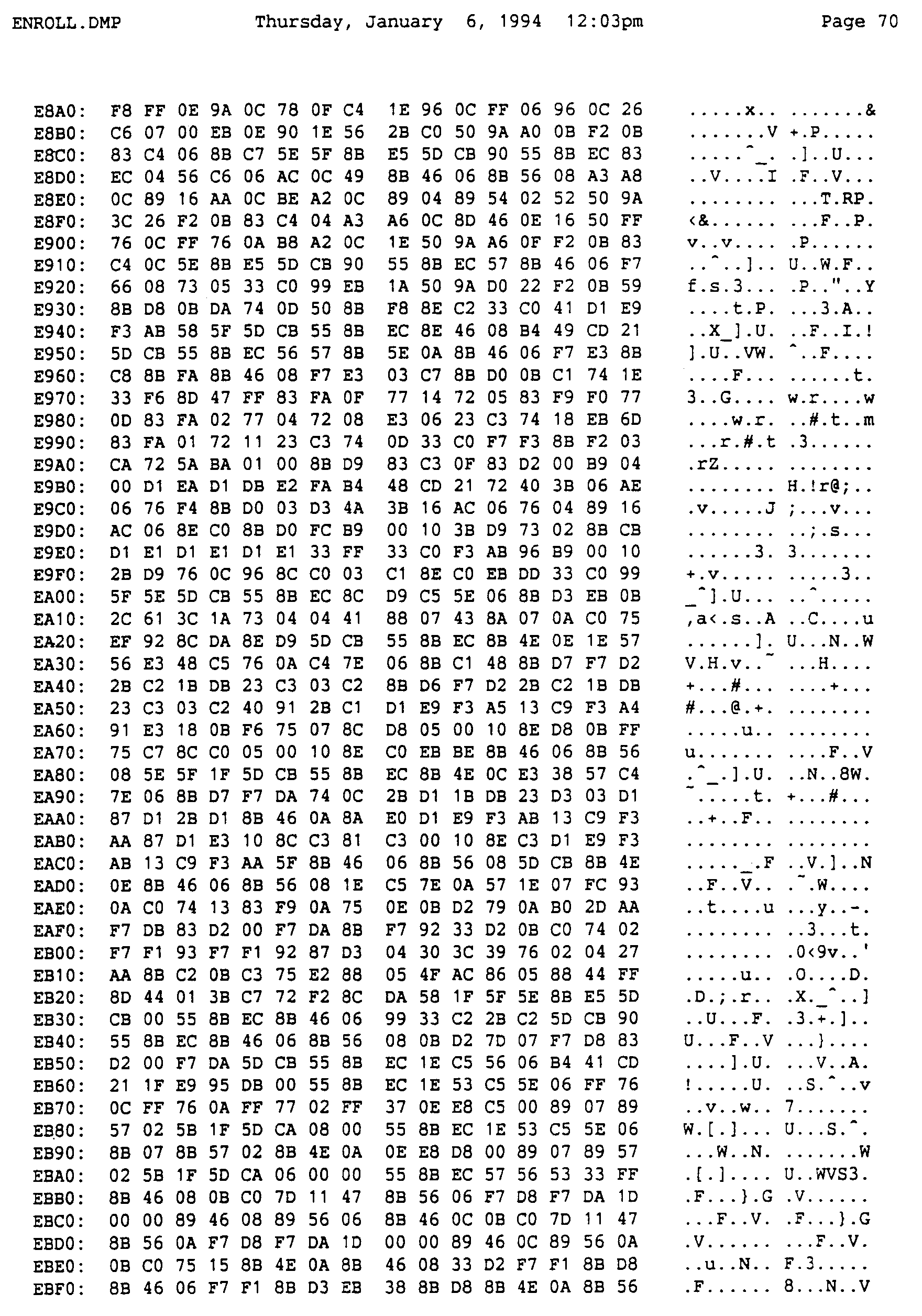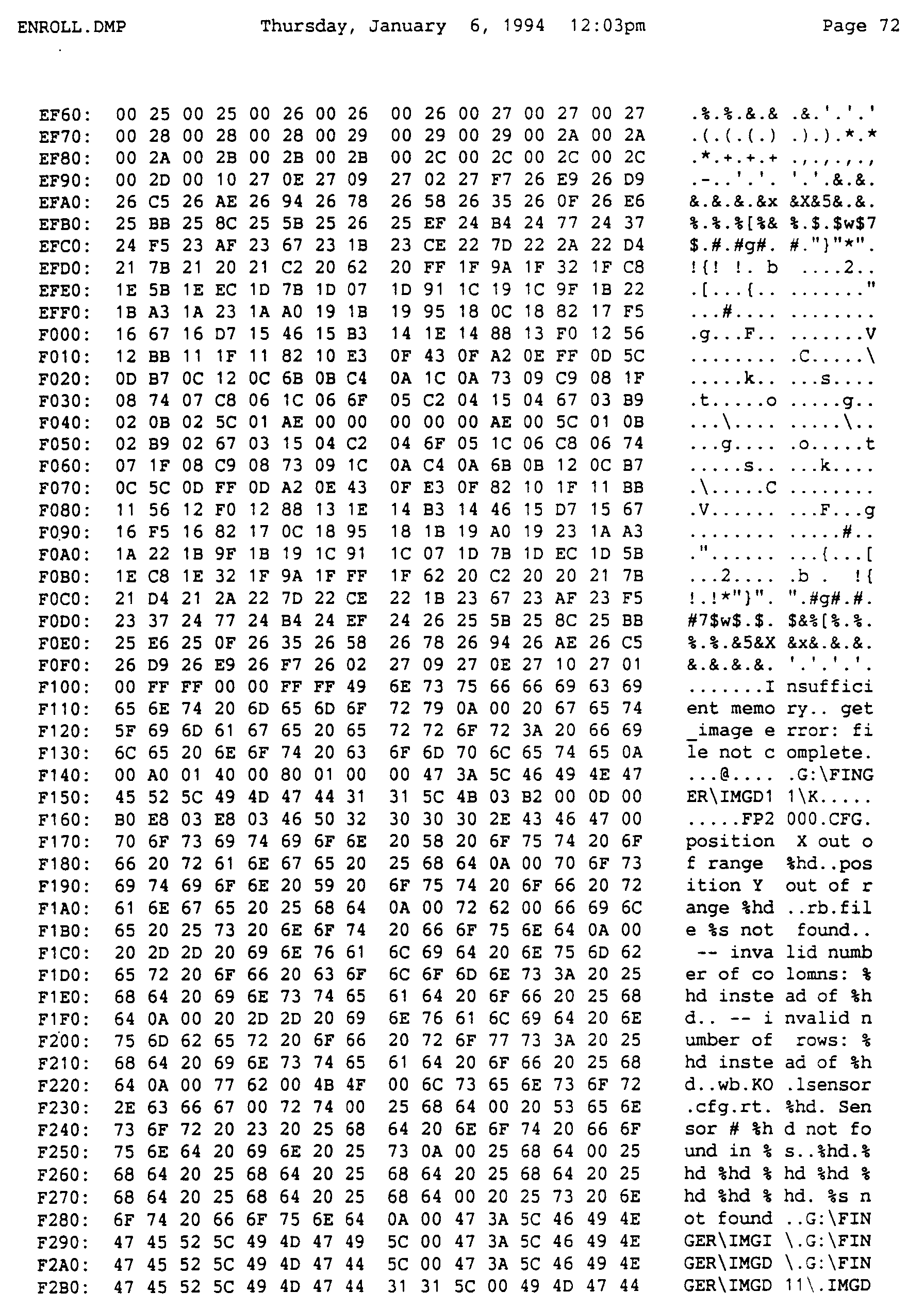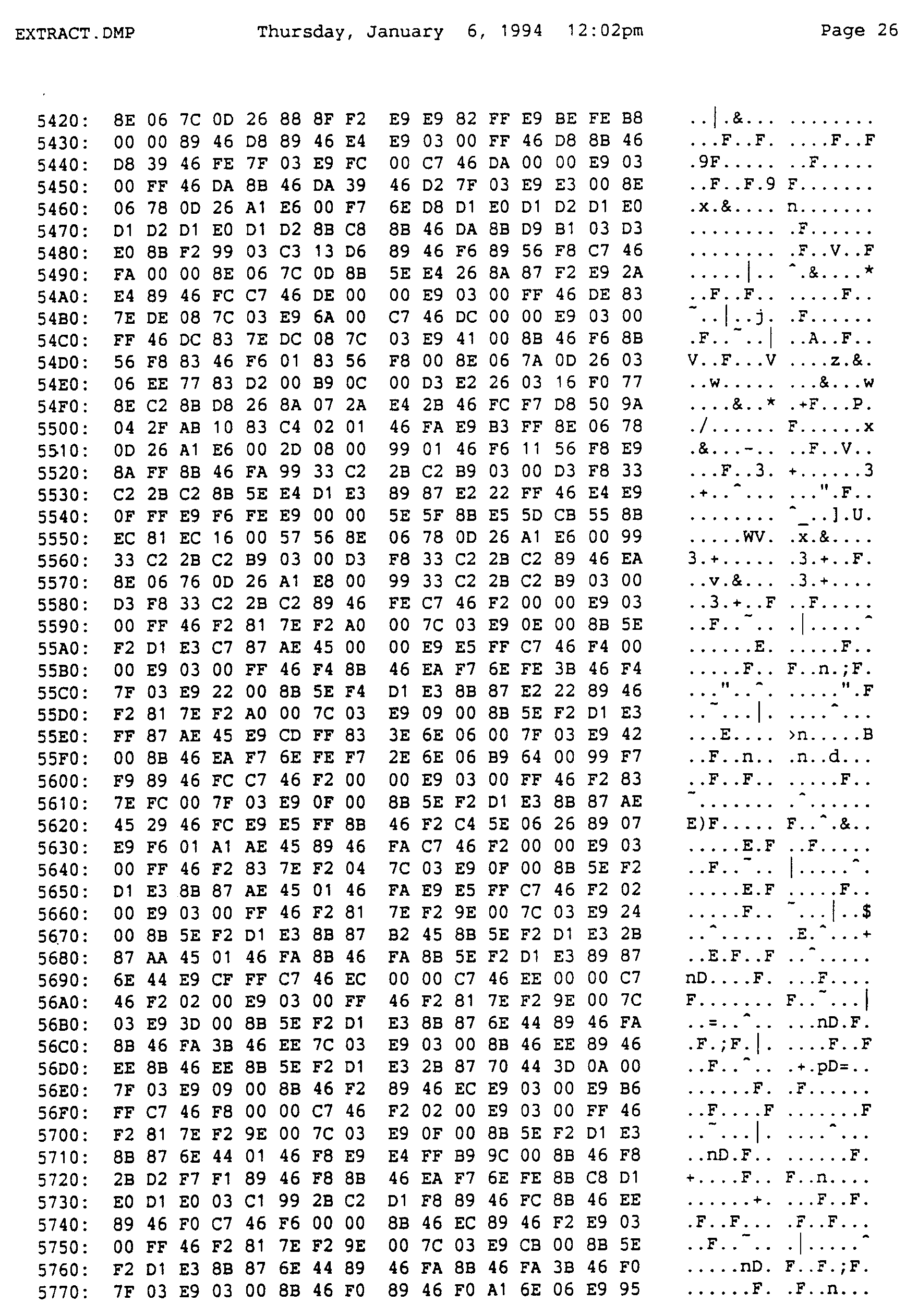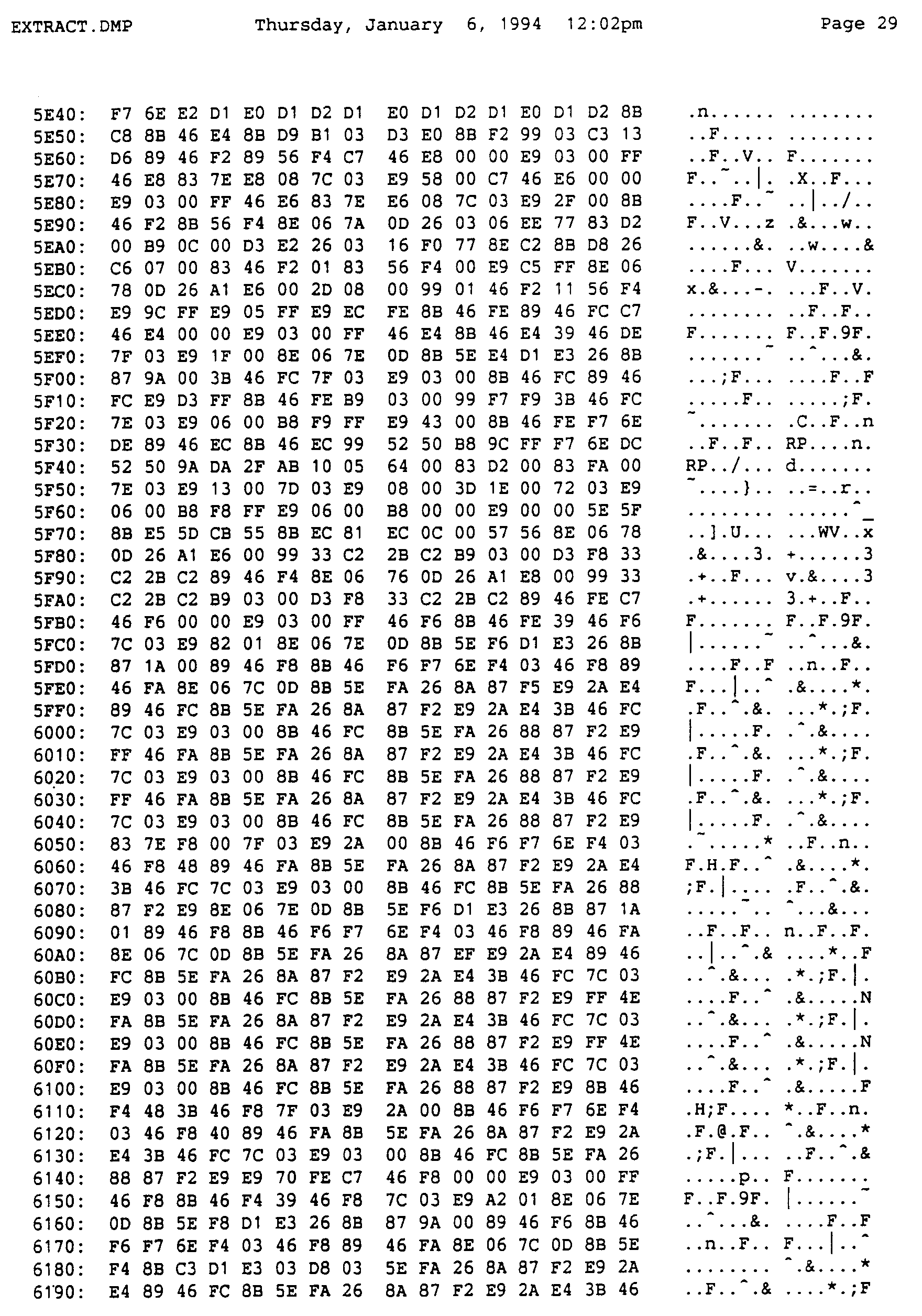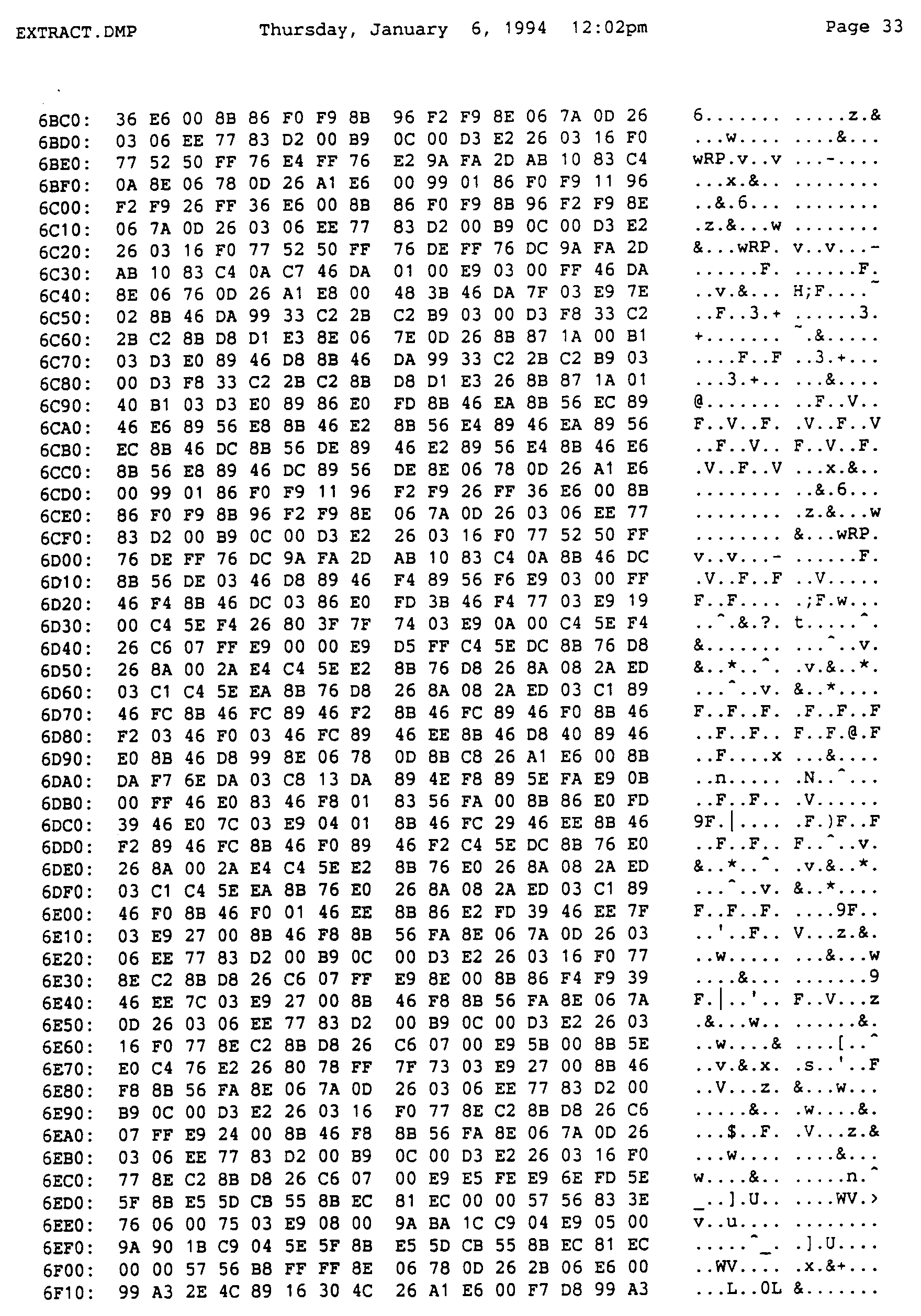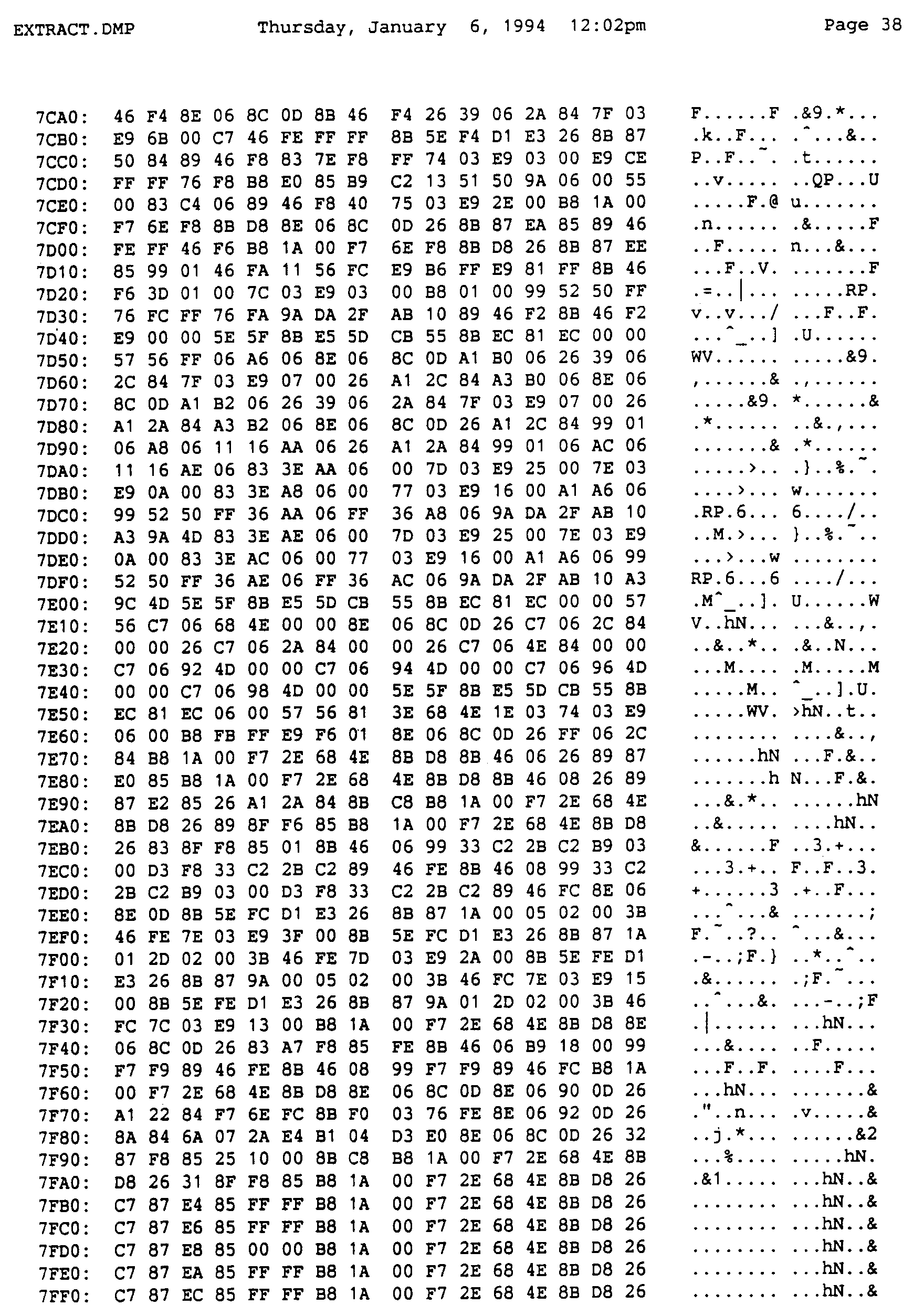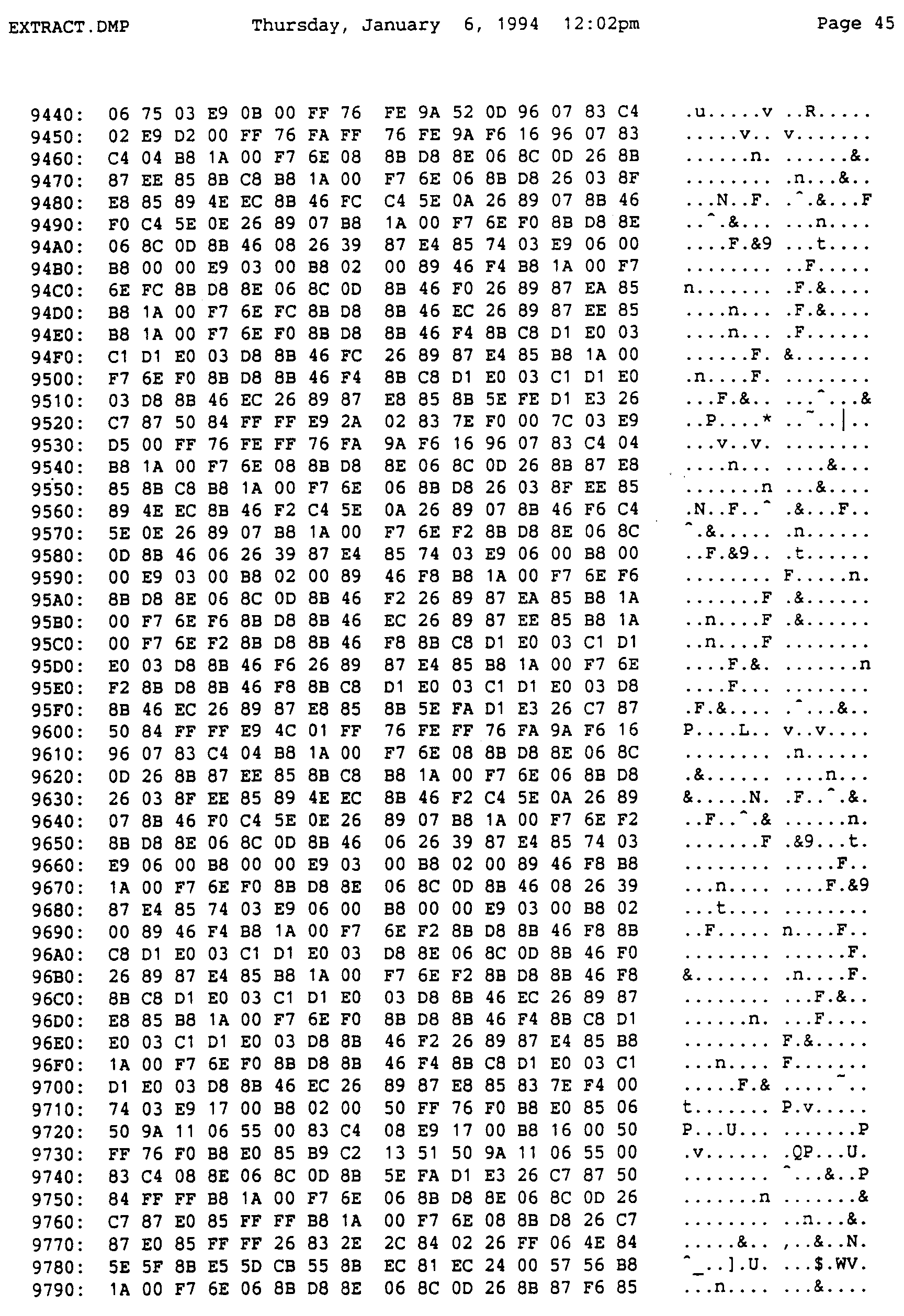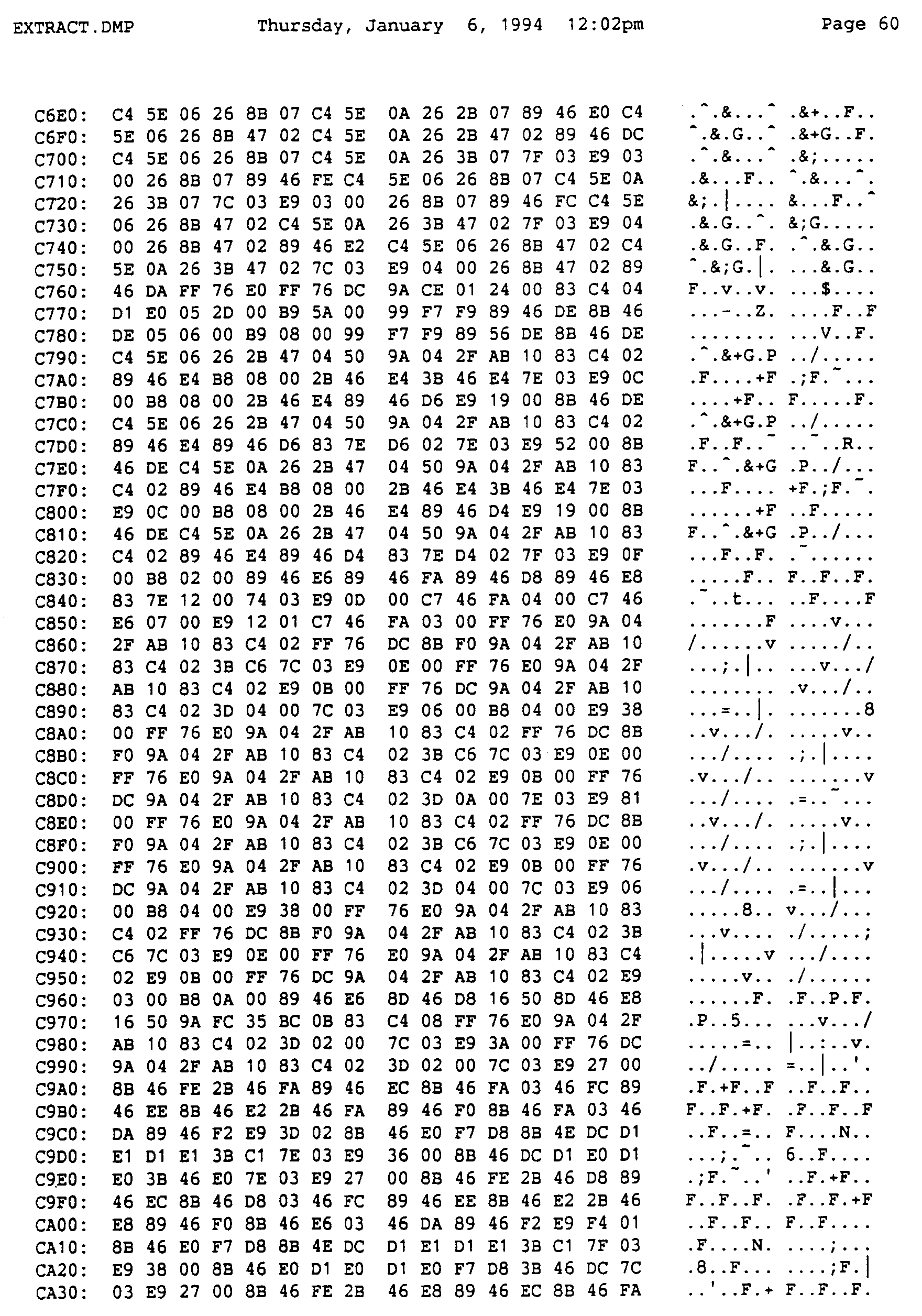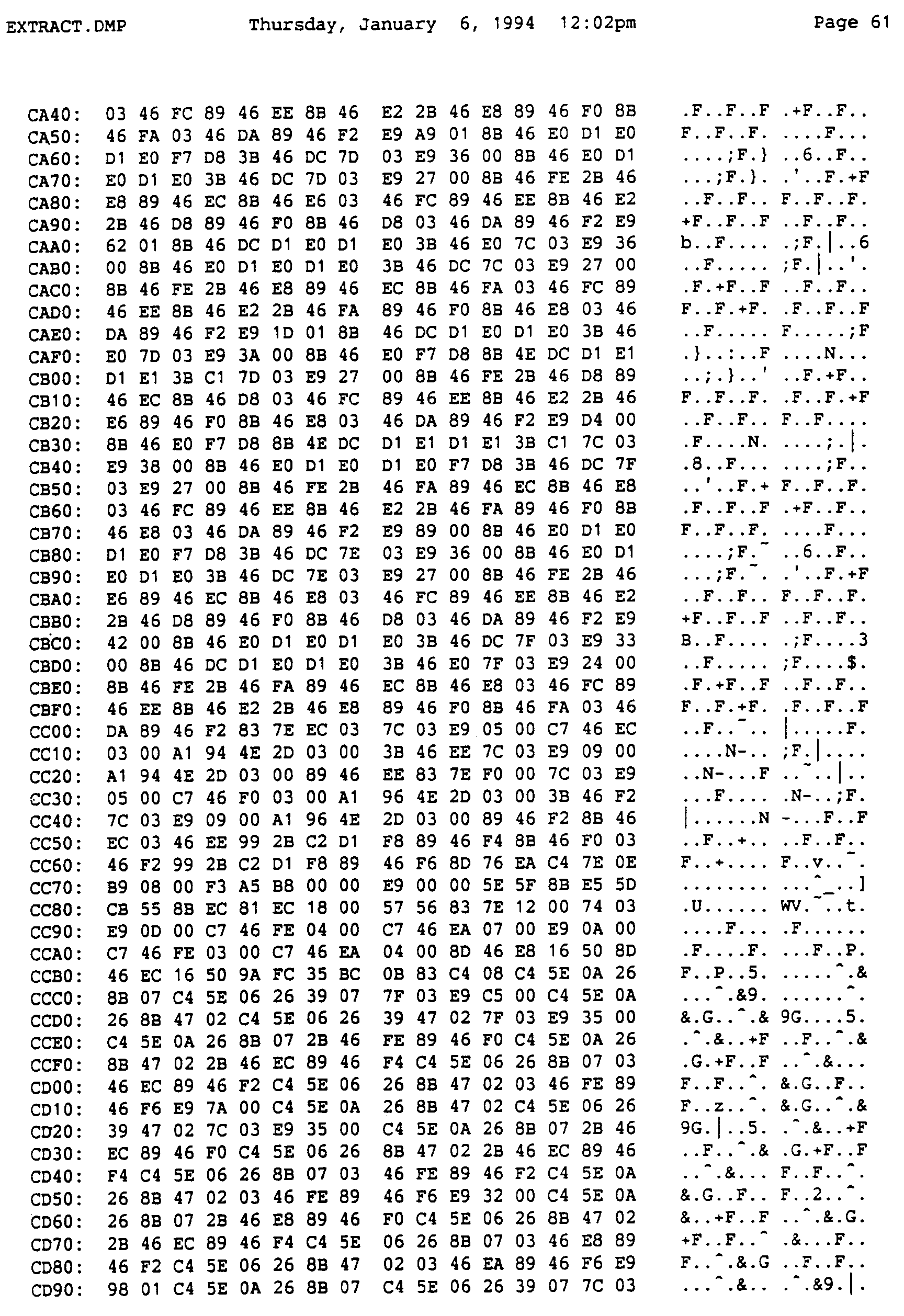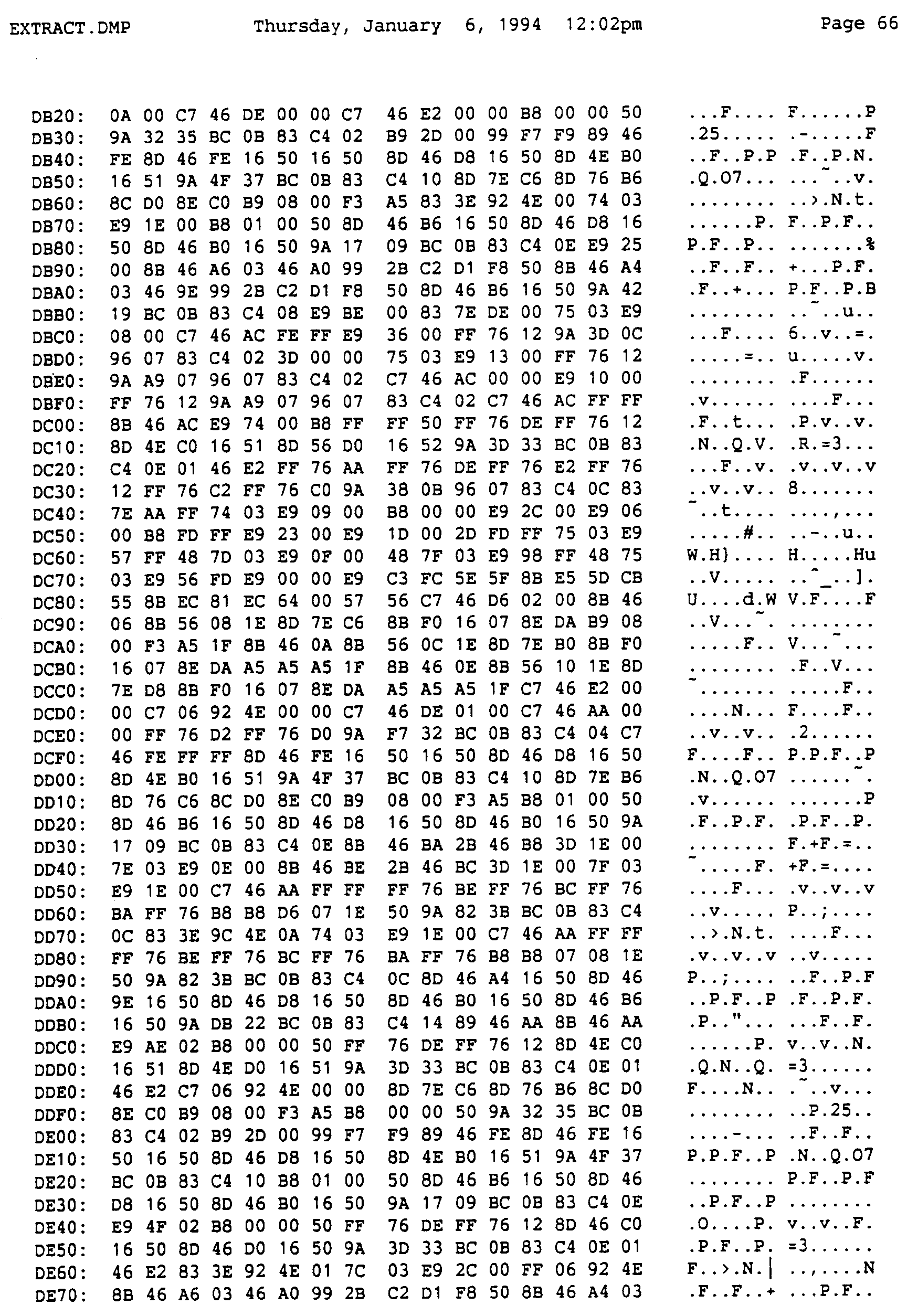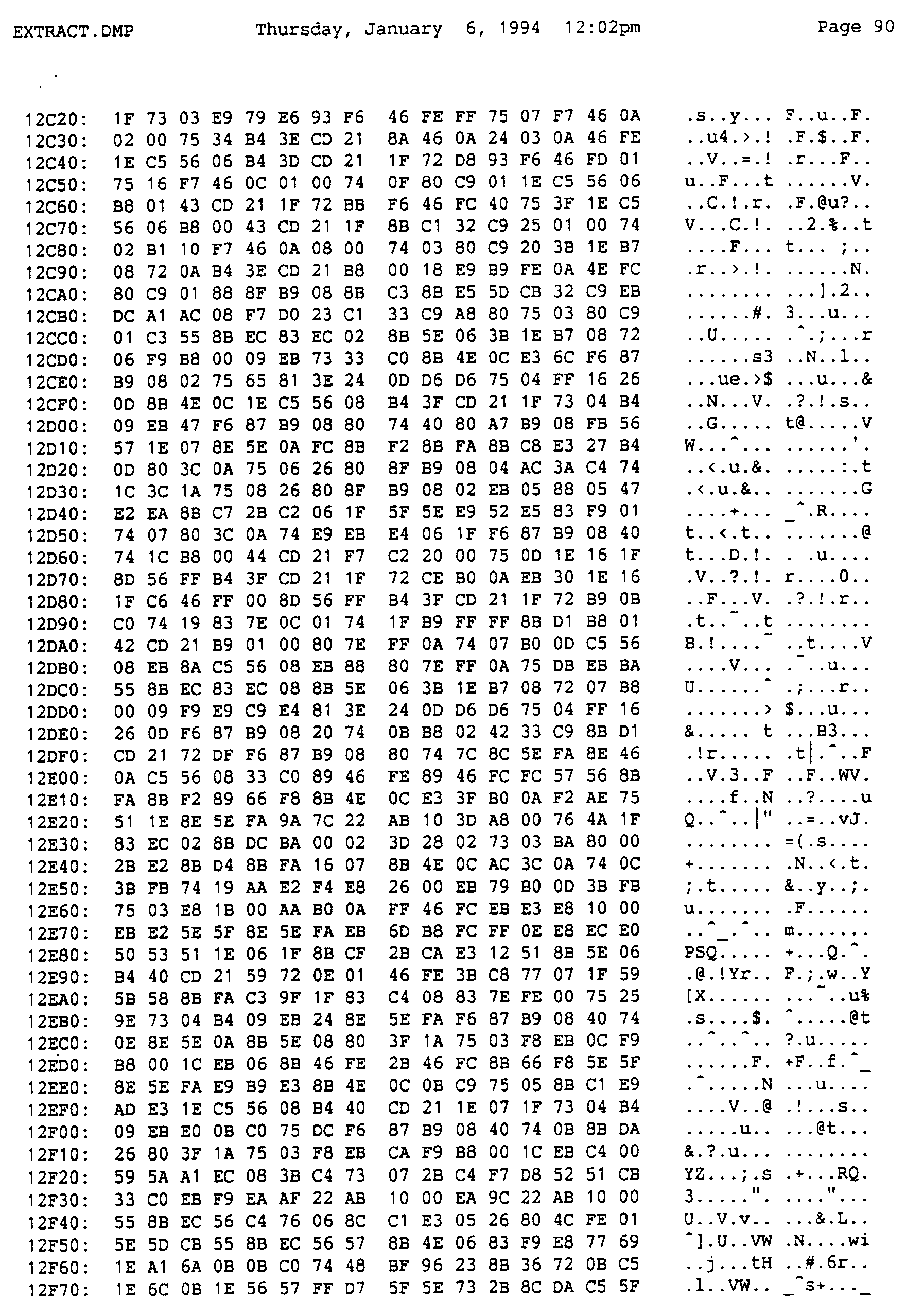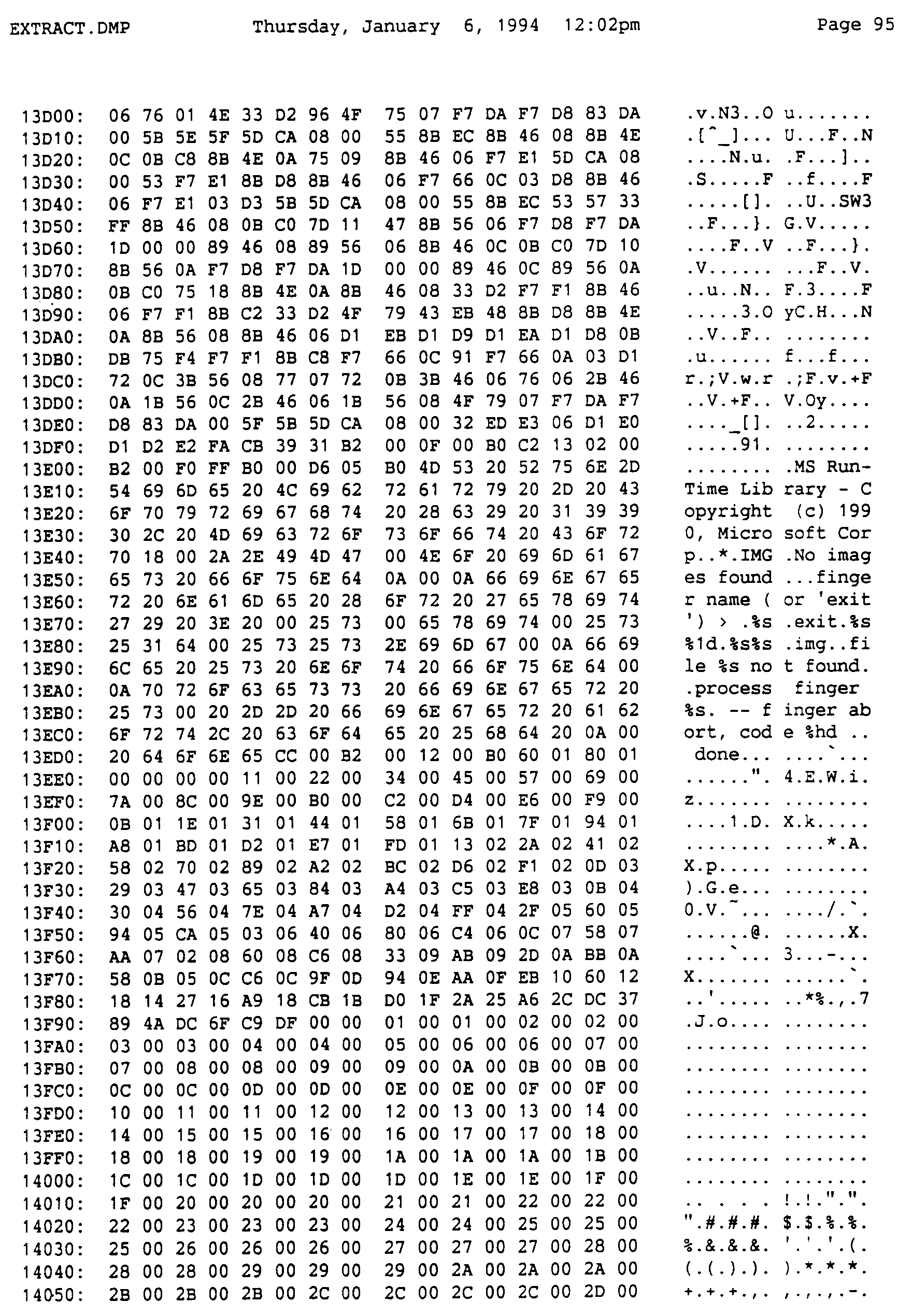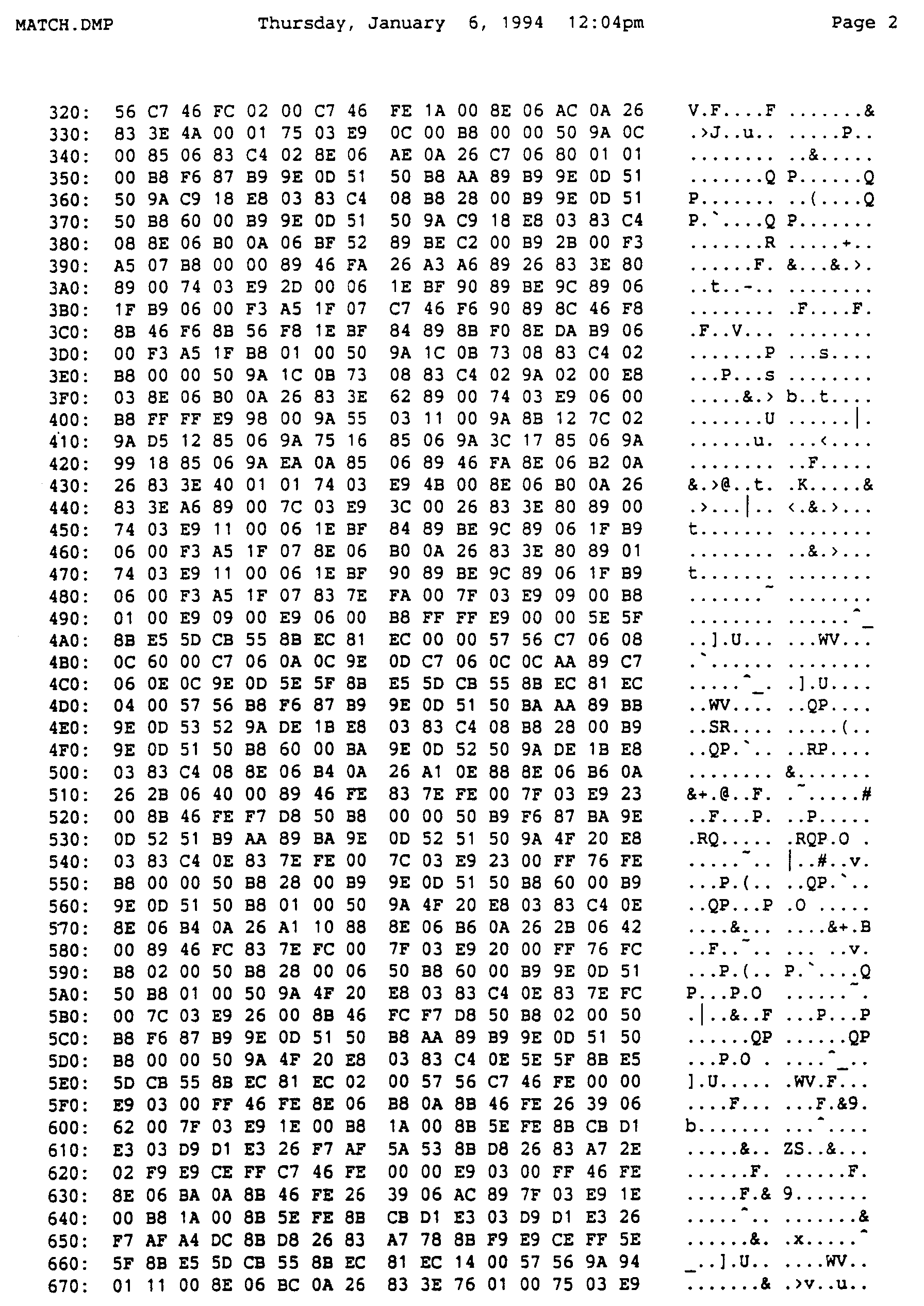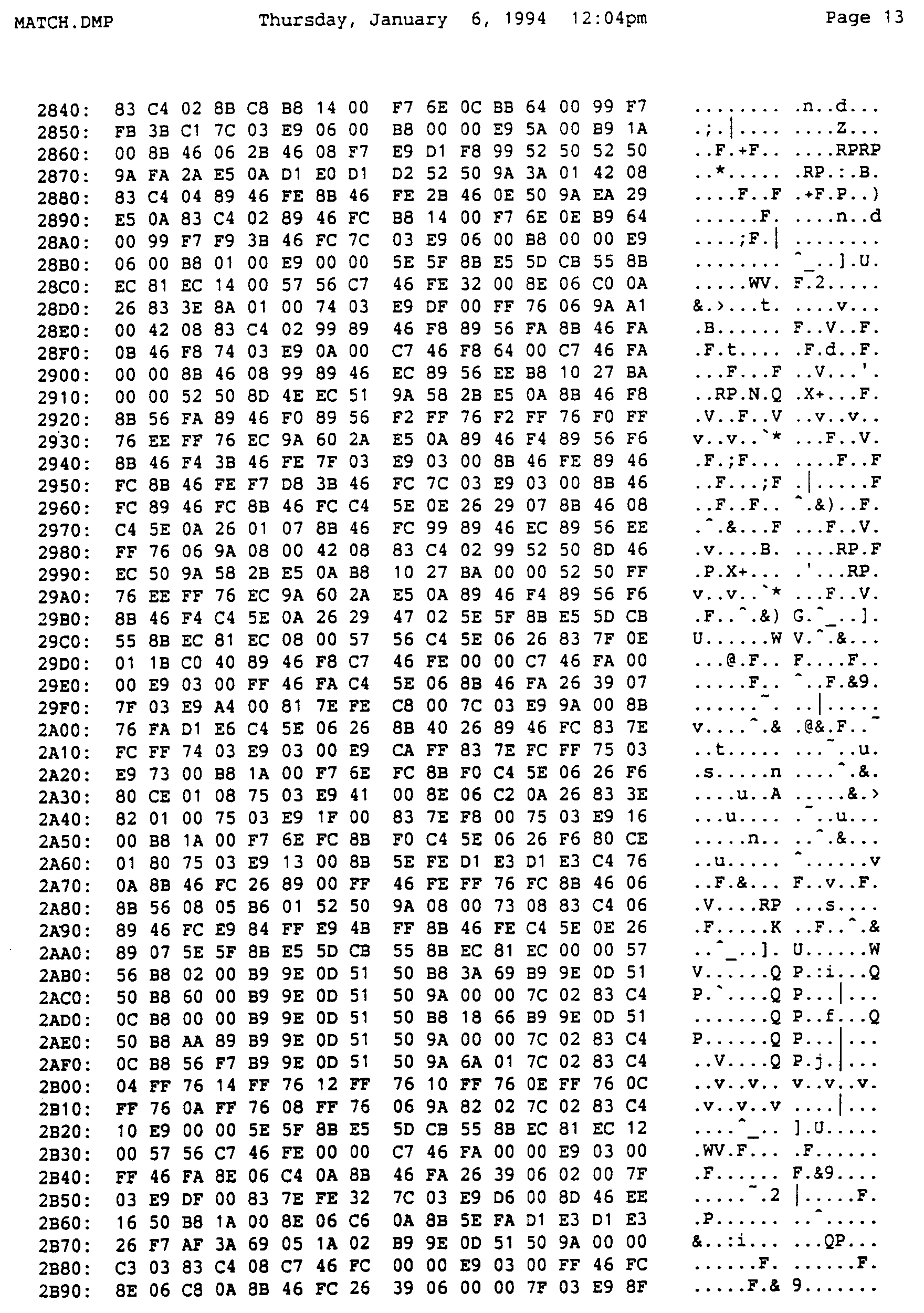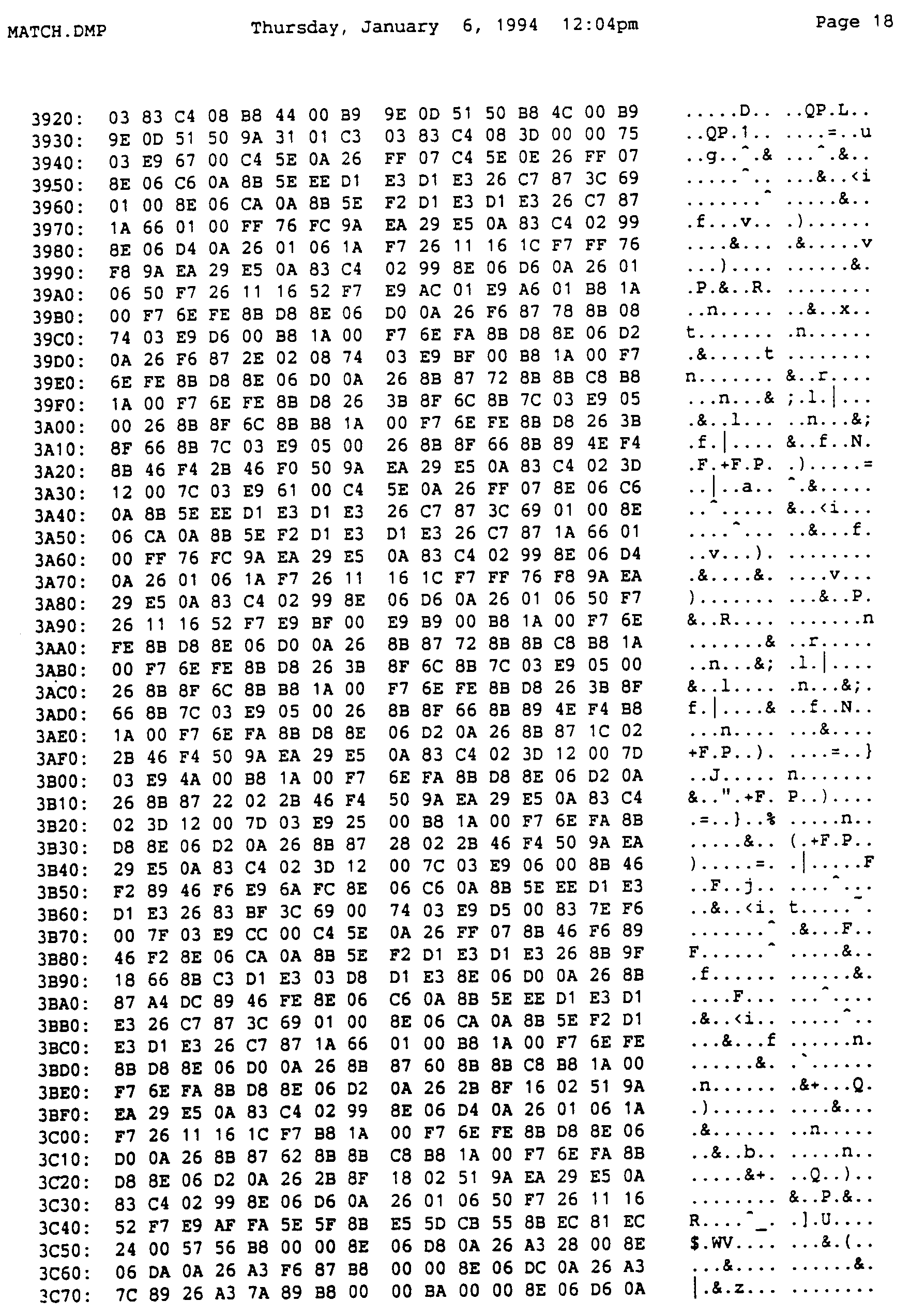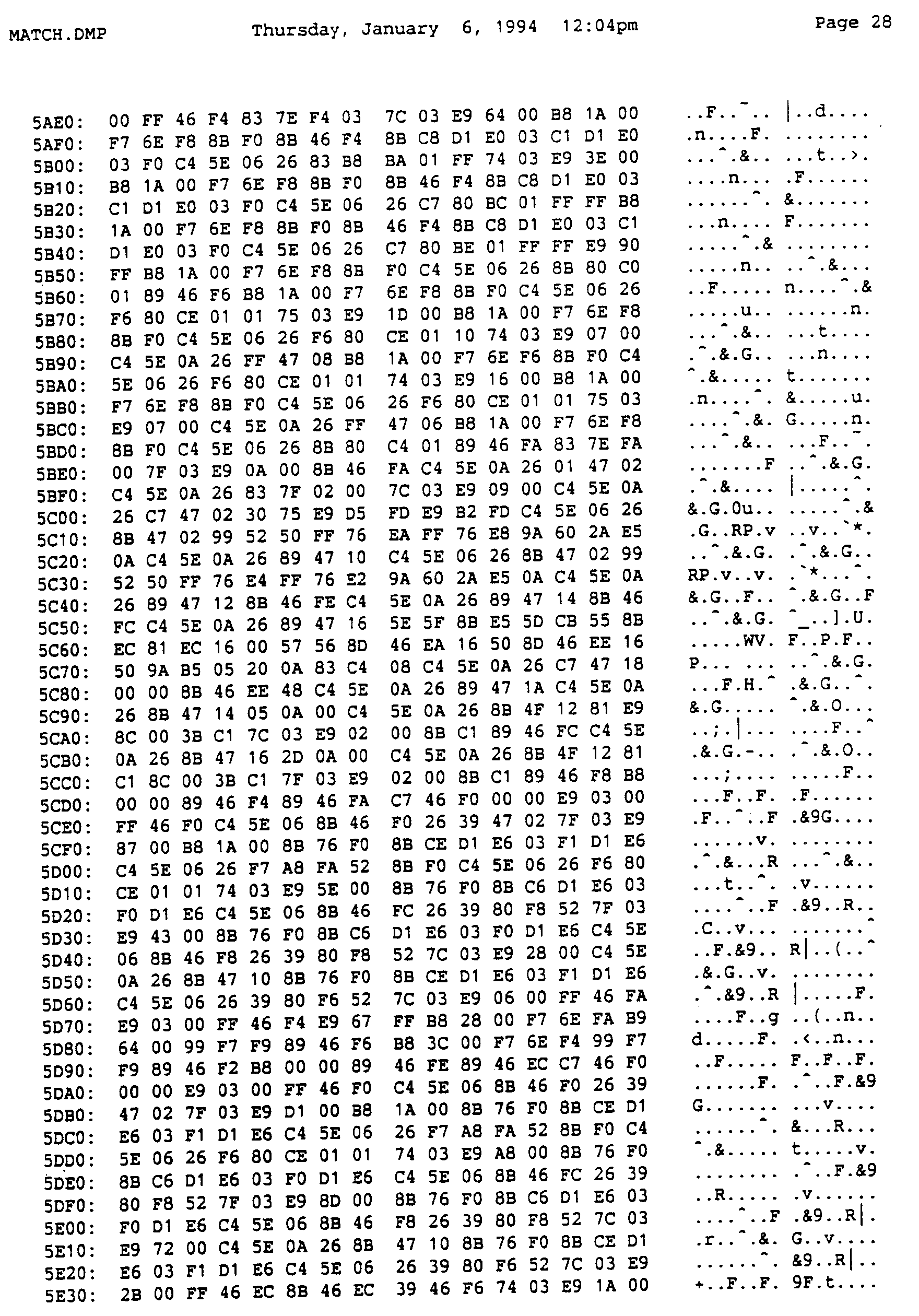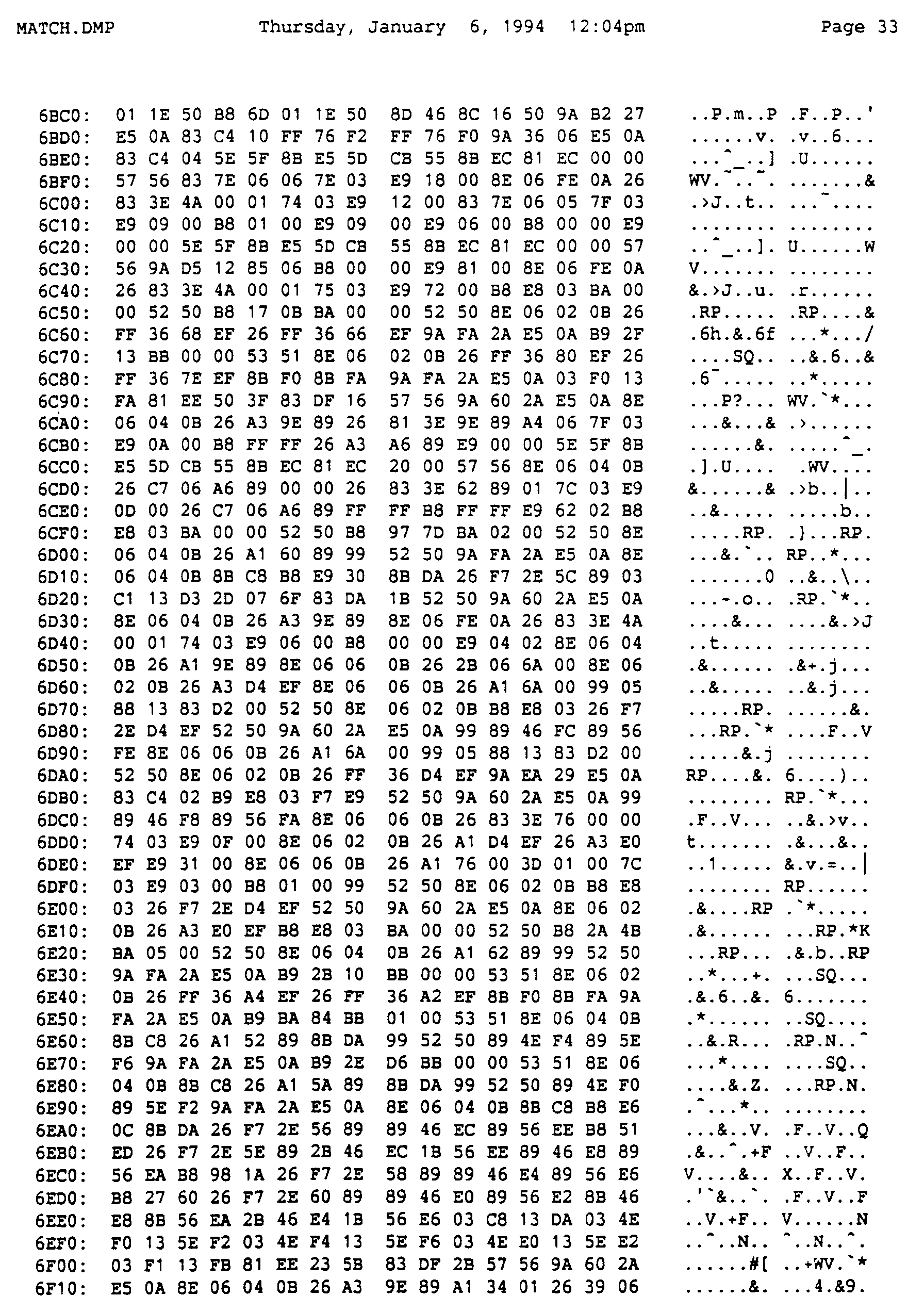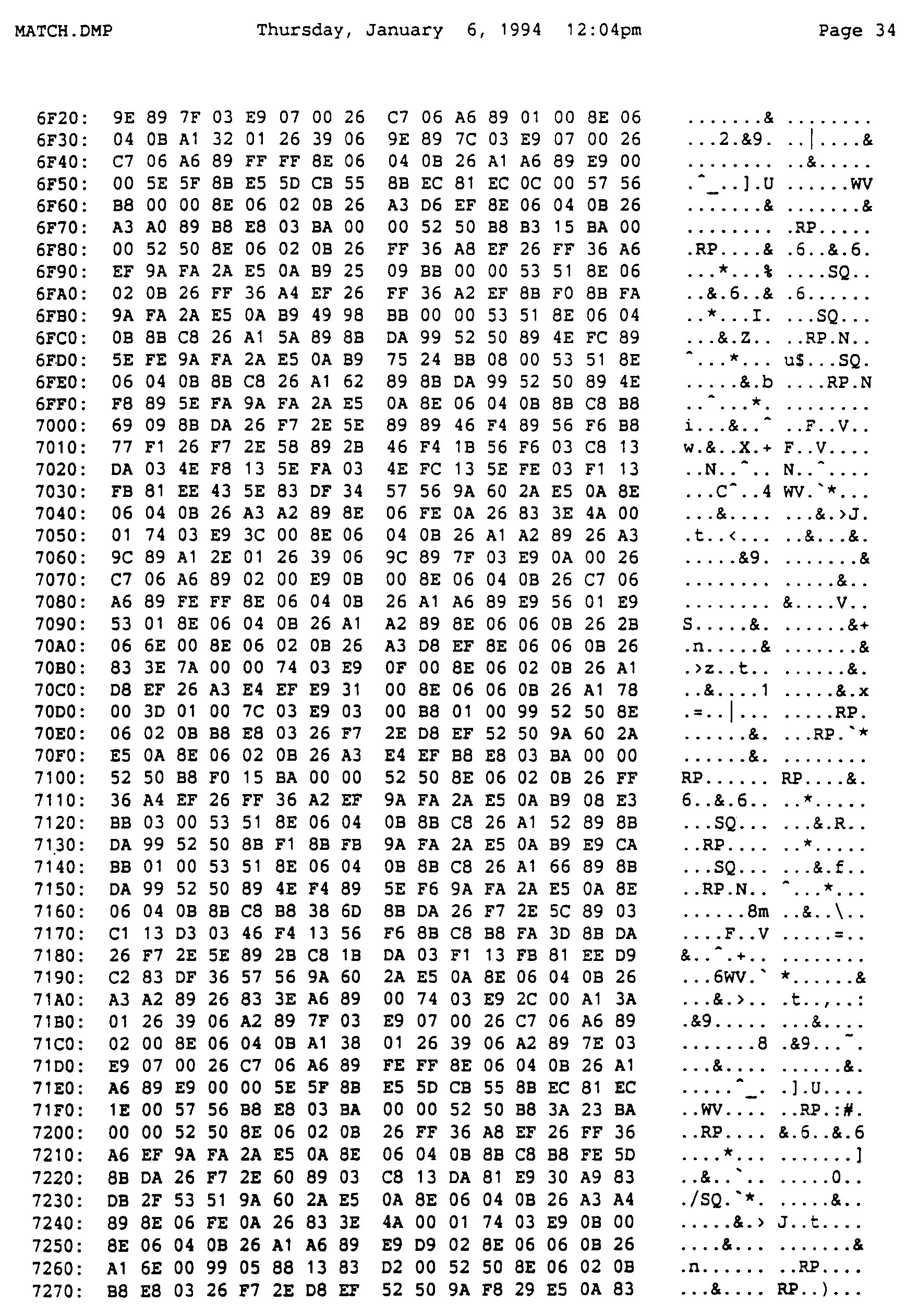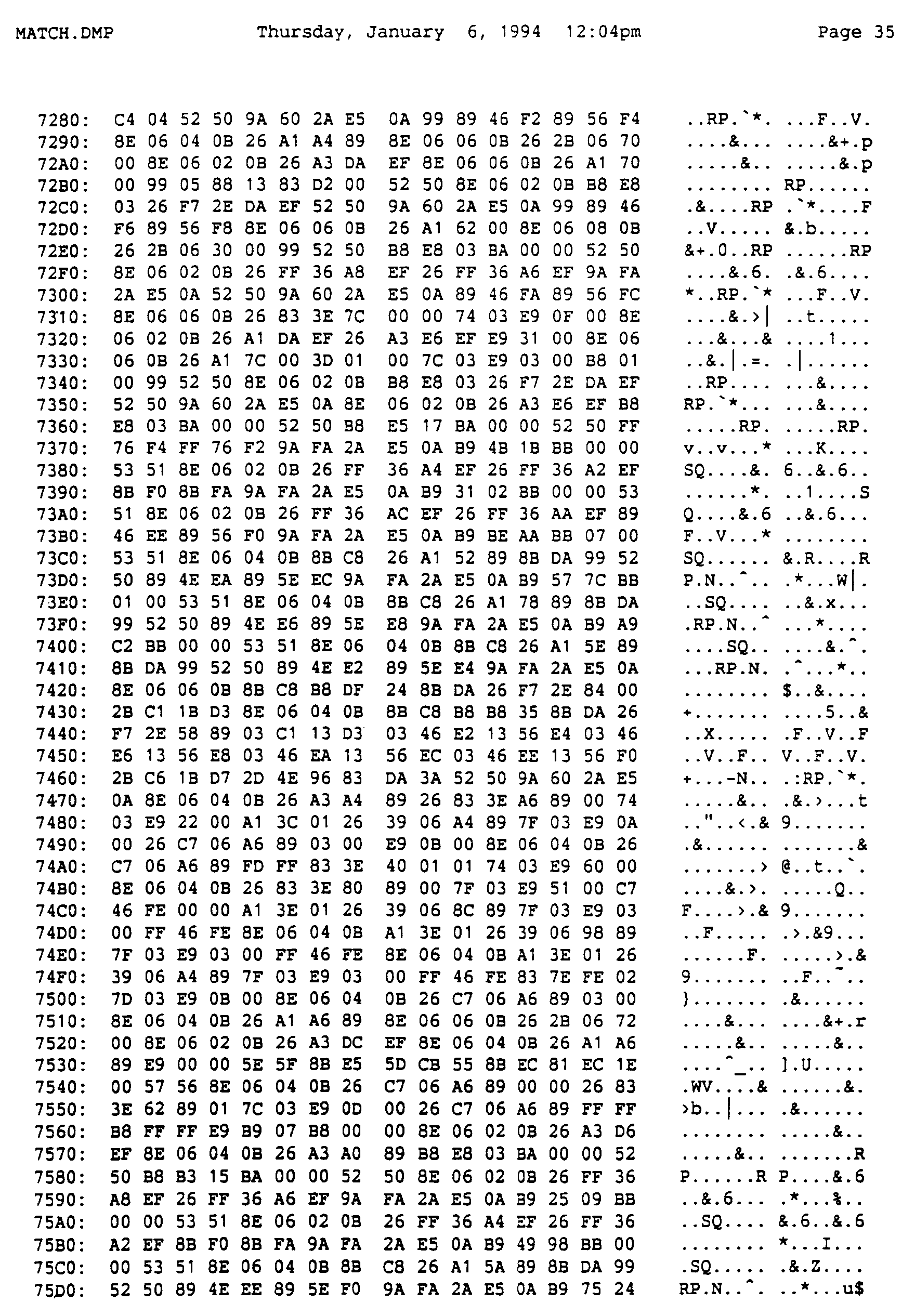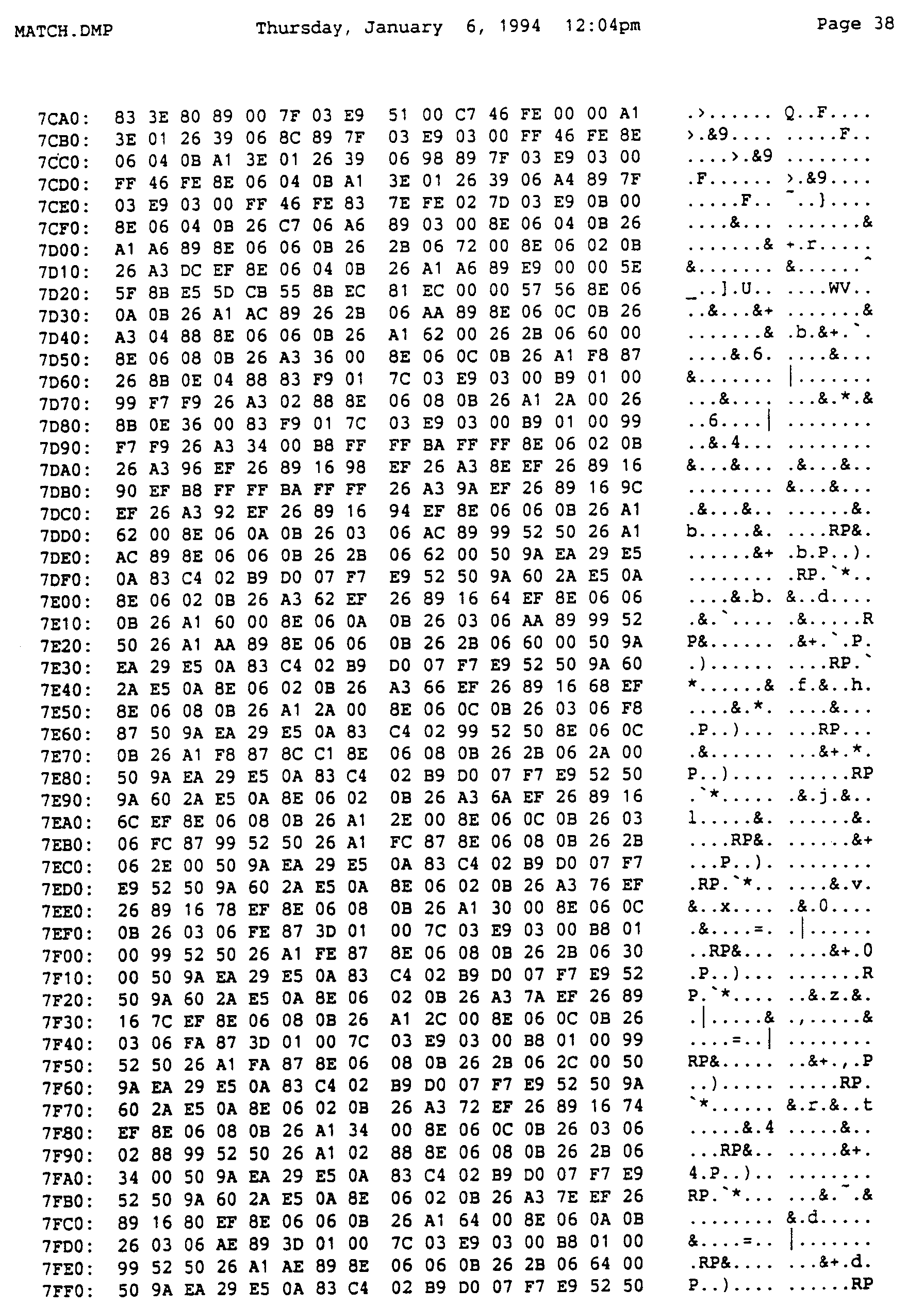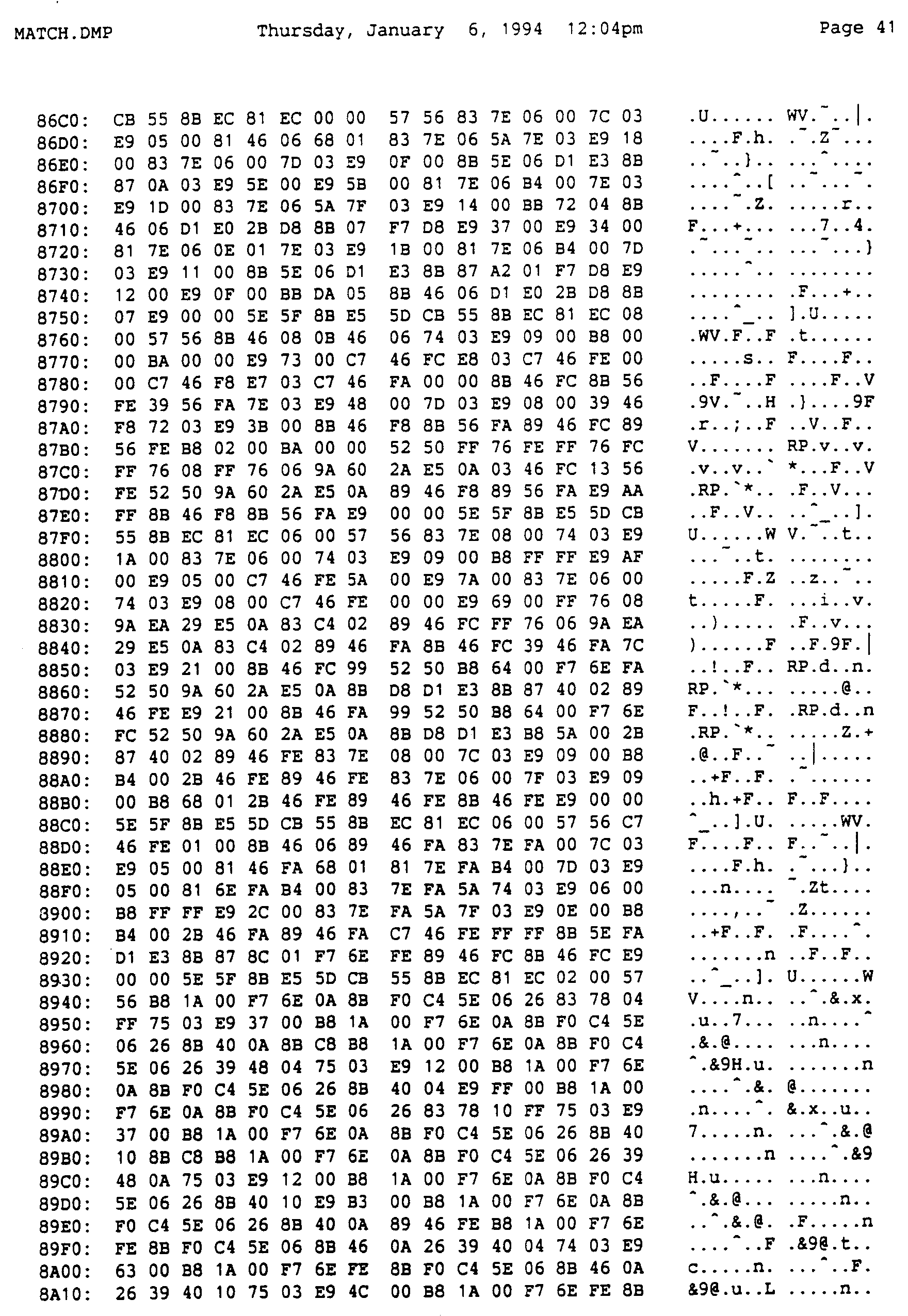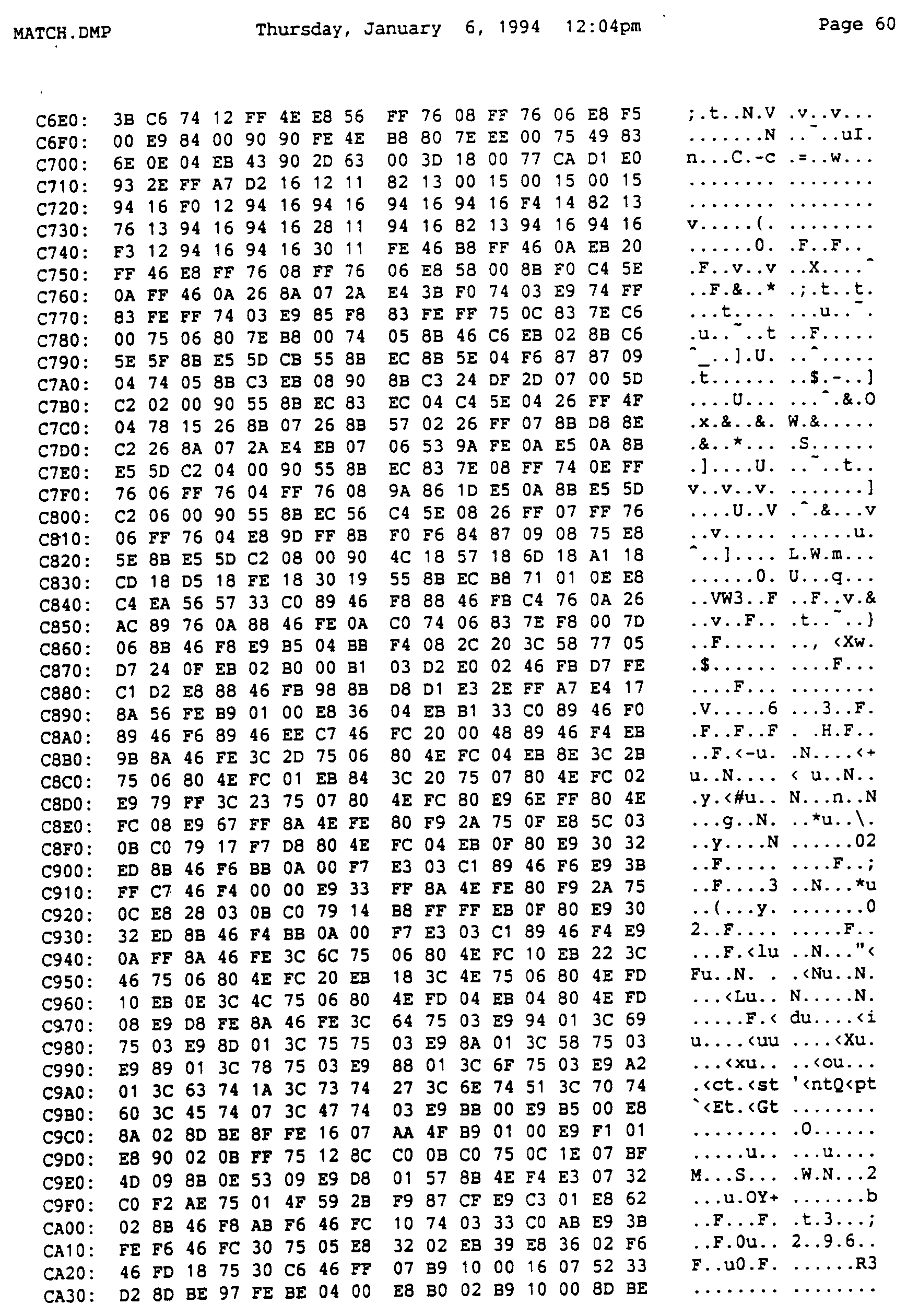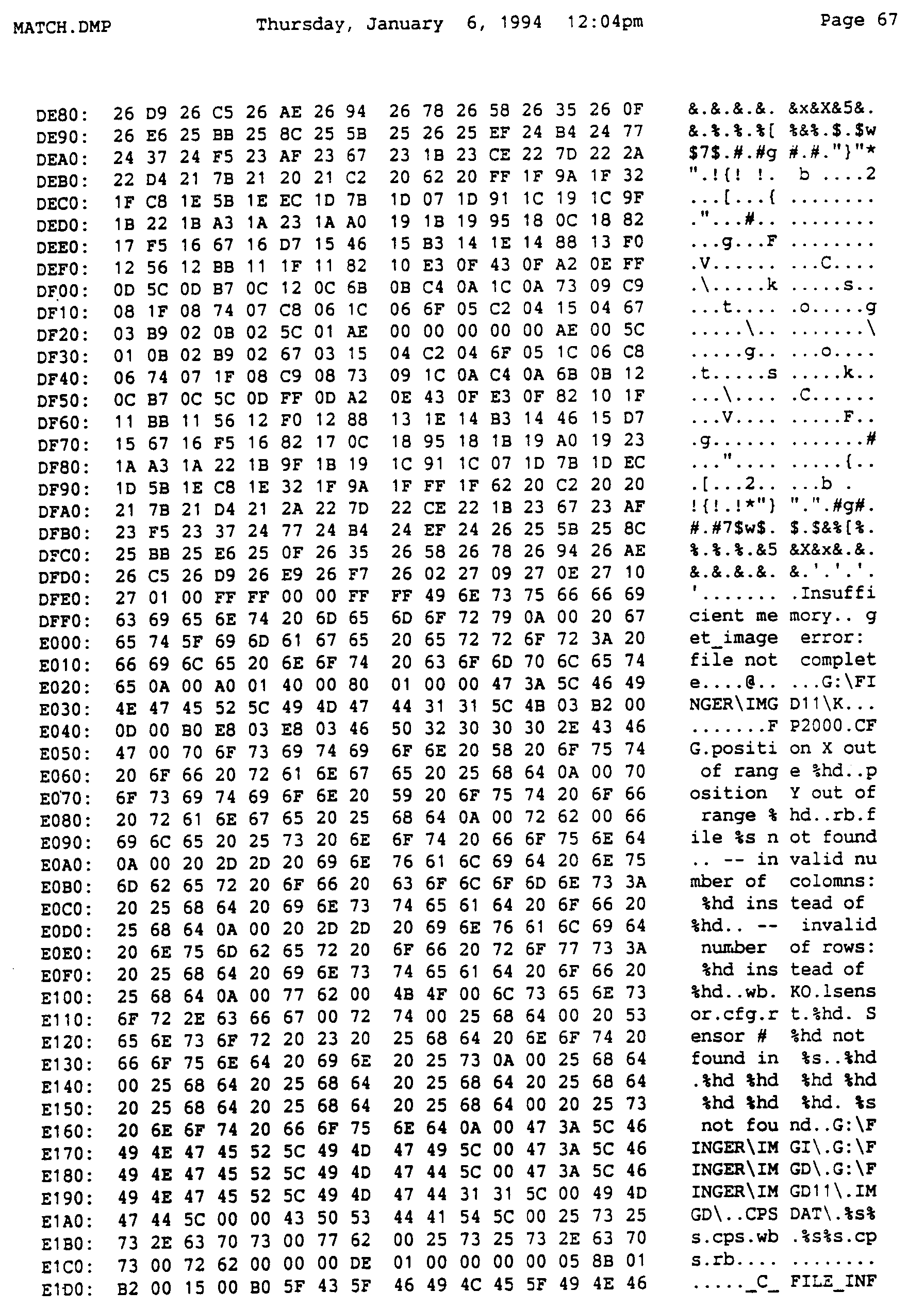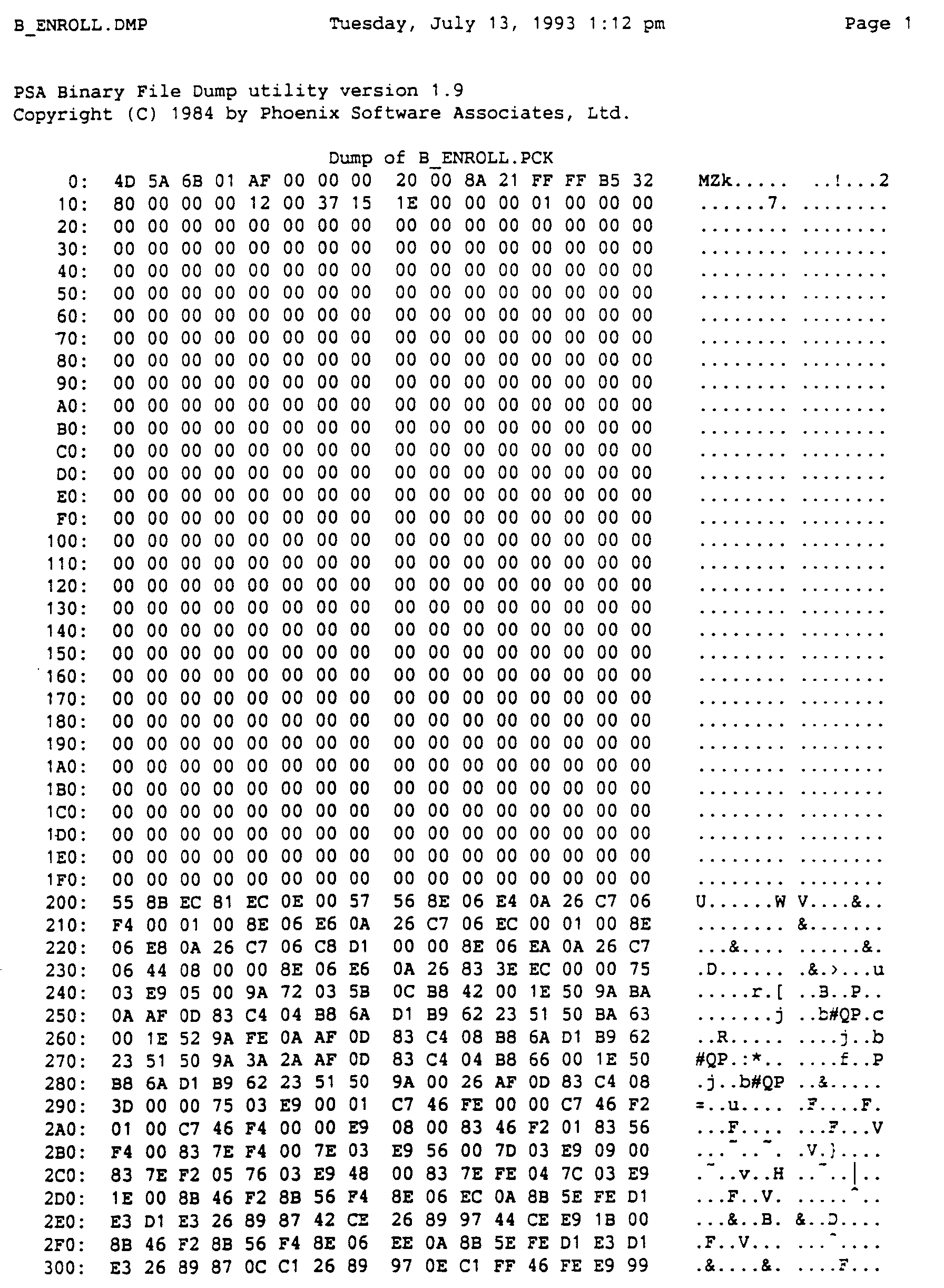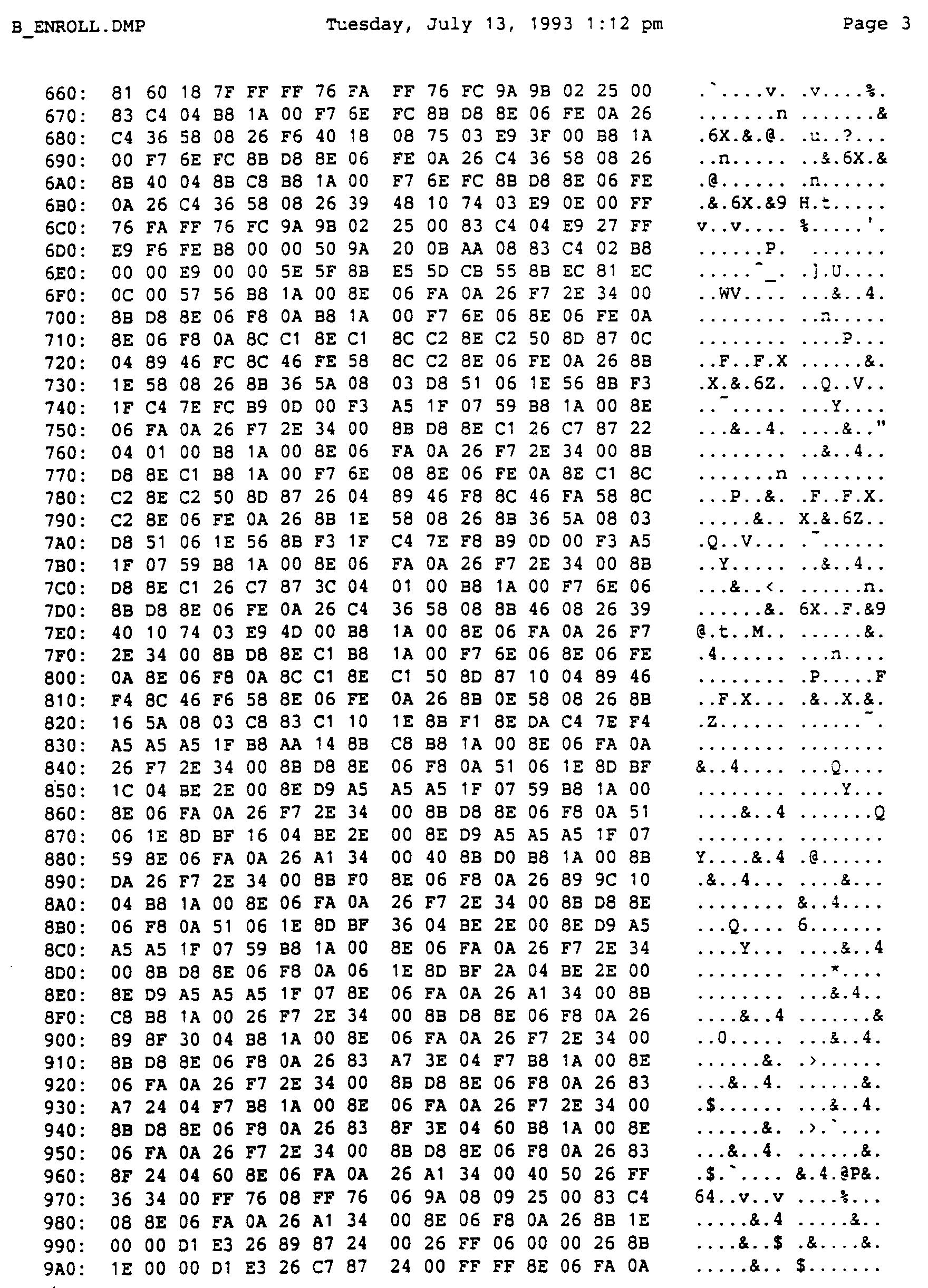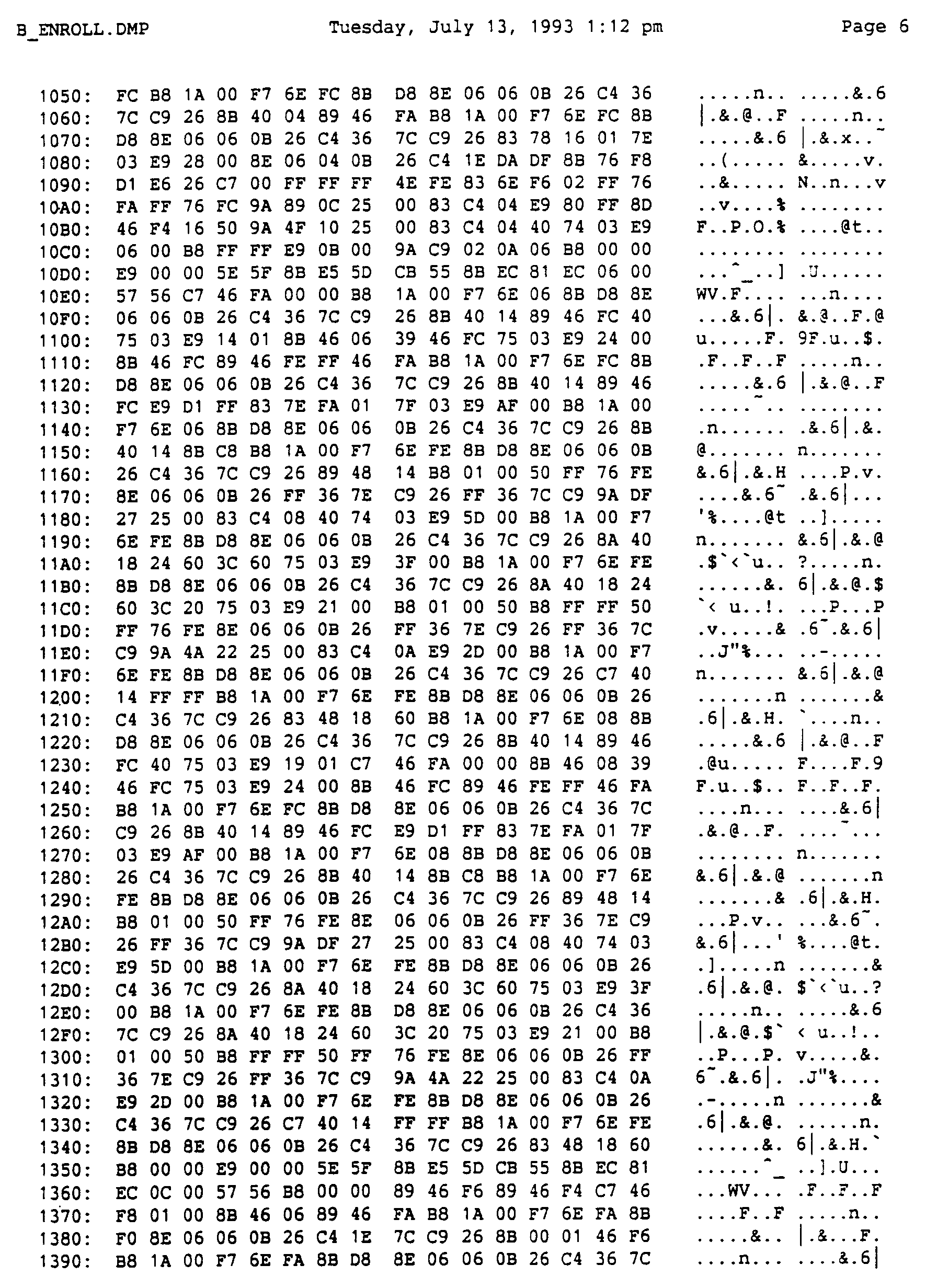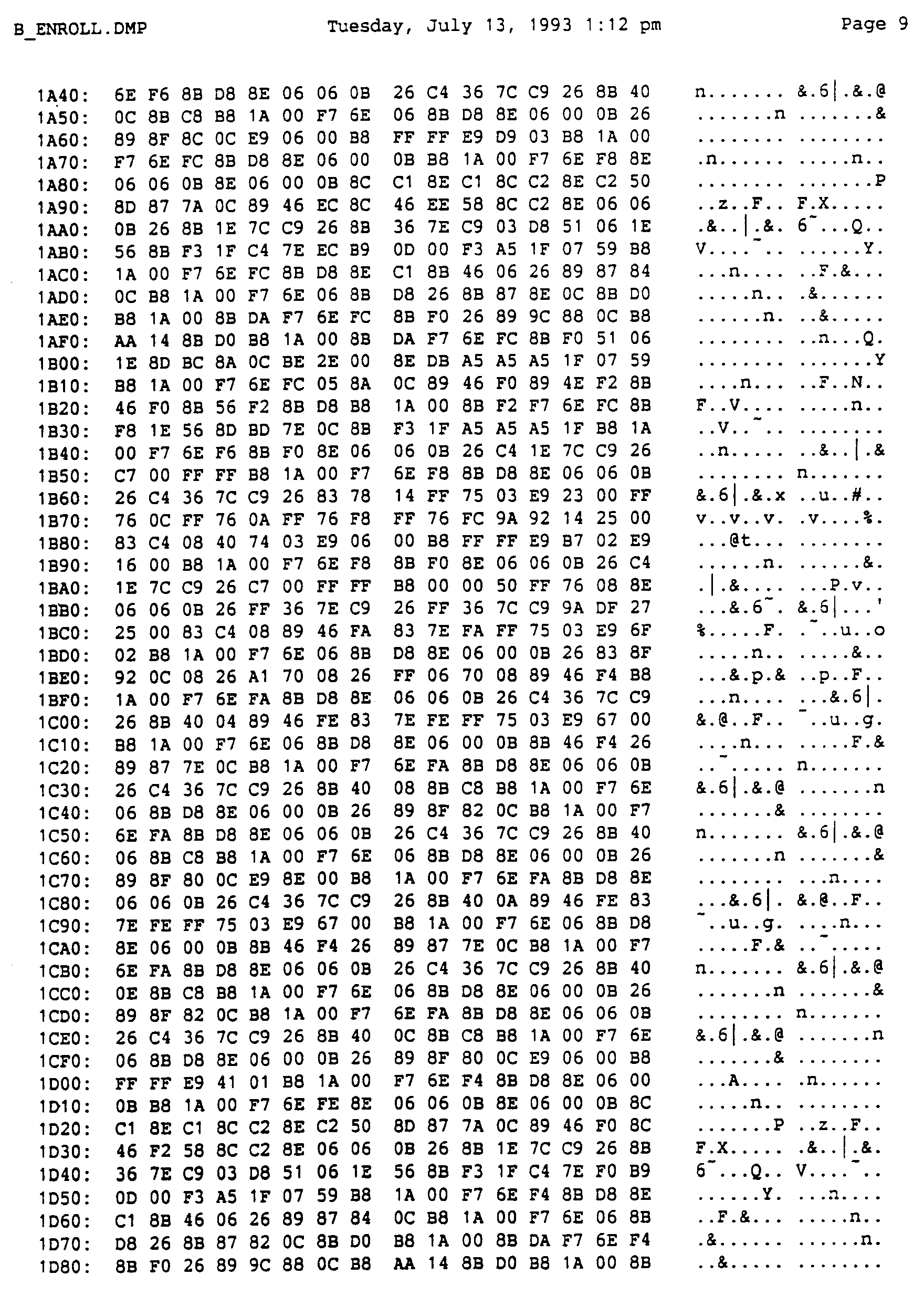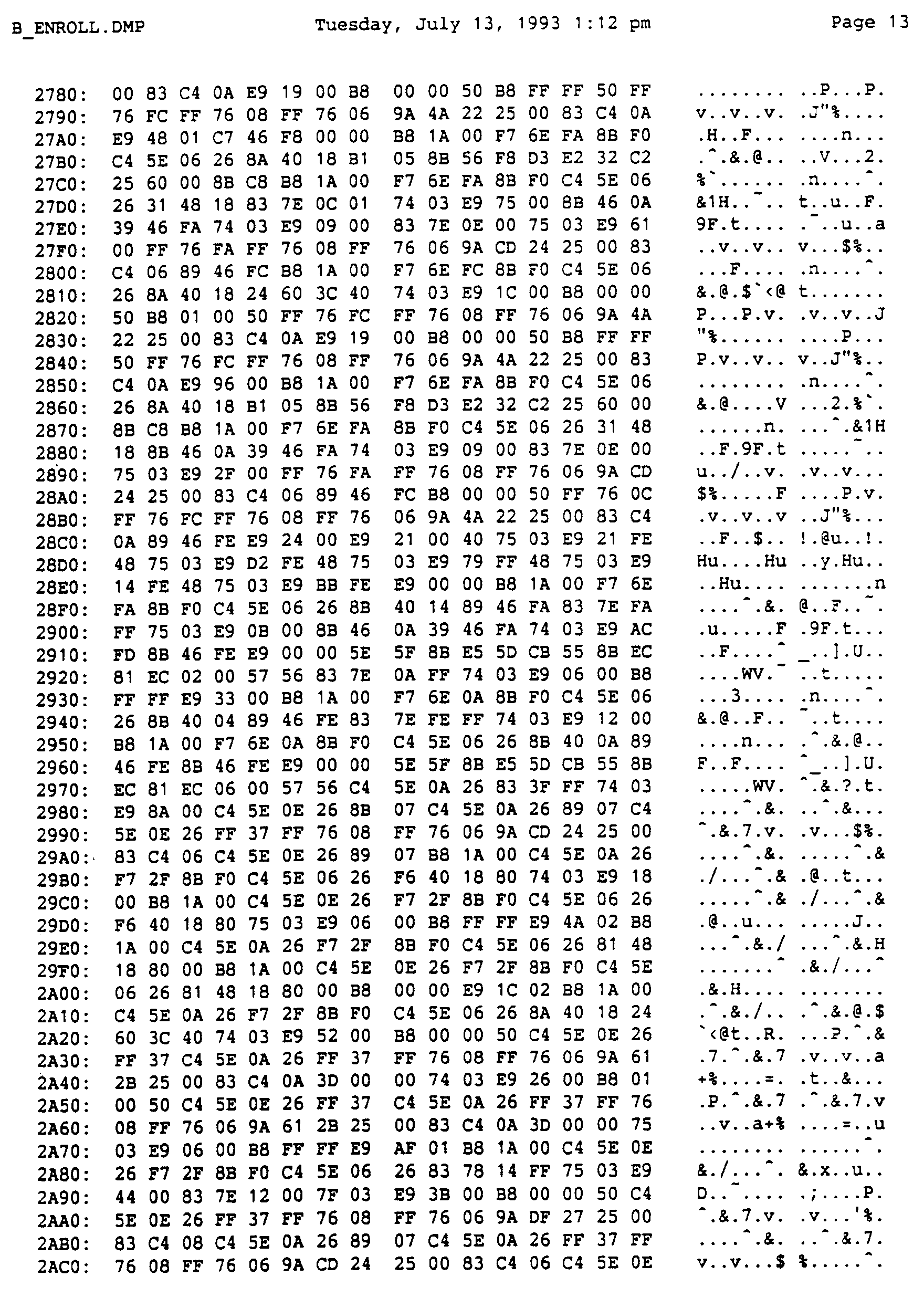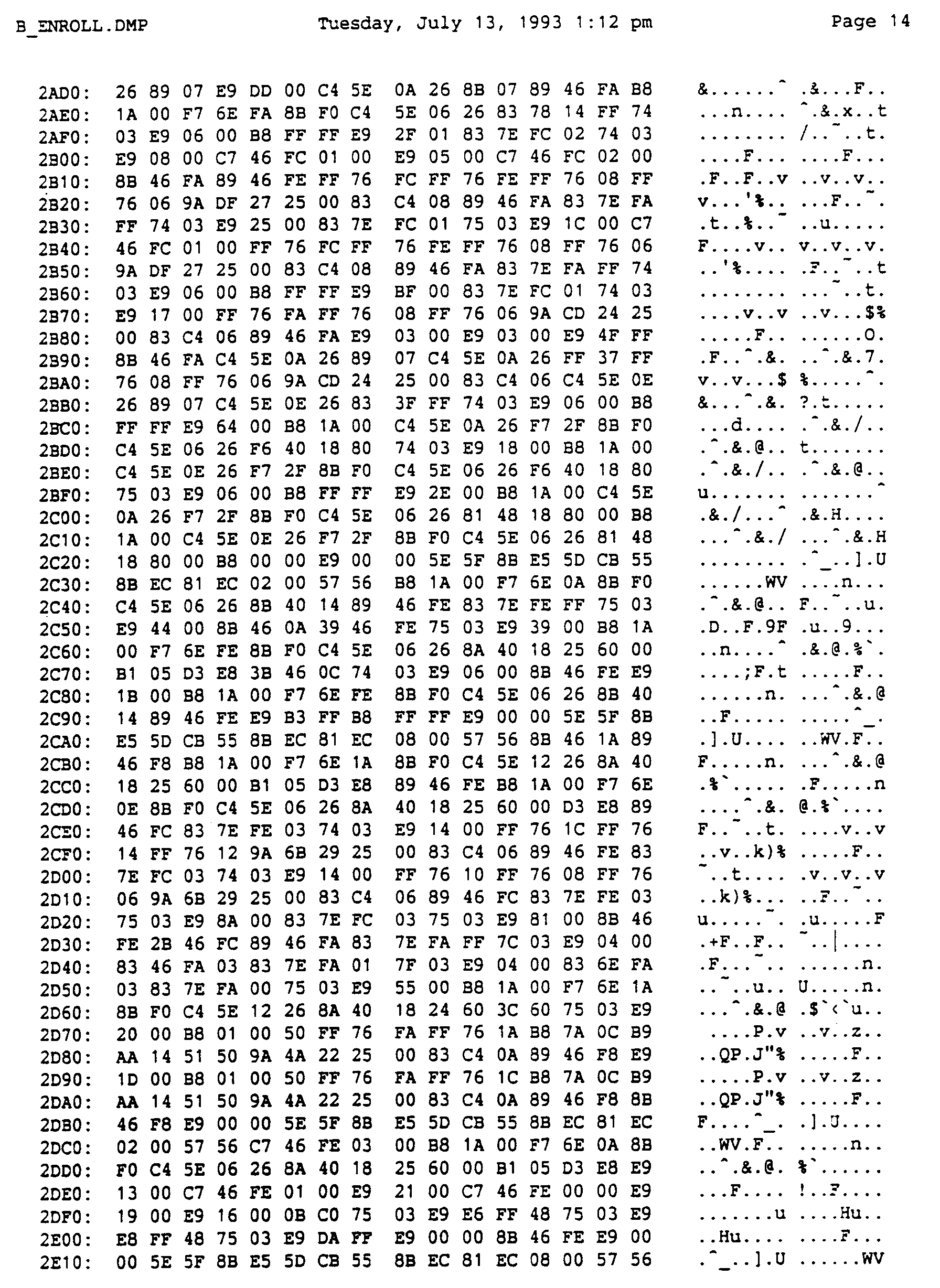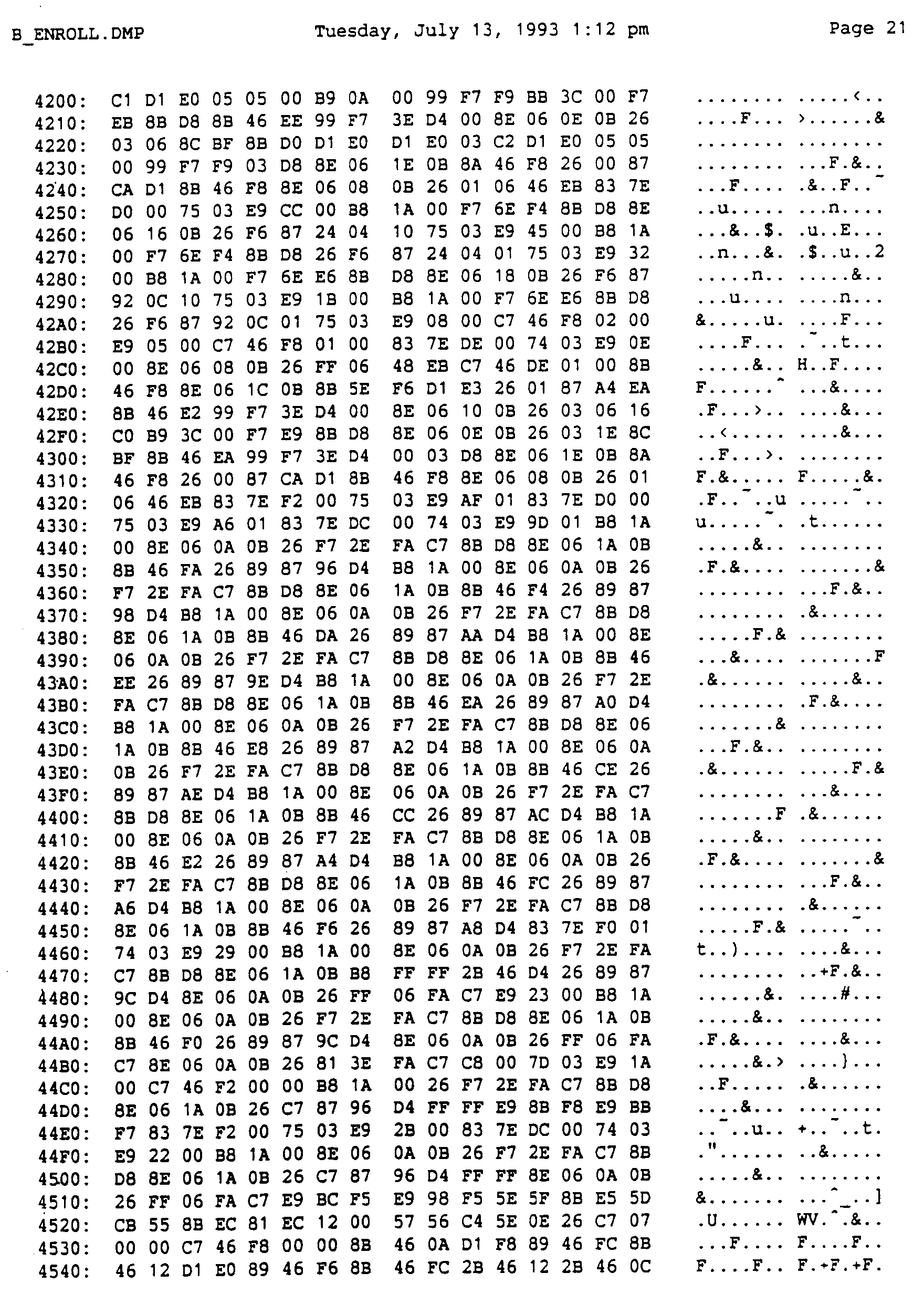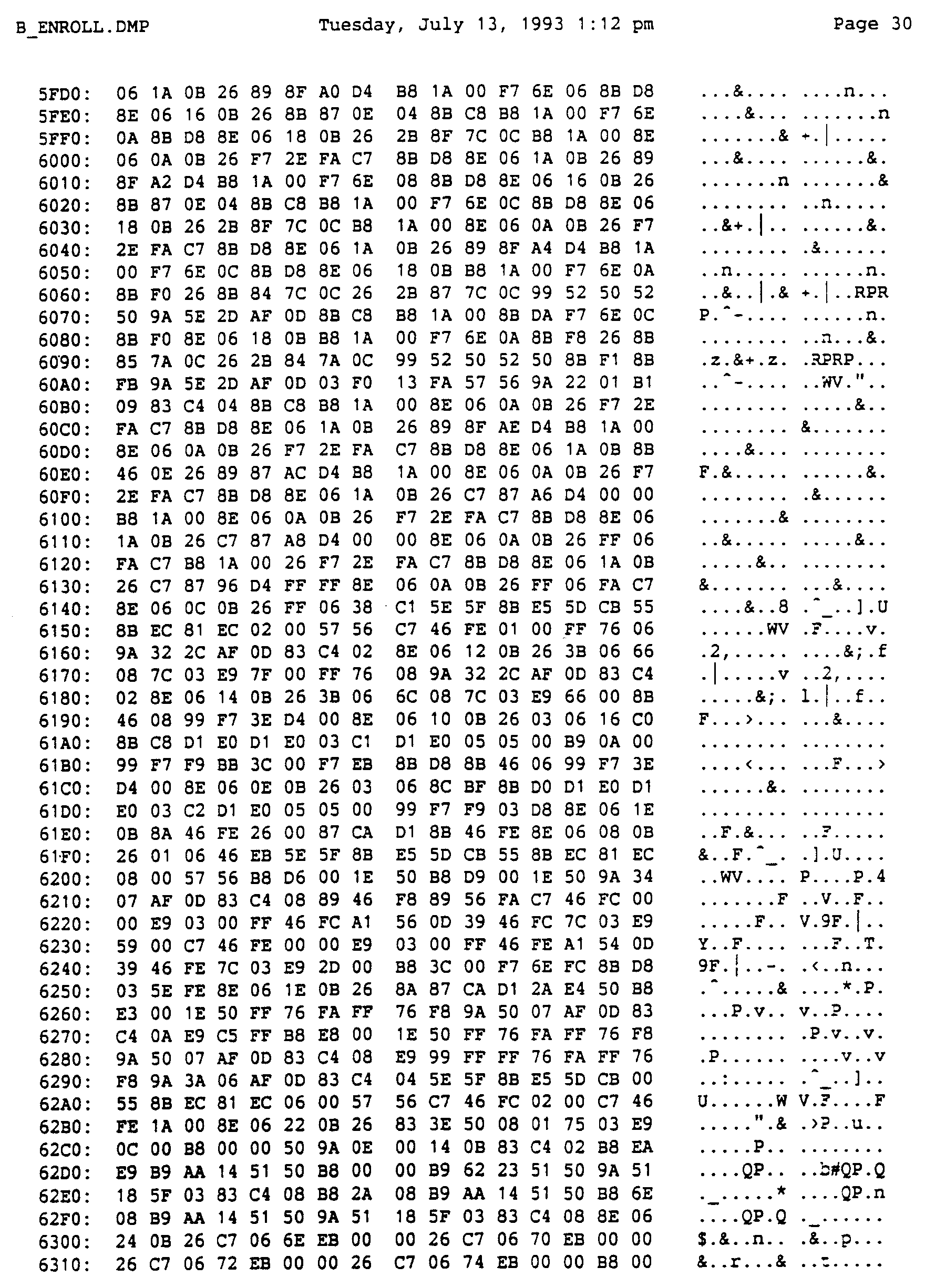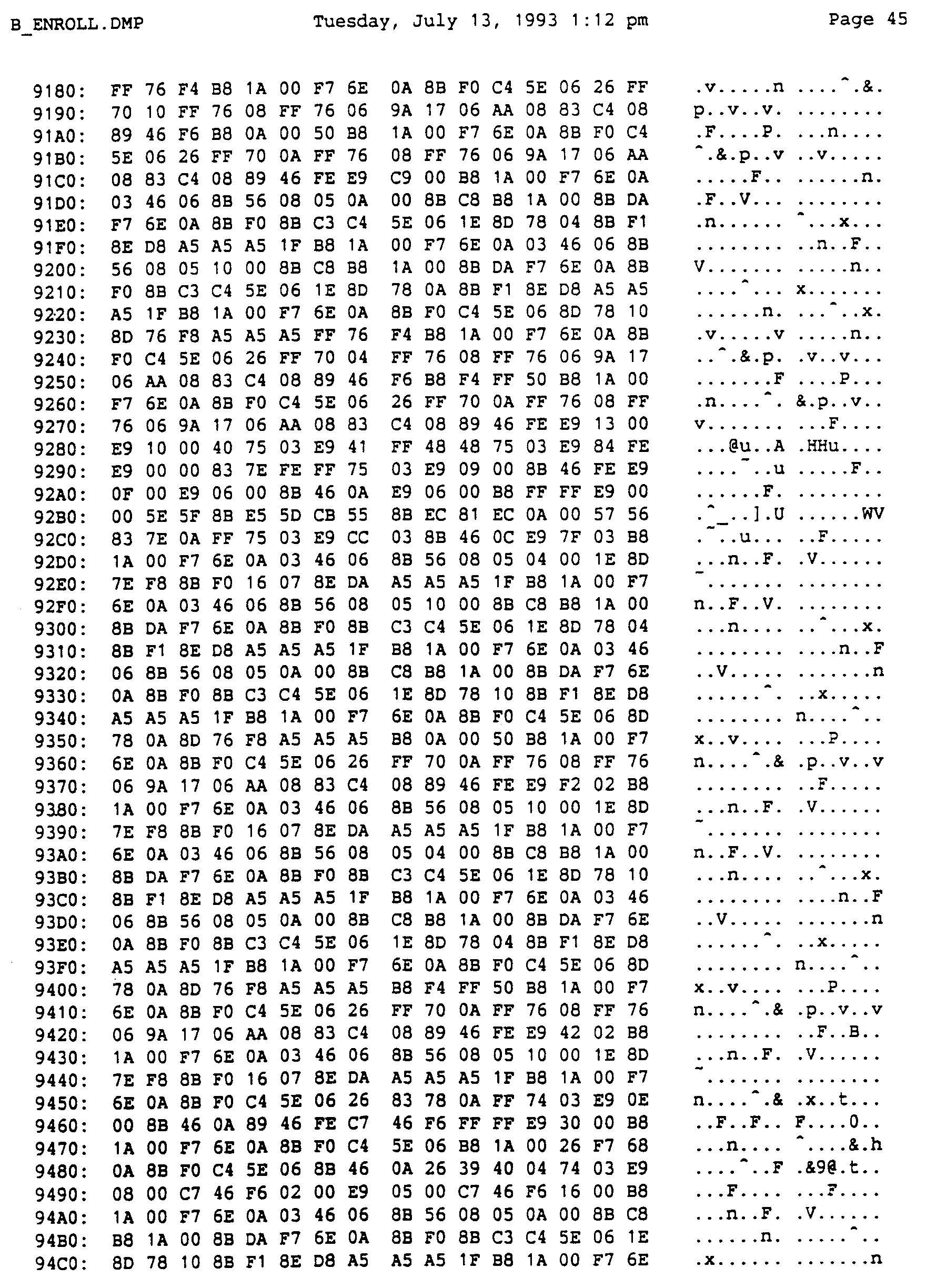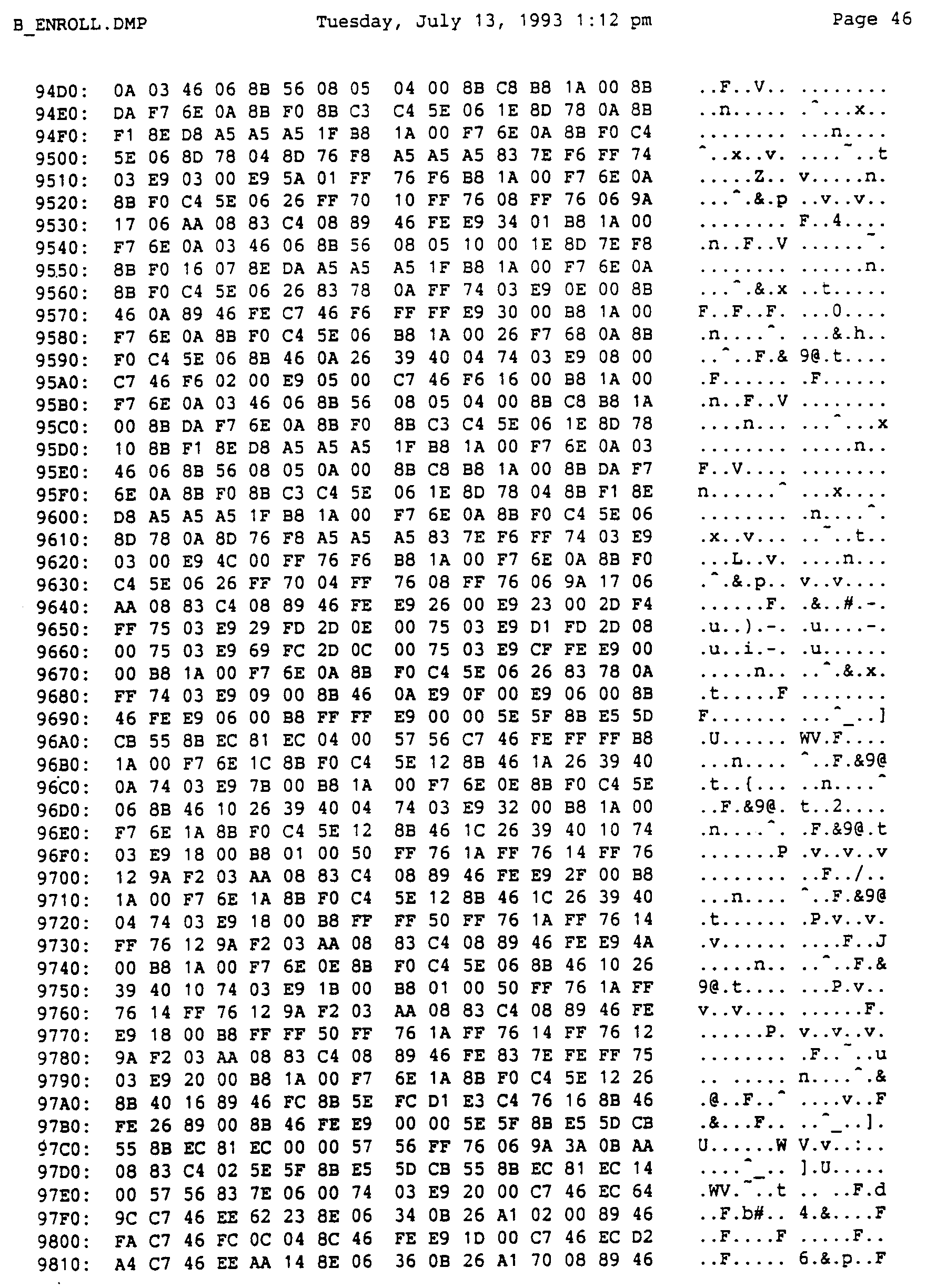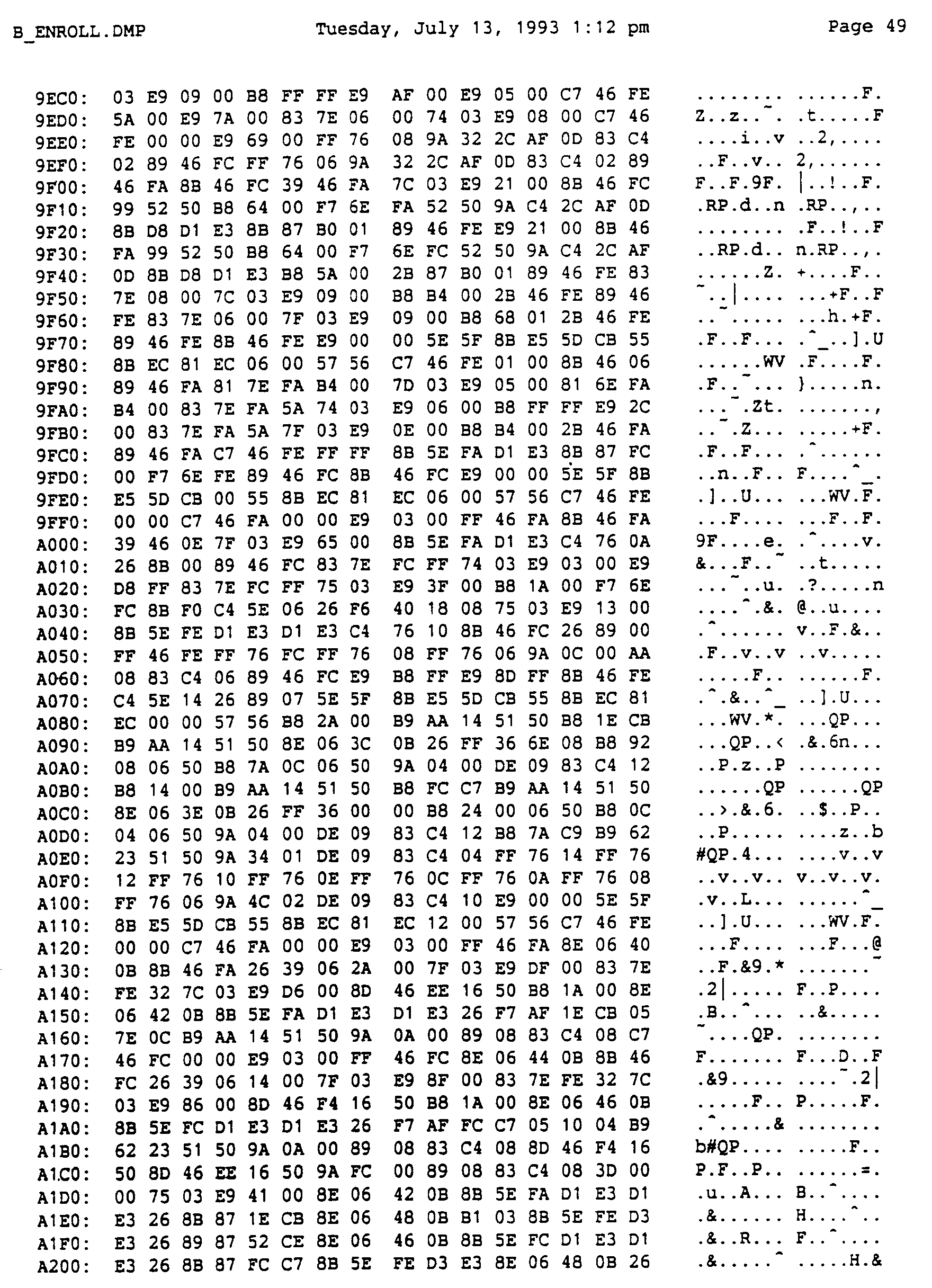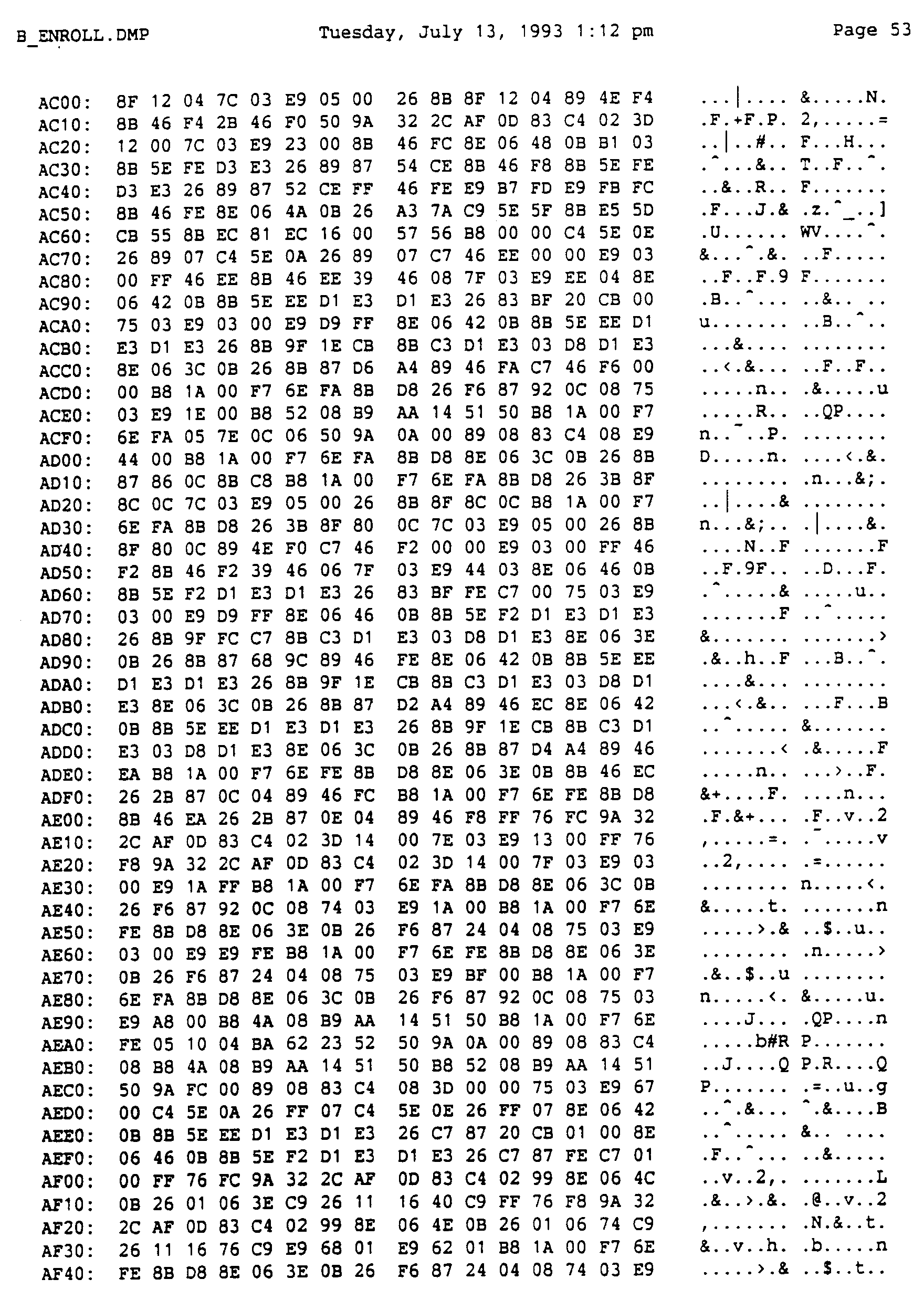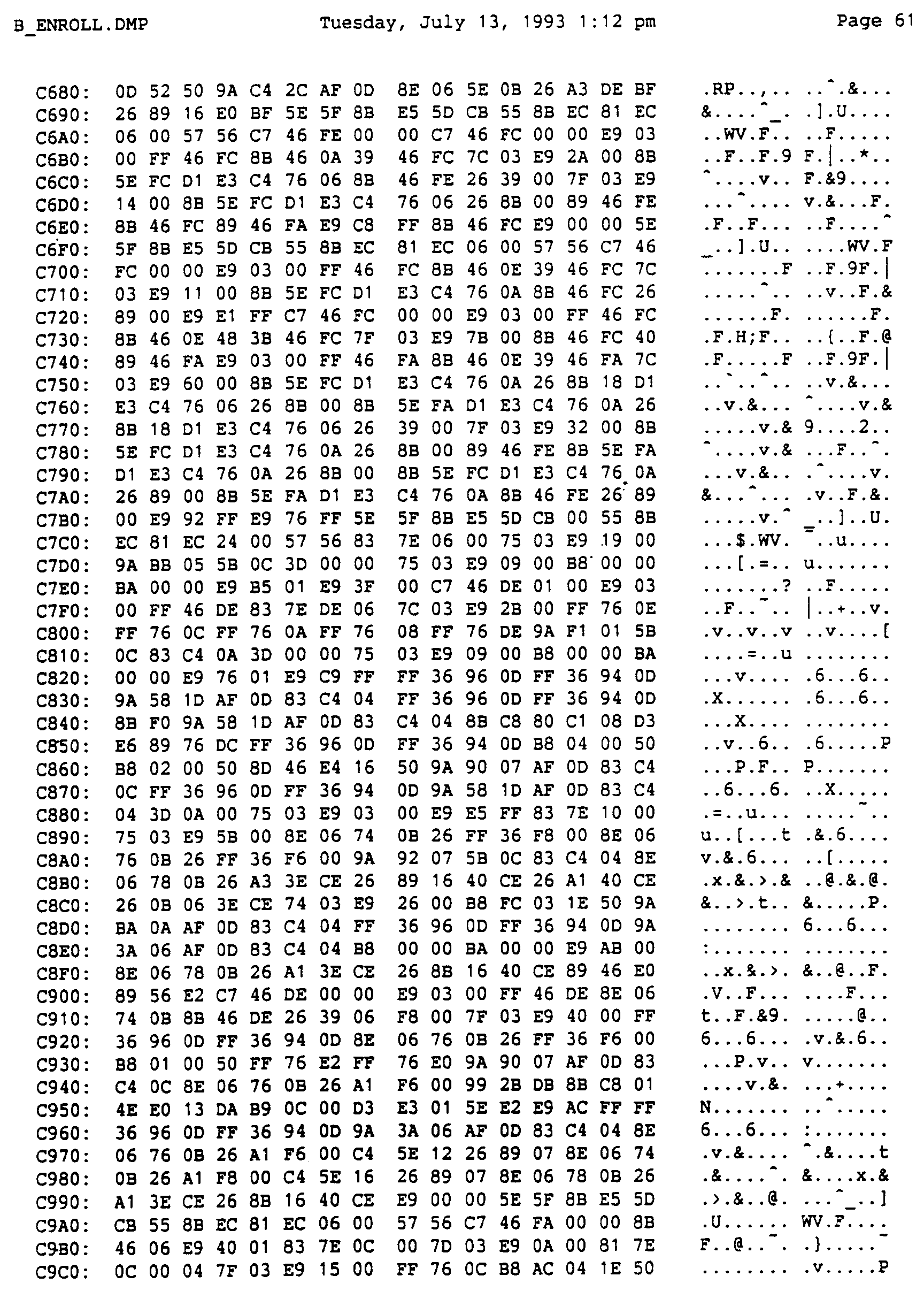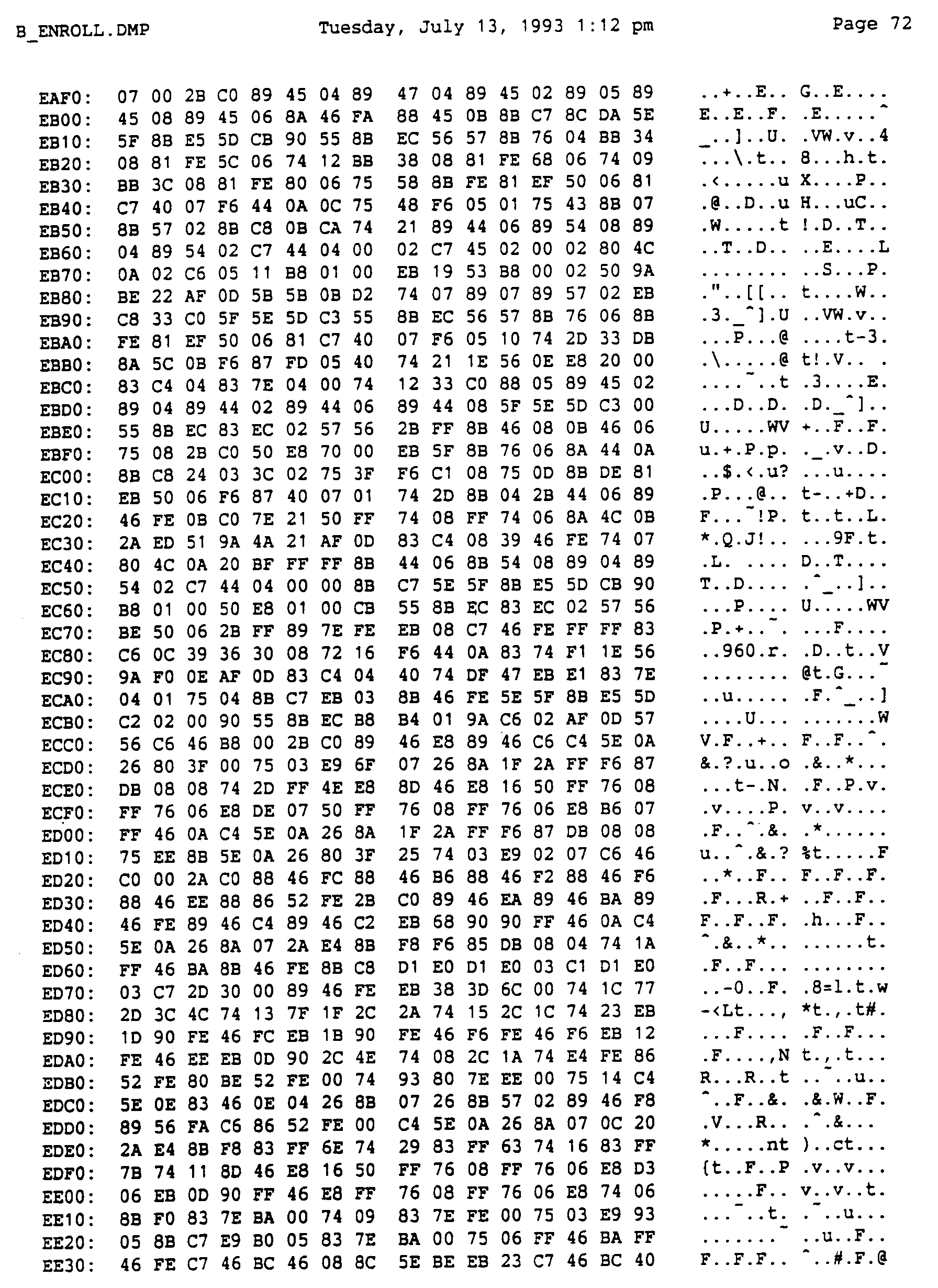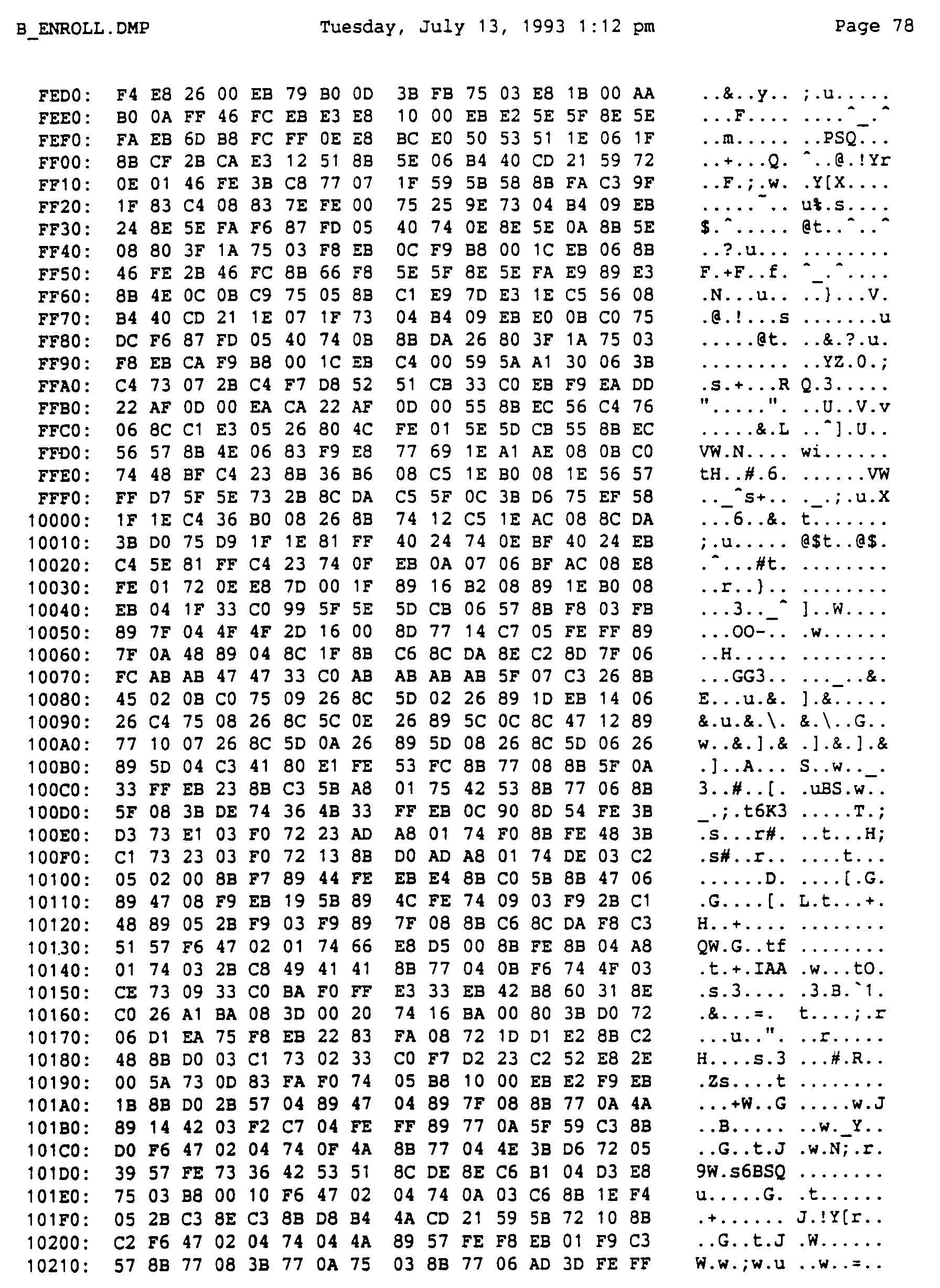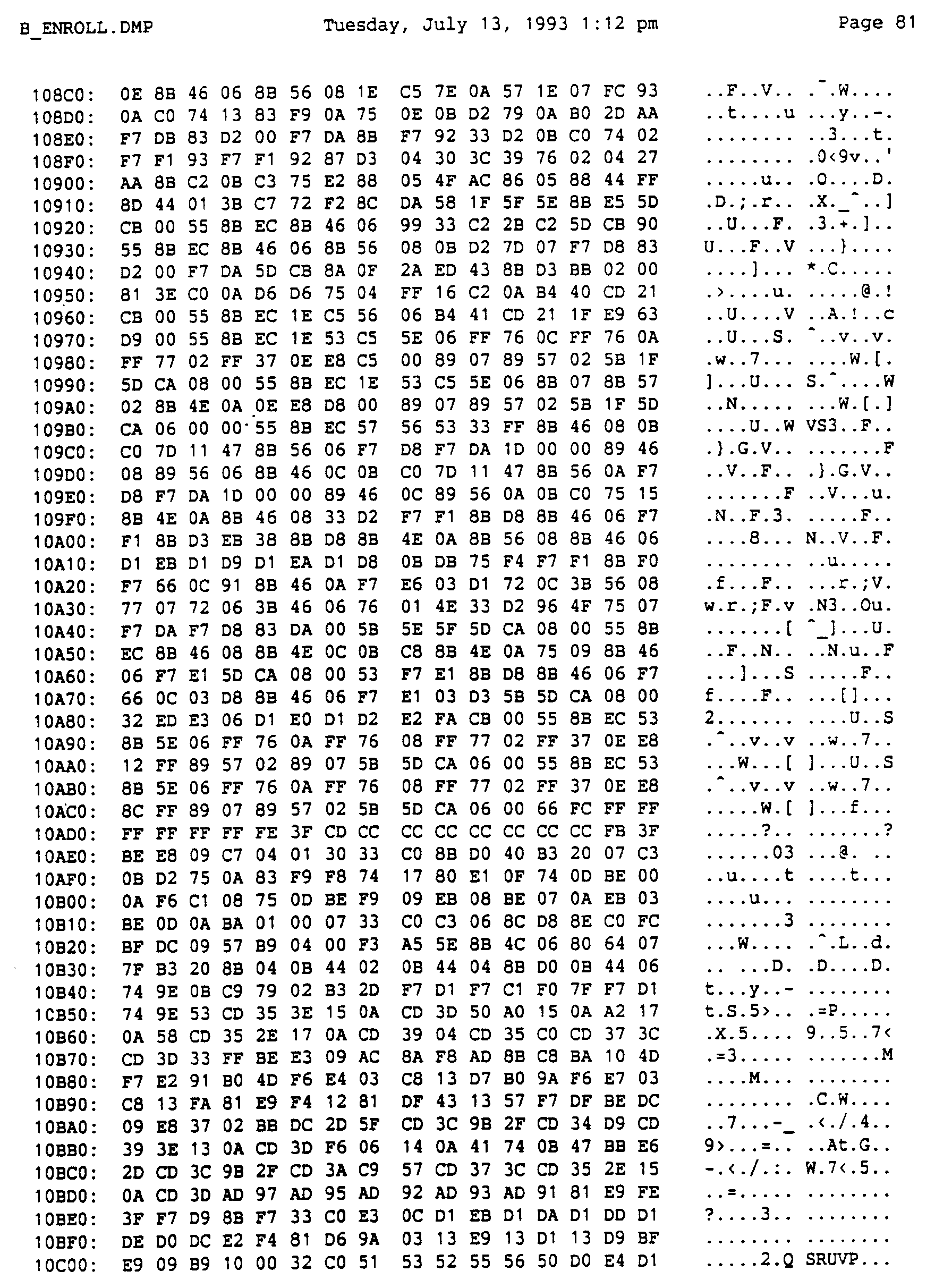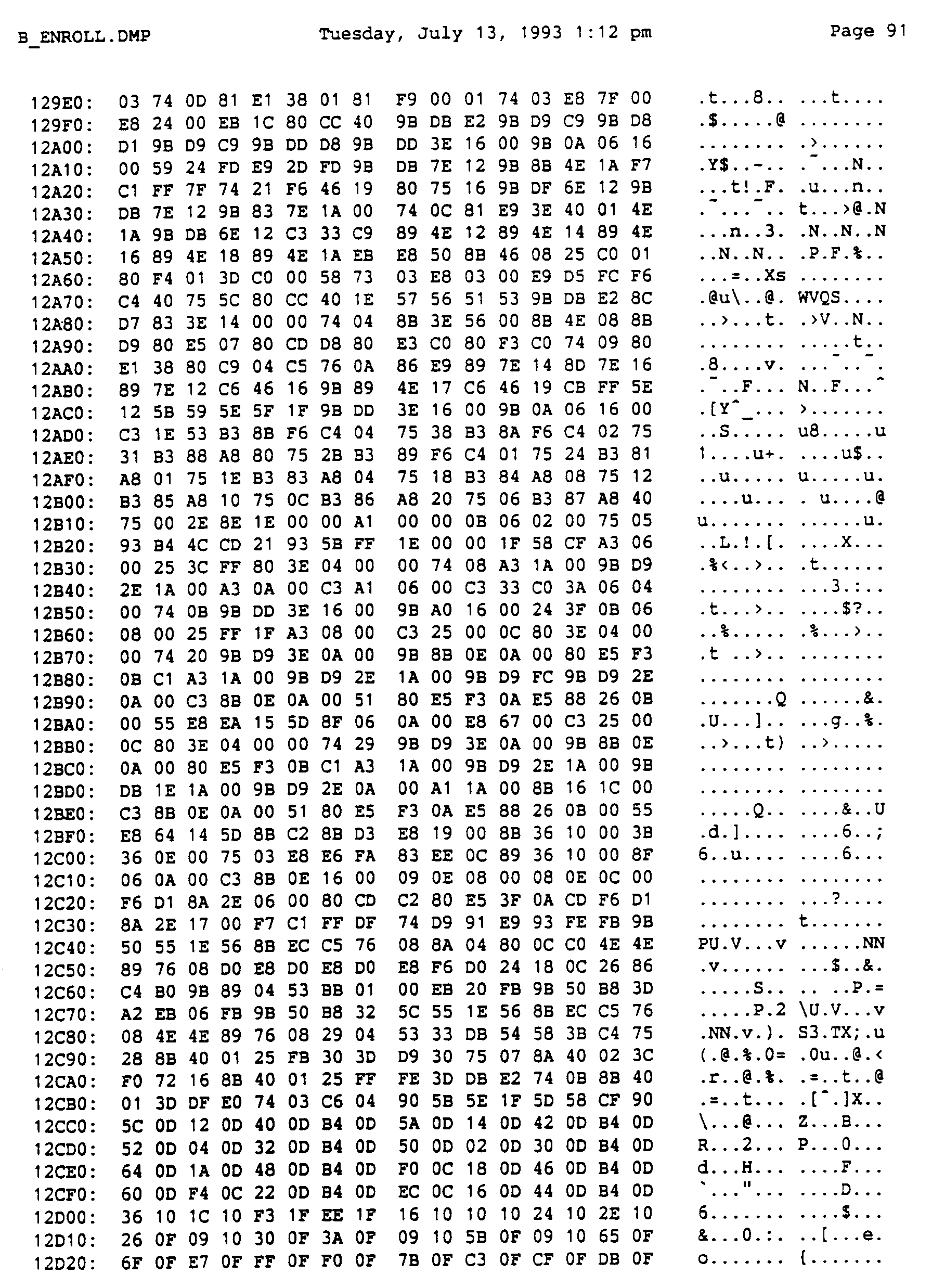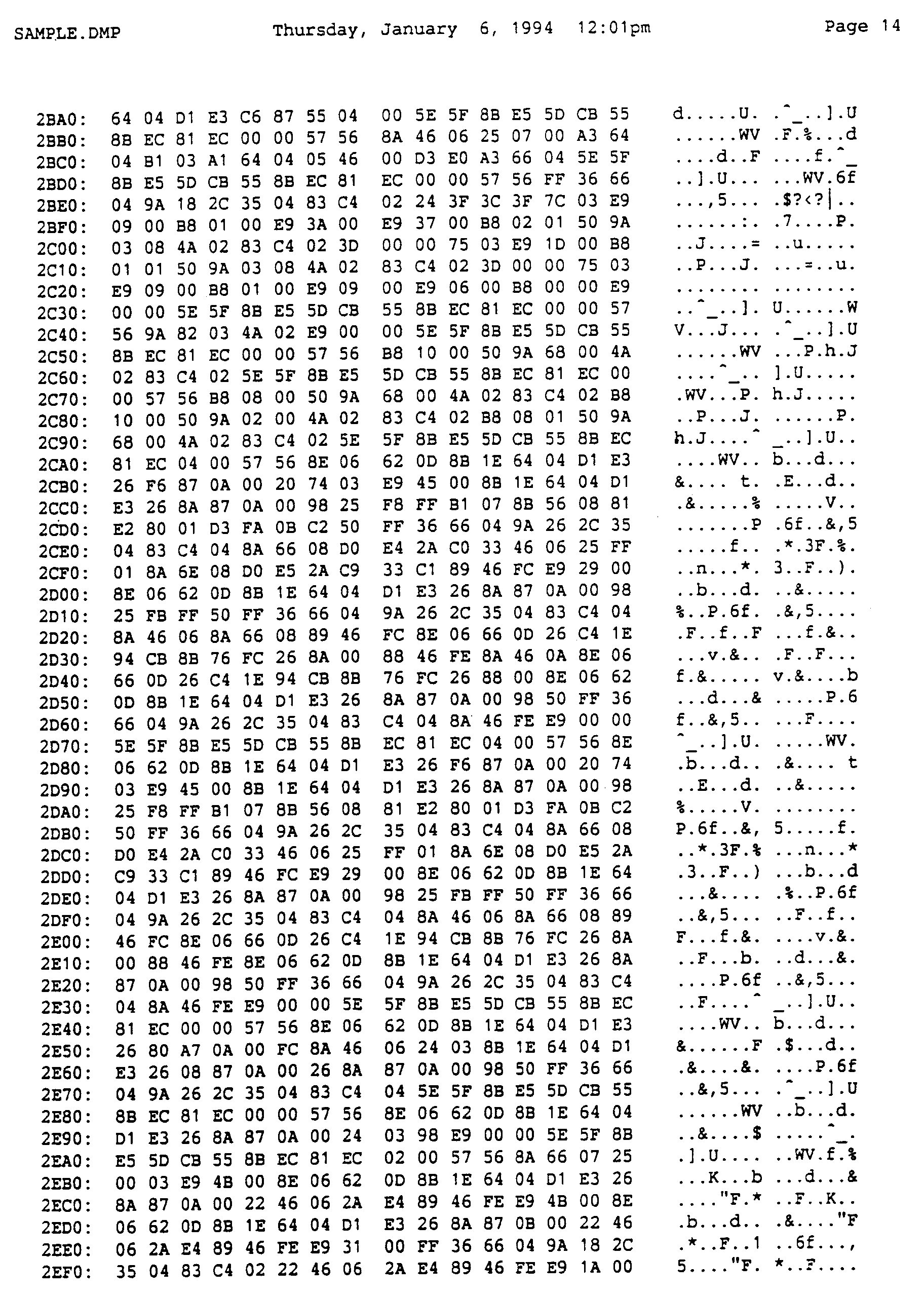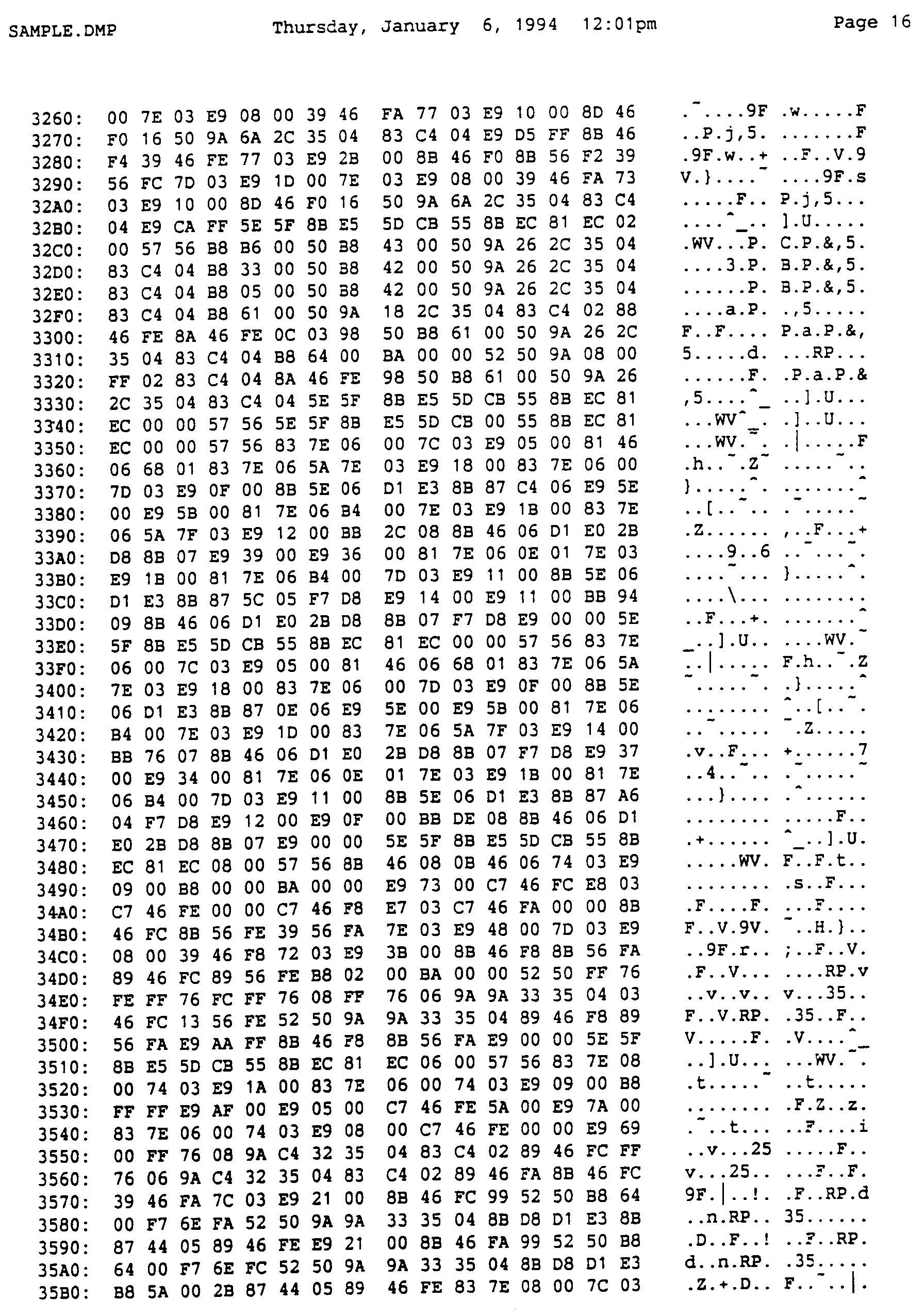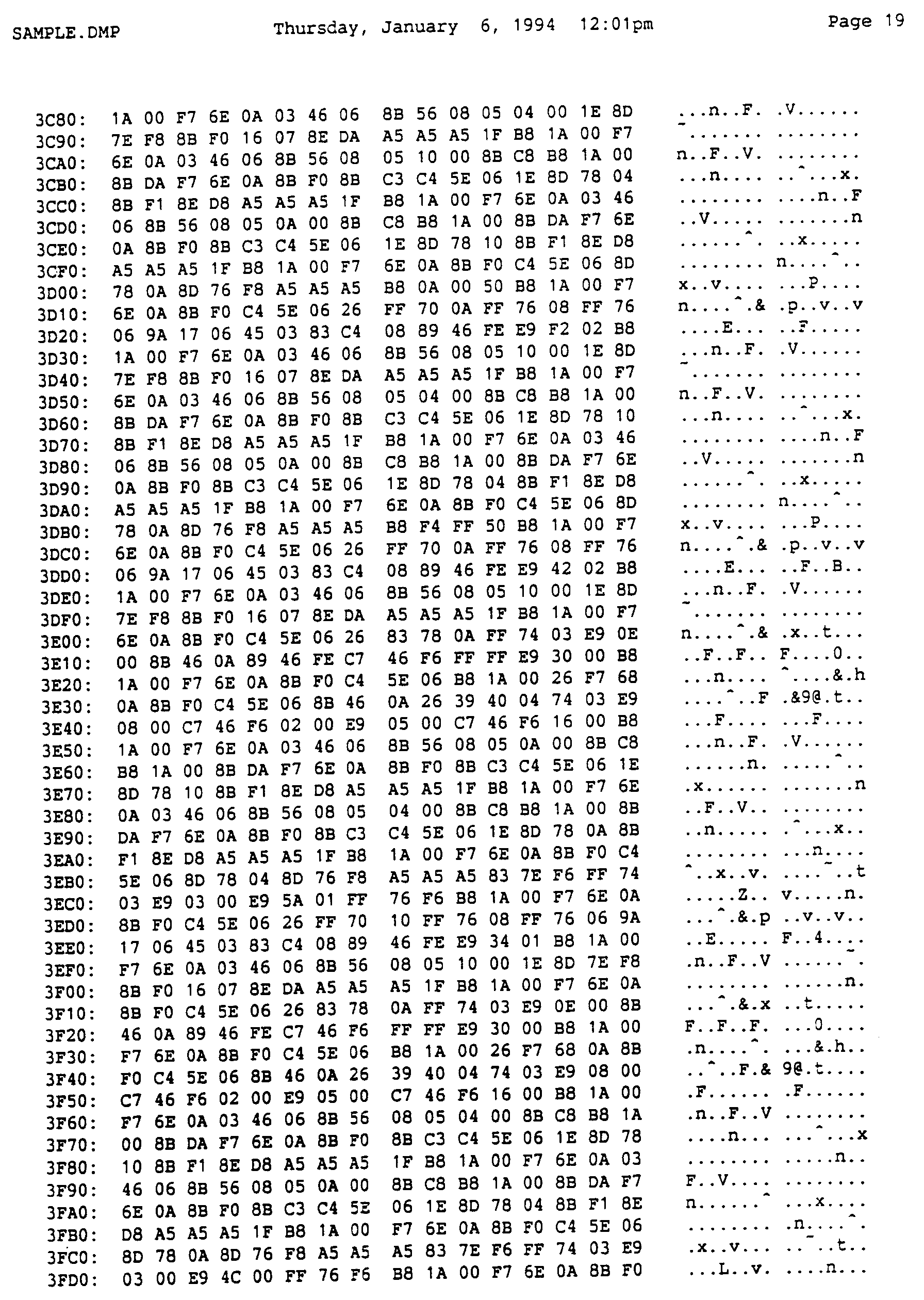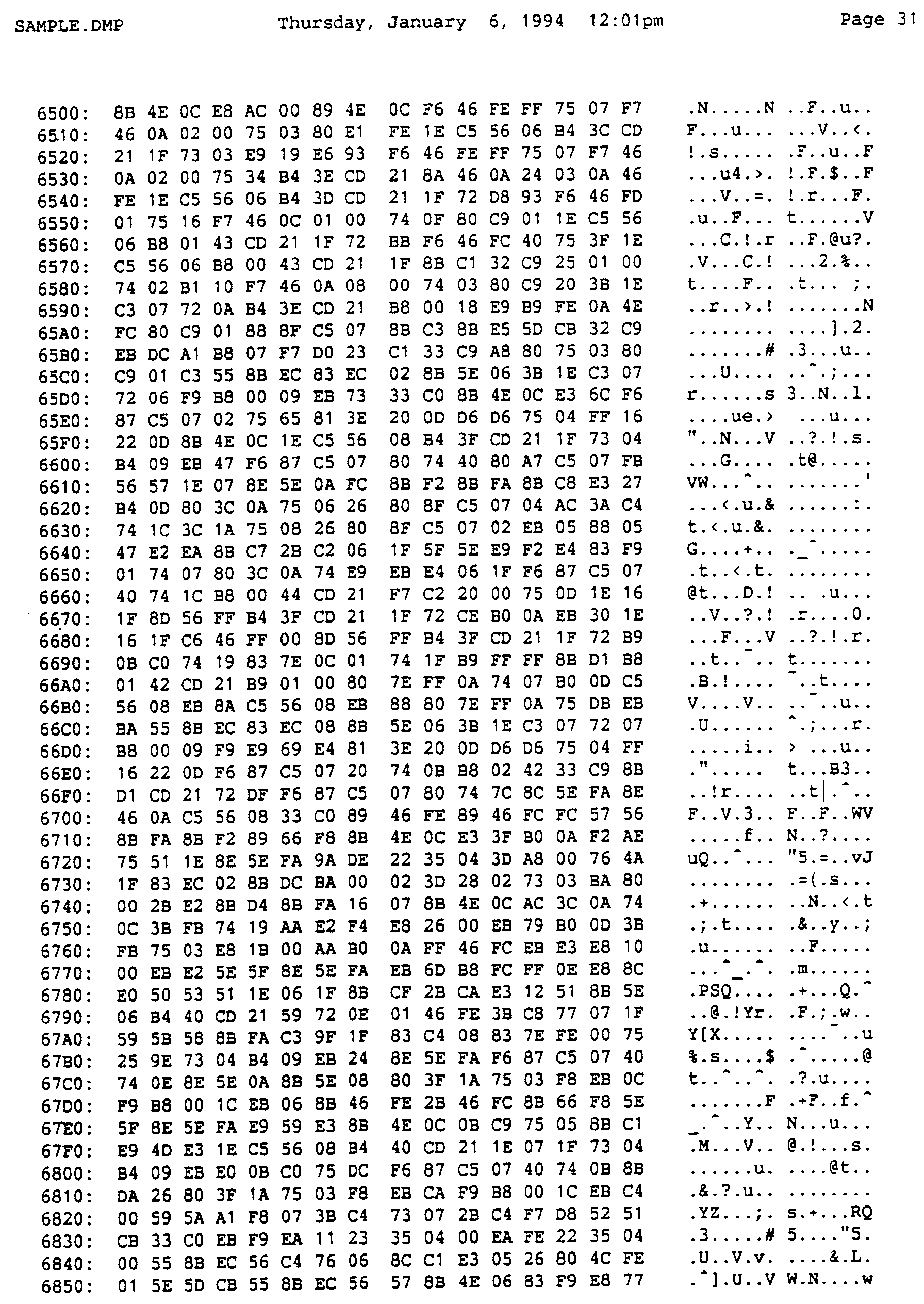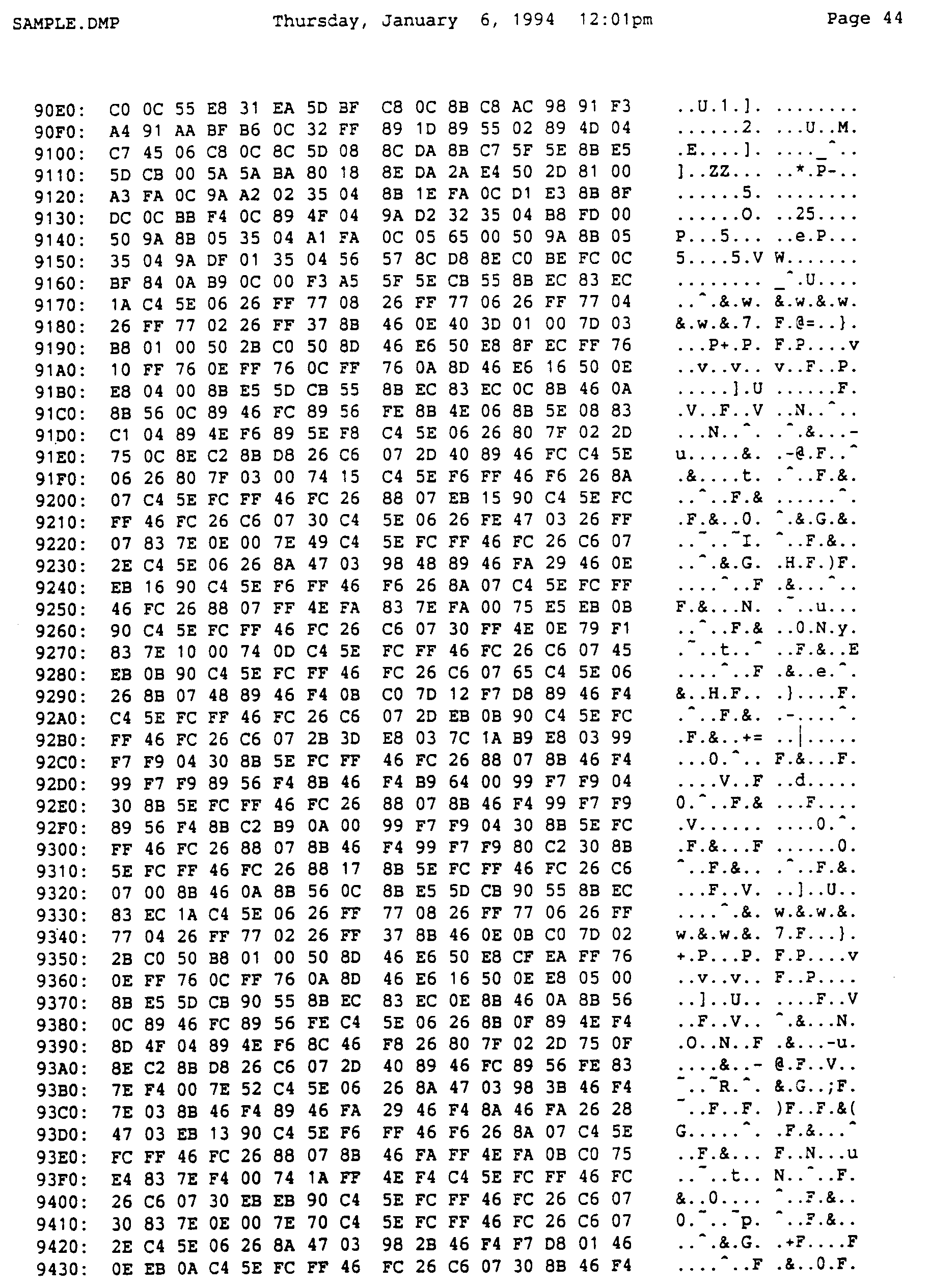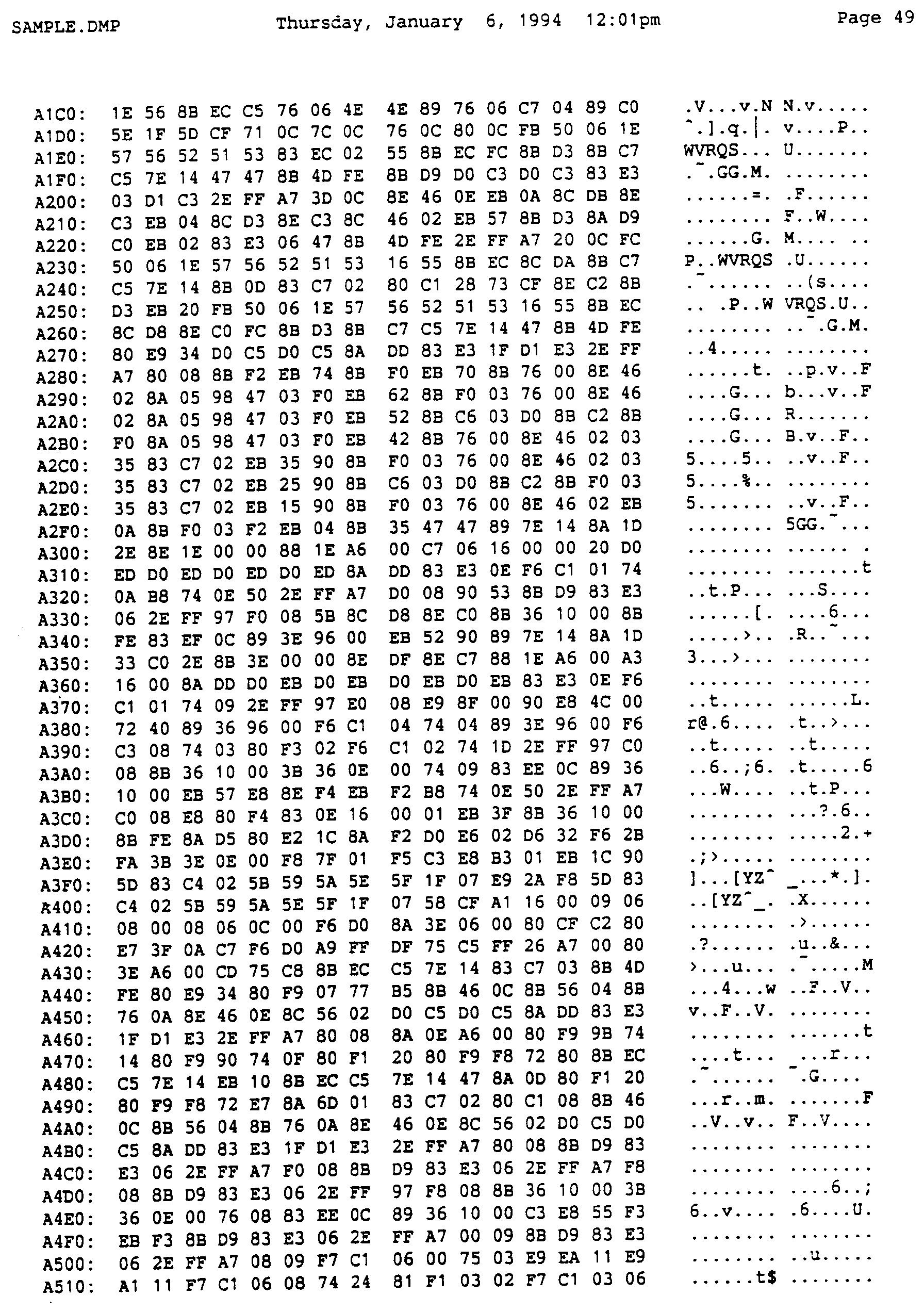FIELD OF THE INVENTION
-
The present invention relates to apparatus and methods for processing images of fingerprints.
BACKGROUND OF THE INVENTION
-
The following publications describe fingerprint processing, including applications of topology to fingerprint processing:
Chen, Z. and Kuo, C. H., "A topology-based matching algorithm for fingerprint authentication", Proceedings 25th Annual 1991 IEEE International Carnahan Conference on Security Technology, pp. 84 - 87. "Automated fingerprint recognition using structural matching", A. K. Hrechak and J. A. McHugh, Pattern Recognition, 23(8), pp. 893 - 904, 1990; and
"Fingerprint identification using graph matching", D. K. Isenor, S. G. Zaky, Pattern Recognition, Vol. 19 (2), pp. 113 - 122, 1986.
-
Qingham Xiao and Rafaat, H., "Fingerprint Image Post-processing: A Combined Statistical and Structural Approach", Pattern Recognition, Vol. 24, Iss. 10, 1991, pp. 985-992;
K. Asai, Y. Hoshino, N. Yamashita and S. Hiratsuka, "Fingerprint Identification System", Second USA-Japan, Computer Conference, 1975.
-
Other U.S. patents describing the state of the art of the present invention are: U.S. Patent 4,185,270 to Fischer II et al; U.S. Patents 4,581,760; 4,618,988; 4,696,046 and 4,752,966 to Schiller; U.S. patent 4,896,363 to Taylor et al; 4,947,442 to Tanaka et al; and 5,067,162 to Driscoll et al.
-
Graph theory is described in the following publication, the disclosre of which is incorporated herein by reference:
Harary, F., "Graph Theory", Reading MA., Addison-Wesley, 1969.
-
Other publications generally illustrating the state of the art are the following, the disclosures of which are hereby incorporated by reference:
A. K. Jain, "Fundamentals of Digital Image Processing", Prentice-Hall, Inc., 1989;
Gonzalez, R. and Wood, R. E., "Digital Image Processing", Addison-Wesley, 1992;
Gotlieb, C. C. and Gotlieb, L. R. Data types and structures, Prentice-Hall, Inc., Englewood Cliffs, NJ, pp. 49 -53;
Berge, C. "Graphs and Hypergraphs", 2nd Revised Ed., New York, American Elsevier, 1976;
Ballard, D.H. and C.M. Brown, "Computer Vision", Prentice-Hall, 1982;
Jim Piper, "Efficient Implementation of Skeletonization Using Interval Coding", Pattern Recognition Letters 3, 1985, pp. 389-397; and
E.R. Davies and A.P.N. Plummer, "Thinning Algorithms: A Critique and a New Methodology", Pattern Recognition, Vol. 14, 1 - 6, 1981, pp. 53 - 63.
SUMMARY OF THE INVENTION
-
The present invention seeks to provide an improved system for processing fingerprint images.
-
There is thus provided in accordance with a preferred embodiment of the present invention apparatus for processing a topological representation of a fingerprint, the apparatus including a topological fingerprint representation generation unit operative to generate a topological representation of a fingerprint including for each node along a ridge-representing graph, an indication of all neighboring nodes along the ridge-representing graph.
-
There is further provided in accordance with a preferred embodiment of the present invention apparatus for fingerprint verification including a fingerprint representation unit operative to provide two topological representations of two respective fingerprints, and a topological fingerprint representation comparison unit operative to compare the two topological representations of the two respective fingerprints and to provide an output indication of the extent of similarity therebetween.
-
Still further in accordance with a preferred embodiment of the present invention the output indication includes a binary indication of whether or not the fingerprints are considered identical.
-
Additionally provided in accordance with a preferred embodiment of the present invention is a topological fingerprint bank including a topologically represented fingerprint bank in which is stored at least one topological representation of at least one fingerprint. Alternatively, each individual's topological fingerprint representation may be stored on a portable ID card such as a magnetic card, smart card, or paper card.
-
Further in accordance with a preferred embodiment of the present invention each at least one topological representation includes, for each node along a ridge-representing graph, an indication of all neighboring nodes along the ridge-representing graph.
-
Still further in accordance with a preferred embodiment of the present invention the topological representation includes at least one tree.
-
Yet further in accordance with a preferred embodiment of the present invention the topological representation includes a forest of trees.
-
Additionally in accordance with a preferred embodiment of the present invention the forest of trees includes a forest of binary trees.
-
Further in accordance with a preferred embodiment of the present invention each tree represents a fingerprint ridge.
-
There is also provided in accordance with a preferred embodiment of the present invention a method for processing a topological representation of a fingerprint, the method including the steps of generating a topological representation of a fingerprint including, for each node along a ridge-representing graph, an indication of all neighboring nodes along the ridge-representing graph.
-
There is additionally provided in accordance with a preferred embodiment of the present invention a method for fingerprint verification including receiving two topological representations of two respective fingerprints, and subsequently comparing the two topological representations of the two respective fingerprints and providing an output indication of the extent of similarity therebetween.
-
Further in accordance with a preferred embodiment of the present invention the method also includes, prior to the comparing step, the step of aligning the two topological representations of the two respective fingerprints.
-
There is yet further provided in accordance with a preferred embodiment of the present invention a method for enhancing a topological representation of a fingerprint, the method including the steps of providing a topological representation of a fingerprint including a multiplicity of nodes, processing the topological representation of the fingerprint so as to eliminate at least one impossible topological feature therefrom.
-
Further in accordance with a preferred embodiment of the present invention the step of processing includes the step of repeating, for each of a plurality of node pairs from among the multiplicity of nodes, the steps of determining whether the node pair defines an impossible pair, and if the node pair is an impossible pair, deleting the node pair and modifying the remaining nodes to adjust for the deleted node pair.
-
Additionally provided in accordance with a preferred embodiment of the present invention is a method for binarizing gray level images including at least one elongate configuration, the method including the steps of receiving a gray level image, locating at least one elongate configuration in the gray level image, moving along the at least one elongate configuration, binarizing the at least one elongate configuration in the course of moving therealong, and providing an indication of at least one binarized elongate configuration.
-
Additionally in accordance with a preferred embodiment of the present invention the step of providing includes the step of storing an indication of at least one binarized elongate configuration.
-
Also in accordance with a preferred embodiment of the present invention the step of providing includes the step of providing an output indication of at least one binarized elongate configuration.
-
Still further in accordance with a preferred embodiment of the present invention the step of receiving includes the step of receiving a gray level image of a fingerprint.
-
Additionally in accordance with a preferred embodiment of the present invention the step of receiving includes the step of receiving a gray level image of at least one character or the step of receiving a gray level image of at least a portion of a printed circuit.
-
There is also provided in accordance with a preferred embodiment of the present invention a method for matching fingerprints including providing at least two fingerprints from each of a multiplicity of individuals, deriving a plurality of fingerprint characteristics from each fingerprint, statistically analyzing the plurality of fingerprint characteristics, thereby to identify a subset of fingerprint characteristics which predict a fingerprint match, and constructing fingerprint matching apparatus operative to match first and second fingerprints on the basis of the subset of fingerprint characteristics.
-
Further provided in accordance with a preferred embodiment of the present invention is a method for identifying fingerprint quality including the steps of providing a plurality of prints of an individual finger, matching each pair of prints from among the plurality of prints, and selecting the print, from among the plurality of prints, which best matches the remaining prints.
-
Still further in accordance with a preferred embodiment of the present invention the method also includes the step of disqualifying the best matching print if the best matching print does not match the remaining prints well enough, when compared to a predetermined matching adequacy threshold.
-
There is additionally provided in accordance with a preferred embodiment of the present invention a fingerprint matching method including the steps of comparing a first fingerprint image of known quality to a second fingerprint image, thereby to provide a similarity score, and providing an output indication that the first and second fingerprint images match if the similarity score exceeds a predetermined similarity threshold, wherein the predetermined similarity threshold is selected in accordance with the known quality of the first fingerprint image.
-
Further provided in accordance with a preferred embodiment of the present invention is a method for processing a topological representation of a fingerprint, the method including the steps of generating a topological representation of a fingerprint including for each node along a ridge-representing graph, an indication of all neighboring nodes along the ridge-representing graph.
-
Still further in accordance with a preferred embodiment of the present invention the generating step is performed for each of a plurality of prints of an individual finger, and also including the step of combining the topological representations of the plurality of prints into a single topological representation.
-
There is further provided in accordance with a preferred embodiment of the present invention apparatus for processing a topological representation of a fingerprint, the apparatus including apparatus for generating a topological representation of a fingerprint including, for each node along a ridge-representing graph, an indication of all neighboring nodes along the ridge-representing graph.
-
There is still further provided in accordance with a preferred embodiment of the present invention apparatus for fingerprint verification including apparatus for receiving two topological representations of two respective fingerprints, and subsequently comparing the two topological representations of the two respective fingerprints and providing an output indication of the extent of similarity therebetween.
-
Additionally provided in accordance with a preferred embodiment of the present invention is apparatus for enhancing a topological representation of a fingerprint, the apparatus including apparatus for providing a topological representation of a fingerprint including a multiplicity of nodes, processing the topological representation of the fingerprint so as to eliminate at least one impossible topological feature therefrom.
-
Further provided in accordance with a preferred embodiment of the present invention is apparatus for binarizing gray level images including at least one elongate configuration, the apparatus including apparatus for receiving a gray level image, locating at least one elongate configuration in the gray level image, moving along the at least one elongate configuration, binarizing the at least one elongate configuration in the course of moving therealong, and providing an indication of at least one binarized elongate configuration.
-
There is still further provided in accordance with a preferred embodiment of the present invention apparatus for matching fingerprints including apparatus for providing at least two fingerprints from each of a multiplicity of individuals, deriving a plurality of fingerprint characteristics from each fingerprint, statistically analyzing the plurality of fingerprint characteristics, thereby to identify a subset of fingerprint characteristics which predict a fingerprint match, and constructing fingerprint matching apparatus operative to match first and second fingerprints on the basis of the subset of fingerprint characteristics.
-
There is additionally provided in accordance with a preferred embodiment of the present invention apparatus for identifying fingerprint quality including apparatus for providing a plurality of prints of an individual finger, matching each pair of prints from among the plurality of prints, and selecting the print, from among the plurality of prints, which best matches the remaining prints.
-
There is yet further provided in accordance with a preferred embodiment of the present invention a fingerprint matching apparatus including apparatus for comparing a first fingerprint image of known quality to a second fingerprint image, thereby to provide a similarity score, and providing an output indication that the first and second fingerprint images match if the similarity score exceeds a predetermined similarity threshold, wherein the predetermined similarity threshold is selected in accordance with the known quality of the first fingerprint image.
-
There is additionally provided in accordance with a preferred embodiment of the present invention apparatus for processing a topological representation of a fingerprint, the apparatus including apparatus for generating a topological representation of a fingerprint including for each node along a ridge-representing graph, an indication of all neighboring nodes along the ridge-representing graph.
-
There is further provided in accordance with a preferred embodiment of the present invention apparatus for sampling a fingerprint including a fingerprint imager operative to repeatedly image a fingerprint, a fingerprint quality characteristic analyzer operative to analyze at least one fingerprint quality characteristic and to select a fingerprint image whose quality characteristic answers to a predetermined criterion.
BRIEF DESCRIPTION OF THE DRAWINGS
-
The present invention will be understood and appreciated from the following detailed description, taken in conjunction with the drawings in which:
- Fig. 1 is a simplified flowchart of a method, provided in accordance with a preferred embodiment of the present invention, for creating a topological representation of a fingerprint;
- Fig. 2A is a pictorial illustration of a portion of a fingerprint, shown binarized, for simplicity, which includes five ridges;
- Fig. 2B is a diagrammatic illustration of a forest of five binary trees respectively representing the five ridges in the fingerprint of Fig. 2A;
- Fig. 3 is a topological representation of a fingerprint including a "lake";
- Fig. 4 is a simplified flowchart of a preferred method for binarizing a gray level fingerprint;
- Fig. 5 is a pictorial illustration of a sample section of gray levels;
- Fig. 6 is a simplified flowchart of a preferred method for implementing IS_PIXEL_ON_RIDGE;
- Fig. 7 is a simplified flowchart illustrating a preferred method for generating a topological representation of a fingerprint image; Fig. 8 is a simplified flowchart of a recursive tree building process employed in the method of Fig. 7;
- Fig. 9A is a diagrammatic illustration of a topological representation of a fingerprint, derived from the topological representation of Fig. 2B;
- Fig. 9B is a pictorial illustration which corresponds to the topological representation of Fig. 9A;
- Fig. 10A is a diagrammatic illustration of a topological representation of a fingerprint, derived from the topological representation of Fig. 9A;
- Fig. 10B is a pictorial illustration which corresponds to the topological representation of Fig. 10A;
- Fig. 11 is a pictorial illustration defining parameters used to define a preferred criterion for identifying erroneously split ridges;
- Fig. 12A is a diagrammatic illustration of a topological representation of a fingerprint, derived from the topological representation of Fig. 10A;
- Fig. 12B is a pictorial illustration which corresponds to the topological representation of Fig. 12A;
- Fig. 13 is a simplified flowchart of a sample post-processing method for identifying and eliminating several types of inappropriate configurations;
- Fig. 14 is a simplified flowchart of a method for determining whether a current pair is a false limb;
- Fig. 15 is a simplified flowchart of a method for eliminating false limbs;
- Fig. 16 is a simplified block diagram illustration of topological fingerprint verification apparatus constructed and operative in accordance with a preferred embodiment of the present invention;
- Figs. 17A and 17B taken together, form a simplified flowchart illustration of a fingerprint verification method provided in accordance with a preferred embodiment of the present invention;
- Fig. 18 is a simplified flowchart illustrating a preferred method for performing alignment step 170 of Fig. 17B;
- Fig. 19 is a simplified flowchart illustrating a preferred method for performing matching step 180 of Fig. 17B;
- Fig. 20 is a simplified block diagram of fingerprint processing apparatus constructed and operative in accordance with a preferred embodiment of the present invention;
- Fig. 21 is a flowchart describing a preferred method of operation for fingerprint analyzer 410 of Fig. 20;
- Fig. 22 is a simplified flowchart of a preferred method for analyzing fingerprint image quality;
- Figs. 23A and 23B are diagrams helpful in understanding steps 540 and 560 of the method of Fig. 22;
- Fig. 24 is a simplified flowchart of a preferred method for performing step 500 of Fig. 21;
- Fig. 25A is a diagram of a line following situation wherein the line intersects with the window;
- Fig. 25B is a diagram of a line following situation wherein the line ends inside the window;
- Fig. 25C is a diagram of a line following situation wherein the line splits inside the window; and
- Figs. 26A - 26D are diagrams of a sequence of windows defined while following a line when d=2 and the resulting thinned output.
-
Attached herewith are the following appendices which aid in the understanding and appreciation of one preferred embodiment of the invention shown and described herein:
- Appendix A is a hexadecimal computer listing of an executable file, entitled "enroll.dmp" and comprising a preferred software implementation of a fingerprint enrolling method provided in accordance with a first preferred embodiment of the present invention;
- Appendix B is a hexadecimal computer listing of an executable file, entitled "extract.dmp" and comprising a preferred software implementation of a fingerprint data extraction method provided in accordance with a preferred embodiment of the present invention;
- Appendix C is a hexadecimal computer listing of an executable file, entitled "match.dmp" and comprising a preferred software implementation of a fingerprint data matching method provided in accordance with a preferred embodiment of the present invention;
- Appendix D is a hexadecimal computer listing of an executable file, entitled "b_enroll.dmp" and comprising a preferred software implementation of a fingerprint enrolling method provided in accordance with a second preferred embodiment of the present invention; and
- Appendix E is a hexadecimal computer listing of an executable file, entitled "sample.dmp" and comprising a preferred software implementation of an automatic fingerprint sampling method provided in accordance with a preferred embodiment of the present invention.
DETAILED DESCRIPTION OF PREFERRED EMBODIMENTS
-
Reference is now made to Fig. 1 which illustrates a method, provided in accordance with a preferred embodiment of the present invention, for creating a topological representation of a fingerprint. The topological representation of the fingerprint preferably includes a graph, such as a disconnected graph, each disconnected component of which comprises a topological representation of an individual fingerprint ridge. For example, the topological representation of the fingerprint may comprise a forest of binary trees, each binary tree corresponding to a ridge of the fingerprint, each node of an individual binary tree corresponding to a fork or endpoint of the ridge corresponding to the individual binary tree.
-
For example, Fig. 2A is a pictorial illustration of a portion of a fingerprint, shown binarized, for simplicity, which includes five ridges, referenced as R1 to R5. Twenty-two fork and endpoint locations are defined along the ridges R1 to R5 and are also referred to herein as "minutiae". The 22 minutiae are referenced as N1 to N22. For example, N1 is an endpoint location, N10 is a fork location located at a fork between three limbs whose endpoints are N9, N11 and N12, and N14 is a fork location located at a fork between another fork location N15 and two limbs whose endpoints are N13 and N20, respectively.
-
Fig. 2B is a diagrammatic illustration of a forest of five binary trees respectively representing the five ridges in the fingerprint of Fig. 2A.
-
Referring again to Fig. 1, the method of the present invention preferably includes the following steps:
STEP 32: Receive an image of a fingerprint which typically comprises a gray level image which may, for example, be provided by using conventional fingerprint sampling equipment which may include:
- a. A fingerprint reader such as the DFR-90, commercially available from Identicator Corporation, Marina, Del Rey, CA, in conjunction with:
- b. A frame grabber such as the PCVISIONplus, commercially available from Imaging Technology, Inc., Woburn, MA.
-
STEP 34: The dynamic range of the gray fingerprint image provided in step 32 is stretched. If the gray image is represented, for example, in 8 bits per pixel, the output of step 34 preferably comprises an image whose dynamic range is from 1 to 254, in which ridges are represented with values typically exceeding 128 and valleys and background are represented with values typically falling below 128. The values 0 and 255 are reserved for binarized portions of the image, so as to allow binarized portions of the image to be easily distinguishable, relative to initially black and white portions of the image which are preferably represented using the values 1 and 254, respectively.
-
STEP 36: Binarize the gray level fingerprint. A preferred method for binarizing a gray level fingerprint is described herein with reference to the flowchart of Fig. 4.
-
A particular feature of the above-described binarizing method is that the binarizing operation identifies and travels along the elongate configurations in the gray image and accumulates information regarding the elongate configurations, in the course of traveling therealong, which is employed in the binarizing process. In contrast, conventional binarizing operations travel along the rows or columns of the gray image.
-
Alternatively, however, any suitable binarizing method may be employed, such as the binarizing method described in the following publication:
Gonzalez, R. C. and Woods, R. E. Digital Image Processing, Addison-Wesley, Reading, MA, 1992, pp. 443 - 458.
-
It is appreciated that the term "binarization", as employed herein, is irrelevant to the term "binary tree", also employed herein.
-
STEP 40: Optionally, skeletonize or thin the binarized fingerprint image provided in step 36 so as to provide a one-pixel thick representation of the configurations in the binarized fingerprint image.
-
If the binarization method of Fig. 4 is employed, step 40 may be omitted.
-
A suitable skeletonizing method is described in the following publication:
Piper, J. "Efficient implementation of skeletonization using interval coding", Pattern recognition letters 3, 389 - 397, 1985.
-
STEP 44: Use the output of step 36 or the output of optional step 40 to generate a topological representation of the fingerprint image. Preferably the topological representation comprises a graph such as a forest of binary trees, each binary tree corresponding to a ridge of the fingerprint, each node of an individual binary tree corresponding to a fork or endpoint of the ridge corresponding to the individual binary tree.
-
Sometimes, the topological representation generated in step 44 may include one or more graphs which include a "lake" 45, i.e. a pair of forks 46 and 47 connected by two arcs 48 and 49, as shown in Fig. 3. Alternatively, "lakes" may be deemed illegal, for example, if it is desired to represent each fingerprint ridge as a binary tree.
-
Optionally, additional information regarding the structure of the ridges, such as locations of curvature changes or curvature maxima along the ridge, may be added to the topological representation.
-
The topological representation is stored in computer memory or on secondary memory in any media such as Hard Disk or Flash memory. Any suitable scheme may be employed to store the topological representation of the fingerprint. For example, the following publication describes a conventional scheme for storing graphs such as trees:
Gotlieb, C. C. and Gotlieb, L. R. Data types and structures, Prentice-Hall, Inc., Englewood Cliffs, NJ, pp. 49 -53.
-
Preferably, the following information is stored for each node:
- a. The coordinates of the node;
- b. The identities of each neighboring node;
- c. The lengths of the limbs connecting the node to each of its neighboring nodes, e.g. to its parent, right son, and left son, if all of these exist. If step 40 of Fig. 1 is performed, the length may be computed by counting pixels in the course of traveling along the skeletonized limb. Alternatively, the length may be computed by computing the distances between the centers of consecutive windows, where the term "windows" is used in the sense of the Figs. 25 and 26.
- d. For each neighboring node: the angle of the tangent at the node to the limb connecting the node to its neighbor.
-
For example, the angle may be computed by computing the angle between the horizontal axis and a line connecting the following two points:
- i. The center of a window, as defined below with reference to Figs. 25 and 26, in which the node is located; and
- ii. The center of an adjacent window along the ridge connecting the node to its neighbor.
-
STEP 50: Optionally, postprocess the topological representation generated in step 44 so as to reduce noise therewithin. In order to postprocess the topological representation, the system typically traverses the arcs defined in the topological representation of the fingerprint. In the course of traveling along the graph, "impossible topological features" are identified, i.e. configurations which are not appropriate to the known configuration of a fingerprint. These configuration are assumed to be erroneous and are eliminated.
-
The present specification assumes that fingerprint ridges are represented in white whereas background and fingerprint valleys are represented in black, however, this need not be the case. For example, the color scheme for representing ridges and valleys may be reversed.
-
Reference is now made to Fig. 4 which is a simplified flowchart of a preferred method for performing binarization step 36 of Fig. 1 in which a binarizing window is opened around a location in a gray fingerprint image, the direction and width of a ridge identified in that window are determined, and the direction and width information are employed to binarize that window and to determine the location and size of a new window. The process is then repeated for the new window, and so on, for each new window defined, until all ridges in the gray image are binarized.
-
One method for determining ridge direction is by selecting, for each of a plurality of probable directions, a pixel pair lying along the individual probable direction. The probable direction corresponding to the pixel pair having the smallest gray level difference is selected to be the ridge direction.
-
Preferably, only probable directions are considered, rather than all directions. Probable directions are defined by considering one or more directions which are equal to or close to the direction of the ridge in the previous binarizing window.
-
Typically, 8 directions are used, providing a resolution of 22.5 degrees.
-
To find ridge width, the gray levels of the image within the binarizing window, in a direction perpendicular to the ridge direction, are considered. The resulting "section" of gray levels is analyzed to determine ridge width, as illustrated in Fig. 5 which is a pictorial illustration of a sample section of gray levels.
-
A simpler method for finding ridge width which gives good results is based on the (ridge traversal) method, described below with reference to Figs. 25 and 26, and comprises the step of computing the distance between a pointer Lp to the left edge of the ridge and a pointer Rp to the right edge of the ridge, where left and right are defined relative to the direction in which the ridge is being traced.
-
A preferred method for determining the location and size of a new window once the current window has been binarized is described below with reference to Figs. 25 and 26.
-
In Fig. 4:
RIDGE_HISTORY = an array which stores ridge information pertaining to a plurality of the most recent binarizing windows, such as the 5 most recent windows.
IS_PIXEL_ON_RIDGE = a logical function which returns TRUE if the pixel is on an unbinarized ridge and FALSE otherwise.
-
Reference is made briefly to Fig. 6 which is a simplified flowchart of a preferred method for implementing IS_PIXEL_ON_RIDGE.
BIN_REST = a process in which pixels whose values are low, e.g. below a threshold such as 128, are set to be 0, and, preferably, pixels whose values are high, e.g. above a threshold such as 128, are set to be 255.
SET_INITIAL-WINDOW(x,y) = a process in which an initial binarizing window is opened around a pixel (x,y). The size of the window is typically 2R x 2R, where R is an estimate of the average ridge width.
IS_FORK = a logical function which determines whether a current window includes a fork location.
IS_ENDING = a logical function which determines whether a current window includes an endpoint location.
NEXT_WINDOW = open a new binarizing window.
-
In step 60, the direction and width of the ridge portion contained within the current binarizing window is determined, The RIDGE_HISTORY array is updated, and the updated array is employed to binarize the current window including ridge portions therewithin and non-ridge portions therewithin.
-
Preferably, the ridge direction, if known, is exploited as in directional filtering.
-
If the ridge width is known, lower threshold values are used when binarizing a ridge, relative to higher threshold values which are used when binarizing outside the ridge.
-
In step 62, if the window includes an endpoint, the process proceeds to a new ridge. If the window includes a fork, the process preferably also proceeds to a new ridge because the two limbs defining the fork will be "found" separately. If the window includes neither an endpoint nor a fork (NO option of step 62), the process continues binarizing the current ridge.
-
It is appreciated that a topological representation of a fingerprint image may, if desired, be generated in the course of binarizing the image since topological information is available in the course of the binarization process of Fig. 4.
-
A preferred method for performing the topological representation generation step 44 of Fig. 1 is now described with reference to Figs. 7, 8, 25 and 26. Figs. 25 and 26, described in detail below, describe how to move along elongate configurations, such as fingerprint ridges in the present application, which are included in a binarized image. Using the method of Figs. 25 and 26, each location along each elongate configuration is encountered at least once and preferably only once. Figs. 25 and 26 also describe how to determine the connectivity structure defined by the axes of nonthinned elongate configurations, in the course of traversing those elongate configurations, including determination of the locations of endpoints and forks therewithin, and how to thin the elongate configurations.
-
With reference to Figs 25 & 26, a description is now provided of a preferable line following method, which is part of the publication "Line thinning by line following", O. Baruch, Pattern Recognition Letters 8 (1988) 271-276.
-
The line following method is performed on a binary image matrix. The background is assumed to be black. The matrix is preferably raster scanned exactly once. During the scan, the line follower is called to follow each encountered line. When the follower identifies branching of the line, it calls itself recursively to follow each of the branches. The line following is based on two pointers and a dynamic window:
LP - a pointer to follow the left edge of the line
RP - a pointer to follow the right one.
W - a rectangular window whose sides are parallel to the sides of the matrix.
-
The line following is performed within the pre-defined current window.
-
Initially the pointers are set by the scanner to the location of an encountered white pixel, which is assumed to reside on some line figure.
-
The line follower performs the following procedure:
First, the window W is set to surround the pointers. The window W is created so that given the locations pointed to by the pointers LP and RP, each of the window sides set at a distance d from the location which is the nearest to it. The distance of a point to a line is measured typically, by the length (in pixels) of the normal from the point to that line. The value d is set arbitrarily to 2.
-
Next, the edges of the line are followed, using the pointers LP and RP.
-
The remainder of the line following process depends on the relationship between the current window and the current segment which can be either of the following:
- (a) In the "following" direction the line exits the boundary of the current window and thus both edges of the line intersect at some point with the perimeter of the window, as shown in Figs 25A &25C.
- (b) End_of_line case: In the "following" direction, the line ends inside the current window so that in the following direction, none of its edges intersect with the perimeter of the window. Instead, in this case, the edges of line meet each other, as shown in Fig 25B.
-
If the line follower identifies an intersection of the line with the perimeter of the window, it examines whether the line branches inside the window. The intersection point on the left edge is marked as LLP and the intersection point on the right edge as RRP. The perimeter of the window is then traced between LLP and RRP. If there is no branching, all pixels on the trace will be white. Therefore if a black pixel is encountered, the follower determines a branch. In this case, when going along the perimeter from LLP to RRP the last pixel, which is white, is on the right edge of the leftmost branch. It is marked as LRP. The first white pixel after the gap of one or more contiguous black pixels is on the leftmost edge of the right branch(es). It is marked as RLP.
-
The following steps are now performed repeatedly:
- (a) The pointers LP and RP are set to the left and right intersection points (respectively) of the leftmost (or only) branch which has not yet been followed, and then the line following process is performed for that branch.
- (b) the right branch, if any, is tested for branching. This is done until an end_of_line is encountered on all branches. Thereby, all branches of the line which evolve from the current window W, have been followed.
-
The window W is defined such that it surrounds the current location of the tracing pointers, thus surrounds the intersection points of the followed line with the previous window. Therefore, it is guaranteed that the window embraces the line at the location of the window. It is also guaranteed that the center of successive windows advances in the direction of the following. The process can be viewed as a rubber-ring which moves along the line and while doing so changes its form dynamically.
-
Figs. 26A - 26D are diagrams of a sequence of windows defined while following a line when d=2 and the resulting thinned output.
-
The method of step 44 is described herein for thinned fingerprint ridges. However, it is appreciated that the method of step 44 may equally be applied to nonthinned configurations such as nonthinned fingerprint ridges.
-
Reference is now made to Fig. 7 which is a simplified flowchart illustrating a preferred method for generating a topological representation of a fingerprint image.
-
The method of Fig. 7 generates a plurality of trees, each of which is built up from a root corresponding to a white pixel which is an endpoint in the thinned fingerprint image. A data structure which is termed herein "I_pixel" is used to represent a pixel of the image. I_pixel typically includes the following information: The X and Y coordinates of the pixel and the direction from which the pixel was arrived at, i.e. the orientation of the previously visited pixel, relative to the current pixel.
-
The output of Fig. 7 is an array of pointers, FINGER, including a plurality of pointers, each of which points to a corresponding one of the plurality of trees.
-
In step 80, I_pixel is initialized.
-
In step 82, the binary pixels are scanned in row and column order until I_pixel points to a white, i.e. ridge pixel which is an endpoint.
-
Step 86 identifies whether I_pixel is an endpoint.
-
In step 88 the BUILD_TREE process builds a tree having a root that corresponds to I_PIXEL. This is described in detail below with reference to Fig. 8.
-
Reference is now made to Fig. 8 which is a simplified flowchart of a tree building process employed in Fig. 7 which is termed herein "build_tree (I_fpixel)". The method of Fig. 8 is a recursive process which is operative to build a tree which represents the portion of a ridge which emanates from I_fpixel, i.e. which includes I_fpixel and all nodes (minutiae) which are descendants thereof.
-
In Fig. 8:
NEW(individual pixel) = a process for constructing a new "blank" tree data structure to store a tree whose root corresponds to the individual pixel.
FOLLOW(individual pixel, individual direction) = a process for continuing on from an individual pixel, in an individual direction such as left or right, until a endpoint or fork pixel is identified.
-
The prefix "I_" in the name of a record, indicates that the record contains information pertaining to a pixel of a fingerprint image. For example, records "I_fpixel", "I-lpixel" and "I_rpixel" respectively contain information pertaining to three pixels in which a father node and left and right son nodes thereof reside.
-
The prefix "T_" in the name of a record, indicates that the record contains information pertaining to a node of a graph representation of a fingerprint. For example, records "t_fnode" and "t_node" respectively contain information pertaining to a father node and a left son node thereof. These records include fields termed "left" and "right" in which is stored an indication of the address in memory at which information regarding the left and right sons, respectively, of the node is stored.
-
Postprocessing step 50 of Fig. 1 is now described in detail.
-
Five sample processes in which inappropriate configurations of five respective types are identified and eliminated are the following:
- a. Identify and split erroneously joined ridges: Identifying pairs of adjacent forks connected by a short limb, such as forks N4 and N6 in Fig. 2A, and elimination of the short limb and the two adjacent forks.
For example, Fig. 9A is a diagrammatic illustration of a topological representation of a fingerprint, derived from the topological representation of Fig. 2B by performing the above ridge splitting process (a). Fig. 9B is a pictorial illustration which is helpful in understanding the significance of process (a).
In the course of performing ridge splitting process (a) on the topological representation of Fig. 2B, forks N4 and N6 of Fig. 2B have been identified as adjacent forks connected by a short limb. As may be seen by comparing Figs. 2A and 2B with Figs. 9B and 9A, the short limb, referenced 52 in Fig. 2A, which connects N4 and N6, has been eliminated, N4 and N6 are no longer forks, and ridge R2 has become two ridges, R2' and R2''.
- b. Identify and join erroneously split ridges: Identifying pairs of adjacent endpoints located along different ridges which are oriented such that the pair of limbs corresponding to the adjacent endpoints probably is, in fact, a single limb.
For example, Fig. 10A is a diagrammatic illustration of a topological representation of a fingerprint, derived from the topological representation of Fig. 9A by performing the above ridge joining process (b). Fig. 10B is a pictorial illustration which is helpful in understanding the significance of process (b).
In the course of performing ridge joining process (b) on the topological representation of Fig. 9A, endpoints N7 and N12 of Fig. 9B have been identified as adjacent locations which are erroneously classified as endpoints. As may be seen by comparing Figs. 9A and 9B with Figs. 10A and 10B, a short limb, referenced 54 in Fig. 10B, which connects former endpoints N7 and N12, has been virtually added, N7 and N12 are no longer end-points, and ridges R3 and R2'' have become a single ridge, R3'.
A preferred criterion for identifying erroneously split ridges is as follows:
- 1. |β - (α + 180o)| MOD 360 o < ε
- 2. |Θ - α| MOD 180o < ε
- 3. |Θ - β| MOD 180o < ε
The various parameters are defined in Fig. 11.
- c. Identify and eliminate false limbs: Identifying pairs of minutiae including a fork and an adjacent endpoint along the same ridge.
For example, Fig. 12A is a diagrammatic illustration of a topological representation of a fingerprint, derived from the topological representation of Fig. 10A by performing the above false limb elimination process (c). Fig. 12B is a pictorial illustration which is helpful in understanding the significance of process (c).
In the course of performing false limb elimination process (c) on the topological representation of Fig. 10A, fork N15 and endpoint N19 have been identified as a fork and an adjacent endpoint along the same ridge. In Fig. 12A, fork N15 and endpoint N19 have been eliminated, as illustrated by elimination of the false limb whose endpoint is N19, in Fig. 12B.
- d. Identify and eliminate short ridges: Identify pairs of endpoints along the same ridge which are connected by a short arc and eliminate the short arc and the two endpoints.
- e. Identify and eliminate small lakes:
As described, above, a topological representation of a fingerprint, may include one or more graphs which include a "lake", as illustrated in Fig. 3. If the topological representation is allowed to include lakes, small lakes are identified by identifying pairs of forks which are connected by two short arcs. Small lakes and the forks which define them are eliminated.
-
It is appreciated that processes a - e need not be performed in the order they are presented.
-
Reference is now made to Fig. 13 which is a simplified flowchart of a sample postprocessing method for identifying and eliminating inappropriate configurations of the above 5 types. In Fig. 13:
Ti (i = 0, 1, 2, 3) = the configuration type identified and eliminated in processes d, a, e and c respectively;
PAIR_TYPE = a process for determining whether a current pair is of configuration type Ti. For example, Fig. 14 is a simplified flowchart of a method for determining whether a current pair is of configuration type T₃.
Pi (i = 0, 1, 2, 3) = the process of eliminating Ti, as described above with reference to processes d, a, e and c, respectively.
NEXT_PAIR = a process for moving from one node pair to another. For example, the process may move from one tree or other ridge representing structure to another, in the order defined by an array of pointers to the plurality of trees representing the plurality of nodes. Within each tree, the process may move from one node to another, using a suitable tree traversal method, and, for each node, a current pair is defined which comprises that node and its father.
-
A suitable tree traversal method is described in p. 195 of the above-referenced publication by Gotlieb and Gotlieb.
-
In the pre-order traversal method described in Gotlieb, tree traversal is recursively defined as the following order: Start from root -- traverse left subtree, using pre-order traversal method -- traverse right subtree, using pre-order traversal method.
-
For example, Fig. 15 is a simplified flowchart illustrating P₃ (process c). In Fig. 15:
Ni = the i'th node in a forest in which process P3 is being carried out; and
fNi = the father of Ni, such that fNi and Ni together comprise a false limb as described above.
-
Reference is now made to Fig. 16 which is a simplified block diagram illustration of topological fingerprint verification apparatus constructed and operative in accordance with a preferred embodiment of the present invention which preferably includes:
- a. fingerprint image providing equipment 90, such as an optical reader 92 and a frame grabber 93:
- b. a topological fingerprint processing unit 94 which receives fingerprint images for enrollment and for verification, and provides a match/no match indication for fingerprint images to be verified, relative to a previously enrolled fingerprint. The topological fingerprint processing unit 94 preferably includes:
- i. a fingerprint enrollment unit 95;
- ii. a fingerprint data extraction unit 96;
- iii. a fingerprint data receiving unit 97 including an I/O port accepting input from a card reader 98 and/or from a keyboard 99, and
- iv. a fingerprint matching unit 100.
- c. Optionally, an access control unit 102 receiving the match/no match indication from the topological fingerprint processing 94 unit and controlling access to a restricted activity or area.
- d. Optionally, a match/no match indicator 104 providing a visual and/or audio indication of match/no match for perception by an operator of the system and/or by an individual who has presented a fingerprint to be verified.
- e. A storage medium 106 operative to store an individual enrolled fingerprint or an enrolled fingerprint bank 108 including stored representations of a multiplicity of previously enrolled fingerprint images, the stored representations including topological information regarding each enrolled fingerprint as described in detail herein.
-
A preferred method for using the apparatus of Fig. 16 is shown and described herein with reference to Figs. 17A - 17B.
-
Reference is now made to Figs. 17A and 17B which, taken together, form a simplified flowchart illustration of a fingerprint verification method provided in accordance with a preferred embodiment of the present invention which is based on creating a topological representation of fingerprints to be verified as described above with reference to the flowchart of Fig. 1.
-
The method of Figs. 17A - 17B preferably includes the following steps:
STEP 110: Repeat steps 112, 120, 130 and 132 for each of a plurality of individuals to be "enrolled" , such as for each of a plurality of individuals employed at a workplace.
-
STEP 112: Take at least one fingerprint from the individual, and preferably a plurality of fingerprints from a single finger, such as six fingerprints. Create a topological representation of each fingerprint, preferably using the topological representation creation method shown and described above with reference to Fig. 1.
-
STEP 120: Provide a single topological representation for the individual fingerprint.
-
According to one embodiment of the present invention, the single topological representation may be selected from among the plurality of topological representations created in step 112. Preferably, each topological representation created in step 112 is matched against each of the remaining ones of the plurality of topological representations created in step 112, using a suitable matching method such as the matching method described below with reference to Fig. 19. The topological representation which best matches the other topological representations, for example, the topological representation whose sum of matching scores is maximal, is selected to be the single topological representation.
-
For example, the output of the matching procedure may be a matching score for each pair of topological representations created in step 112. If, for example, 4 fingerprints are taken in step 112, there will be 6 pairs of topological representations, each characterized by a matching score. For each topological representation, there will be 3 matching scores characterizing the quality of match of that topological representation with the remaining three topological representations. The 3 matching scores for each topological representation may be summed, and the topological representation having the highest sum may be selected in step 120.
-
According to an alternative embodiment of the present invention, the single topological representation may be generated by suitably combining the plurality of topological representations, preferably such that each topological representation is taken into account to the extent that it matches well to the other topological representations.
-
A suitable process for combining, say, 5 topological representations comprises the following steps:
- a. Initialize a match count variable defined for each arc in a first topological representation to be combined, to one.
- b. Match the first topological representation with the second topological representation, preferably using the method of steps 170 and 180 in Fig. 17B.
- c. Create a combined representation by merging all subgraphs that matched and adding those subgraphs that did not match. Increase the count of all matched subgraphs.
- d. Match and merge the combined representation generated in step c with the third topological representation.
- e. Match and merge the combined representation generated in step d with the fourth topological representation.
- f. Match and merge the combined representation generated in step e with the fifth topological representation.
- g. Erase from the combined representation generated in step f, those subgraphs which were found to match relatively poorly, such as those subgraphs which were matched, during the above process, less than 3 times.
-
A preferred method for performing step 120 is set forth in computer listing form in Appendix D.
-
According to a preferred embodiment of the present invention, fingerprint representations which are found to resemble the remaining fingerprints only very poorly, in comparison to a predetermined identicality threshold, are discarded. For example, an individual fingerprint representation may be compared for identicality to all remaining representations from among the plurality of representations created in step 112, and identicality scores generated by these comparison operations may be summed. If the sum of the identicality scores falls below a predetermined identicality threshold, the fingerprint representation in question is discarded.
-
To compare an individual fingerprint representation to the remaining fingerprints, steps 170, 180 and 184 of Fig. 17B may be employed.
-
STEP 130: The single fingerprint representation identifying the particular individual is stored in conjunction with other identifying information regarding the individual, such as the individual's name and/or ID number. Any suitable storage medium may be employed for this purpose, such as a hard disk, a magnetic card, a paper badge, a smart card and any suitable storage scheme.
-
The fingerprint representation to be stored is preferably compacted by identifying and eliminating information redundancy. For example, the length of an arc extending from a father node to a son node may be stored only in association with the son node, and not in association with the father node. The compacted information is preferably compressed, using conventional data compression techniques.
-
The order in which nodes are stored may, for example, be in accordance with the above-referenced teachings of Gotlieb and Gotlieb, 1978.
-
STEP 132: Optionally, a per-individual fingerprint similarity threshold is computed for each individual and is stored in conjunction with the fingerprint representation for the same individual. The per-individual fingerprint similarity threshold is preferably employed in step 190 in order to provide a binary criterion of whether or not a purported fingerprint of a particular individual originates from the same finger as does the stored fingerprint of the same individual. If step 132 is omitted, a global fingerprint similarity threshold may be employed in step 190.
-
The per-individual fingerprint similarity threshold is typically selected in accordance with the extent to which the plurality of fingerprint representations created in step 120 match one another. For example, if there are n pairs of fingerprint representations and the n matching scores respectively corresponding thereto are s₁ , ..., sn, the per-individual fingerprint similarity threshold may be the average of the si scores (i = 1, ..., n).
-
A preferred method for computing matching scores is described below with reference to step 184 of Fig. 17B.
-
STEP 140: Steps 144, 150, 160, 170, 180, 184, 190 and 200 are repeated for each individual to be verified, e.g. for each individual entering a restricted zone, for each employee reporting to work, or for each customer wishing to perform a financial transaction.
-
STEP 144: A fingerprint is taken from the individual to be verified. Preferably, the individual to be verified is also prompted to provide another form of identification which has previously been stored, such as his name or ID number.
-
STEP 150: Create a topological representation of the fingerprint taken from the individual to be verified, using the method of Fig. 1. This topological representation is also termed herein an FRV (fingerprint representation to be verified).
-
STEP 160: Retrieve the stored topological representation of the fingerprint corresponding to the identification particulars, such as name and/or ID, received in step 144. This topological representation is also termed herein an FRS (stored fingerprint representation).
-
In the retrieval step, information redundancy which was eliminated in step 130 is preferably reinstated. For example, if the length of an arc extending from a father node to a son node is stored only in association with the son node, the same information is now incorporated in association with the father node.
-
STEP 170: The FRV and FRS are preferably aligned, one relative to the other.
-
Preferably, more than one alignment method is employed to align the FRV and the FRS. If the various alignment methods are found to be in substantial disagreement, an output indication is preferably provided indicating that FRV and FRS are not identical. If the various alignment methods agree, at least roughly, then a realignment is defined by selecting one of the alignment methods, or combining all of the alignment methods.
-
Alignment step 170 is described in detail below.
-
STEP 180: The FRV and FRS are compared, so as to determine portions or features of FRV which can be matched to corresponding portions or features of FRS. The output of step 180 preferably includes quantitative information such as a matching score which is high to the extent that the FRV well matches the FRS.
-
The matching process preferably includes a process whereby isomorphism between the FRV graph and the FRS graph, or between individual ridge-representing trees in the FRV and in the FRS, or between portions of such trees, is identified. More generally, any suitable definition of matching between graphs may serve as the basis for comparing FRV and FRS, such as the definitions provided in the following publications:
- a. Harary, F., "Graph Theory", Reading MA., Addison-Wesley, 1969;
- b. Berge, C. "Graphs and Hypergraphs", 2nd Revised Ed., New York, American Elsevier, 1976;
Step 180 may be based on the matching algorithms which are described in section 11.2.1 of the following publication:
Ballard, D.H. and C.M. Brown, "Computer Vision", Prentice-Hall, 1982.
-
A preferred method for performing step 180 is described below with reference to Fig. 19. The output of matching step 180 is termed herein the "match record" or "match data".
-
STEP 184: Preferably, the match record generated in step 180 is not the sole basis of the decision, made in step 190, as to whether or not FRV and FRS represent the same fingerprint. Instead, the match record is augmented by additional information regarding the FRV, the FRS, or both.
-
The match record and the additional information are preferably combined into a single value, also referred to herein as the "decision function" or the "value of the decision function".
-
Preferably, a fingerprint data analysis method is employed when constructing a system in accordance with the present invention in order to:
- a. select fingerprint characteristics which are useful in determining whether or not FRV and FRS represent the same fingerprint, and
- b. determine how best to combine the fingerprint characteristics into a decision function.
-
A preferred fingerprint data analysis method includes the following steps:
- a. At least two fingerprints are provided from each of a test population including a multiplicity of individuals.
- b. A plurality of fingerprint characteristics, preferably including topological characteristics, are derived from each fingerprint. The fingerprint characteristics may be derived at any step of the methods shown and described herein. For example:
- i. Some characteristics may be elicited directly from the gray level or binarized fingerprint image, such as the number of ridges.
- ii. An indication of fingerprint quality may be provided by evaluating the extent to which it is necessary to postprocess the fingerprint (step 50).
- iii. Some characteristics may be derived from or in the course of matching step 180, such as the number of arcs which could be matched and/or the total length of the arcs which could be matched.
- iv. If a plurality of alignment methods is employed in step 170, an indication of how well the outputs of the plurality of alignment methods agree between themselves, may be employed.
- c. The plurality of fingerprint characteristics are statistically analyzed, for example, by using discriminant analysis, thereby to identify a subset of fingerprint characteristics which, suitably combined, are capable of well predicting fingerprint matches. This subset of characteristics is typically characterized in that the characteristics, separately or in suitable combination, are often shared by matching fingerprints, i.e. fingerprints taken from the same finger, and are not often shared by non-matching fingerprints.
-
Discriminant analysis is implemented in SPSS, a computerized statistical package.
-
The output of statistical analysis step c typically comprises a subset of fingerprint characteristics and a suitable combination process therefore, the subset and combination process together defining a suitable decision function.
-
The combination process may, for example, comprise a weighted sum.
-
STEP 190: The matching record, preferably combined with additional information regarding the FRV, the FRS or both, as described above with reference to step 184, is processed in order to generate a decision as to whether the FRV and FRS represent the same fingerprint. Preferably, the decision function computed in step 184 is compared to the per-individual fingerprint similarity threshold computed in step 132. If the decision function exceeds the per-individual fingerprint similarity threshold, the FRV and FRS are held to match. Otherwise, the FRV and FRS are held not to match.
-
STEP 200: A visual, audio or other output indication of the same fingerprint/different fingerprint decision generated in step 190 is preferably provided to the individual to be verified and/or to a staff person charged with verifying such individuals. Alternatively or in addition, the output of step 190 may be employed to control or actuate a suitable device such as an access controlling device, such that individuals whose FRV matches the FRS of the identifying particulars they have provided, are allowed access to a restricted facility or activity, whereas other individuals are prevented from accessing the restricted facility or activity.
-
Reference is now made to Fig. 18, which illustrates a preferred method for performing step 170 of Fig. 17B. First, a coarse alignment of two topological fingerprint representations is identified. Next, the coarse alignment is refined. Finally, one or the other of the two topological fingerprint representations is reoriented in accordance with the refined alignment.
-
It is appreciated that the refining process is applicable not only to a coarse alignment generated by the coarse alignment identification process specifically shown and described herein but also to any other suitable coarse alignment.
-
The alignment method preferably includes the following steps:
IDENTIFY COARSE ALIGNMENT
-
The method employs a dX_array having cells numbered from -MAX.SHIFT to +MAX.SHIFT, such as from -10 to +10. Each cell in the dX_array is intended to store the number of arcs found to require a particular X shift. For example, if the -MAX.SHIFT cell stores a value of 5, this will indicate that 5 arcs in one of the topological fingerprint representations were found to have a respective matching arc in the other topological fingerprint representation whose X position was displaced MAX.SHIFT pixels, relative to the position of the corresponding arc from among the 5 arcs.
-
The method also employs a dY_array and a dA_array which are similar to the dX_array except that they pertain to Y position and to angular orientation, respectively. STEP 210: For each arc of one of the topological fingerprint representations, termed herein FRS although this need not be the case, find all matching arcs in the other topological representation, termed herein FRV although this need not be the case. The NEXT_PAIR process may be employed to scan FRS, and FRV is preferably sorted by arc length and scanned, such that only FRV arcs of approximately the length of the current FRS arc length are considered.
-
A suitable criterion for determining that an FRV arc whose vertices are (V₁, V₂) matches an FRS arc whose vertices are (S₁, S₂) may, for example, be that all of the following conditions a - d are satisfied:
- a) |L (V₁, V₂) - L (S₁, S₂)| < TL
- b) dX1 - TX <= X(V₂) - X(S₂) < = dX1 + TX
- c) dY1 - TY <= Y(V₂) - Y(S₂) < = dY1 + TY
- d) dA1 - TA < = A(V₂) - A(S₂) < = dA1 + TA,
where:
A(V₁), A(V₂) = the angles, relative to the horizontal, of tangents to the (V₁, V₂) arc at V₁ and V₂, respectively;
A(S₁), A(S₂) = the angles, relative to the horizontal, of tangents to the (S₁, S₂) arc at S₁ and S₂, respectively;
L(V₁,V₂) = the length of the (V₁, V₂) arc;
L(S₁,S₂) = the length of the (S₁, S₂) arc;
X(V₁), Y(V₁) = the X and Y coordinates in the fingerprint image of the pixel corresponding to V₁;
X(V₂), Y(V₂) = the X and Y coordinates in the fingerprint image of the pixel corresponding to V₂;
X(S₁), Y(S₁) = the X and Y coordinates in the fingerprint image of the pixel corresponding to S₁;
X(S₂), Y(S₂) = the X and Y coordinates in the fingerprint image of the pixel corresponding to S₂;
dX1 = X(V₁) - X(S₁);
dY1 = Y(V₁) - Y(S₁);
dA1 = A(V₁) - A(S₁); and
TL, TX, TY, TA = threshold values.
-
Condition (a) indicates that the arc lengths are similar. Condition (b) indicates that the X misalignment between the two putatively matching arcs is similar for both vertices. Conditions (c) and (d) indicate that the Y and angular misalignment, respectively, between the two arcs are also similar for both vertices. These conditions define a topological match which is independent of a specific location or orientation, i.e. which does not depend on whether or not the arcs are identically located or oriented.
-
STEP 220: For each arc (V₁, V₂) which has been matched to an arc (S₁, S₂), increment the dX_array cell whose index is dX1, by 1. Alternatively, increment the same cell by a weighted value, wherein the weighting may depend on characteristics of S₁ and V₁. For example, if these vertices are internally disposed relative to the fingerprint as a whole, more weight is given than if the vertices are externally disposed. If one or both of these vertices is a fork, more weight is given than if the vertices were both endpoints. The terms "internal" and "external" may be understood by example: Nodes 10 and 21 of Fig. 2A are internally disposed whereas node 3 is externally disposed.
-
STEP 240: Perform step 220 for the Y coordinate and the dY_array rather than for the X coordinate and the dX-array.
-
Alternatively, the dX_array and dY_array may be replaced by a single two-dimensional array which may be used to count the number of arcs which require a particular X and Y displacement, rather than separately counting arcs which require each particular X displacement and each particular Y displacement.
-
STEP 250: Perform step 220 for the angular orientation A and the dA_array rather than for the X coordinate and the dX_array.
-
In matching fingerprints, the X, Y and A shifts between matching arcs are typically distributed around particular central X, Y and A values, whereas in non-matching fingerprints the X, Y and A shifts will be distributed generally homogeneously. The dX_array, dY_array and dA_array are histograms for these shifts.
-
STEP 260: Find the histogram peak for each of the dX, dY and dA arrays. The index of the peak- containing dX, dY and dA cells determines respective X, Y and A displacements which together define a coarse alignment of the two fingerprint representations to be matched.
REFINE COARSE ALIGNMENT
-
STEP 270: From all arc pairs that were successfully matched in step 210, select a matching pair of arcs, (Va, Vb) and (Sa, Sb) , which is close to or at each of the identified dX, dY and dA peaks and which preferably has vertices whose coordinates indicate that the two vertices are not close together.
-
STEP 280: Considering (Va, Vb) (Sa, Sb) as two vectors, compute a linear transformation matrix to be applied to (Va, Vb) so as to align it with (Sa, Sb), using conventional computation methods, such as described by Gonzalez, R. and Woods, R.E., in "Digital Image Processing", Addison-Wesley, 1992, pp. 52-55.
CORRECT RELATIVE ORIENTATION OF FINGERPRINT REPRESENTATIONS
-
STEP 284: Align all FRV nodes to the FRS by applying the transformation matrix calculated in step 280 to all FRV nodes.
-
STEP 290: Correct all FRV angles by the peak dA value.
-
Reference is now made to Fig. 19 which is a simplified flowchart illustrating a preferred method for performing matching step 180 of Fig. 17B, in which the stored fingerprint representation, FRS, and the fingerprint representation to be verified, FRV, are compared.
-
The output of Fig. 19 is an FRV/FRS match record which may, for example, include some or all of the following information and may also include more information:
- a. The number of neighboring node pairs in FRS which were successfully matched to corresponding neighboring node pairs in FRV.
- b. For each pair of neighboring nodes in FRS, the identity of the matching pair of neighboring nodes in FRV, if any.
- c. The depth of the deepest FRS subtree for which at least one arc at each level was successfully matched to a corresponding arc in FRV.
- d. The sum of the lengths of the limbs connecting the neighboring node pairs that were successfully matched.
-
The method of Fig. 19 preferably comprises the following steps:
STEP 310: Sort the nodes of FRV or of FRS in the order of the coordinate values of the nodes. In the forgoing discussion, it will be assumed that the coordinate values of FRV are sorted.
-
STEP 320: The method scans through all pairs of neighboring nodes in the fingerprint representation which was not sorted in step 310, i.e. FRS or FRV, in topological order. In the forgoing discussion, it will be assumed that the FRS is scanned. The scanning of the neighboring node pairs of the FRS graph may be in accordance with the NEXT_PAIR process described above for moving from one node pair to another. The NEXT_PAIR process moves from one tree or other ridge representing structure to another, in the order defined by an array of pointers to the plurality of trees representing the plurality of nodes. Within each tree, the process moves from one node to another, using a suitable tree traversal method, such as the method described in the above-referenced publication by Gotlieb and Gotlieb, and, for each node, a current pair is defined which comprises that node and its father.
-
Specifically, in step 320, the method moves to the next pair, in topological order, of neighboring FRS nodes. In the first repetition of step 320, the method moves to the first pair, in topological order, of neighboring FRS nodes. Typically the first complete pair comprises the root of the first ridge-representing tree in the tree array of FRS, and a son of that root.
-
STEP 330: For each pair (Si, Si+1) of neighboring nodes in FRS, search through the nodes of FRV, using the node coordinate ordering, so as to find the pair of neighboring nodes (Vj,Vj+1) which best matches (Si, Si+1).
-
Any suitable matching criterion may be employed. For example, the matching criterion may be based on some or all of the following comparison information regarding the ridge configurations of FRV and FRS:
- a. The distance between Si and Vj;
- b. The distance between Si+1 and Vj+1;
- c. The difference between the angle of the tangent at point Si to the limb connecting Si and Si+1; and the angle of the tangent at point Vj to the limb connecting Vj and Vj+1.
- d. The difference between the angle of the tangent at point Si+1 to the limb connecting Si and Si+1; and the angle of the tangent at point Vj+1 to the limb connecting Vj and Vj+1.
- e. The difference between the length of the limb connecting Si and Si+1; and the length of the limb connecting Vj and Vj+1.
-
The above information may be combined into a single "match discrepancy" value, for example, by summing. Values a, b and e may be provided in pixels, whereas values c and d may be provided in degrees. A simple sum is suitable although, alternatively, a suitable weighted sum may be used.
-
The best matching pair of neighboring FRV nodes is the pair of neighboring FRV nodes having the lowest "match discrepancy" value.
-
STEP 340: If the match discrepancy value of the best matching pair of neighboring FRV nodes is above a predetermined non-match threshold, the current pair of neighboring FRS nodes is deemed to lack a matching pair of neighboring FRV nodes and the method returns to step 320.
-
STEP 350: Otherwise, i.e. if the match discrepancy value of the best matching pair of neighboring FRV nodes is below the predetermined non-match threshold, the current pair of neighboring FRS nodes is deemed to match the best-matching pair of neighboring FRV nodes identified in step 330 and the FRV/FRS match record is updated.
-
Preferably, the method proceeds, after step 350, into a loop comprising steps 360, 370 and 380 before continuing to step 320. Alternatively, the method may return directly from step 350 to step 320.
-
STEP 360: In step 360, the method attempts to match a topologically adjacent FRV neighboring node pair of the just-matched FRV neighboring node pair with a correspondingly topologically adjacent FRS neighboring node pair of the just-matched FRS neighboring node pair. Step 360 typically comprises the step of computing a match discrepancy value for the new FRV and FRS node pairs.
-
STEP 370 determines whether the node pairs compared in step 360 are reasonably well matched. Preferably, step 370 comprises the step of comparing the match discrepancy value computed in step 360 to a threshold which may be equal to the non-match threshold of step 340 or alternatively may be somewhat greater, i.e. somewhat more lenient.
-
If the threshold is exceeded, the new FRV and FRS node pairs are deemed not to match and the method returns to step 320. If the threshold is not exceeded:
STEP 380: The current pair of neighboring FRS nodes is deemed to match the current pair of neighboring FRV nodes, the FRV/FRS match record is updated, and the method proceeds to step 360 in which FRS and FRV node pairs which are topologically adjacent to the just-matched FRS and FRV pairs respectively, are compared.
-
Where use of thresholds is described in the above specification, the thresholds may be either dynamic or predetermined.
-
Reference is now made to Fig. 20 which is a simplified block diagram of fingerprint processing apparatus constructed and operative in accordance with a preferred embodiment of the present invention. A particular feature of the apparatus of Fig. 20 is that the fingerprint is sampled automatically and not in response to an external stimulus such as a user's prompt.
-
The apparatus of Fig. 20 includes a fingerprint imager 400, such as a conventional fingerprint reader, which is operative to generate a sequence of fingerprint images by repeatedly imaging an individual's fingerprint, typically at fixed time intervals.
-
Optionally, a fingerprint analyzer 410 is provided which selects an individual image from among the sequence of images for processing (during verification) or storage (during enrollment), typically based on the fingerprint image development for the individual. The fingerprint analyser may analyze a variance characteristic of the fingerprint such as the variance of a cross-section of the fingerprint. Alternatively or in addition, the fingerprint analyzer may be operative to analyze at least one quality characteristic of the fingerprint other than a fingerprint variance characteristic. For example, the analyzer may analyze:
- a. an indication of image brightness, such as average brightness of the image; and/or
- b. an indication of image size, such as the width of the fingerprint image; and/or
- c. an indication of image shape.
-
In selecting a fingerprint image, the fingerprint analyzer may use a priori knowledge regarding typical fingerprint image development for the individual. For example, the analyzer may store, during enrollment, and subsequently use information as to the level of fingerprint cross-sectional variance which an individual may be expected to produce.
-
In selecting a fingerprint image, the fingerprint analyzer's decision may alternatively or additionally be based on the actual fingerprint image development during a time period of predetermined duration. For example, the fingerprint analyzer may select the first image which has a predetermined low level of a particular quality characteristic such as cross sectional variance and may then continue to monitor other images generated during the time period, such that the first image may be superseded by a second image, having a predetermined higher level of the quality characteristic, if the higher level is achieved during the predetermined time period.
-
A fingerprint identifier 420 is operative to identify or verify the identity of the fingerprint image selected by the fingerprint analyser 410. It is appreciated that the fingerprint identifier 420 and the analyzer 410 may be implemented within a single processor.
-
Alternatively or in addition, a fingerprint archive 430 may be provided which is operative to store the fingerprint image selected by the fingerprint analyzer 410.
-
Optionally, a fingerprint image quality indicator 440 is provided which provides an indication to the user, such as an audio or visual indication, that a fingerprint image of sufficiently good quality has been identified. Typically, the indication is provided in response to an output from analyzer 410 indicating that a fingerprint image of sufficiently good quality has been identified. The same output is preferably provided to imager 400 which, in response, terminates the imaging process. Alternatively, the indication may be provided in response to an output from imager 400 indicating that the imaging process has been terminated. It is appreciated that, in this instance, the indication is also, indirectly, provided in response to a fingerprint image quality output generated by analyzer 410.
-
A particular advantage of providing the indicator 440 is that a user who expects to be provided with an indication that his fingerprint has been taken and does not receive such an indication, usually because his print image has not yet reached acceptable quality, has a natural tendency to improve his own fingerprint as by enhancing the quality of the contact of his finger with the fingerprint imaging device.
-
Reference is now made to Fig. 21 which is a flowchart describing a preferred method of operation for fingerprint analyzer 410 of Fig. 20. The method of Fig. 21 includes:
STEP 450: An indication is typically provided indicating that a person has approached. This indication may, for example, be provided by a system computer into which the person feeds a magnetic card. Upon receipt of this indication, the analyzer 410 is aroused from its idle state. A clock, timing the amount of time which is allocated to a person to present his finger, is initialized. A typical amount of time allocated for finger presentation is 15 seconds.
-
STEP 460: If the clock of step 450 has reached the allocated time limit, the process is terminated and the system may return to an idle state (STEP 470). Otherwise:
STEP 480: An image of the fingerprint is grabbed.
-
STEP 490: The quality of the fingerprint image is analyzed. A preferred method for analyzing fingerprint image quality is described below with reference to Fig. 22.
-
STEP 500: If the fingerprint is not optimal, return to step 460. If the fingerprint is optimal, proceed to step 510. A preferred method for determining whether or not a fingerprint is optimal is described below with reference to Fig. 24.
-
STEP 510: Return current image and fingerprint characterization.
-
Reference is now made to Fig. 22 which is a simplified flowchart of a preferred method for analyzing fingerprint image quality. The method includes steps 530, 540, 550, 560 and 570 which are performed for each of a plurality of cross-sections of the fingerprint image, such as for 3 cross-sections of the fingerprint image. The fingerprint image typically includes both "fingerprint" pixels and "background" pixels, both of which are typically processed unless otherwise indicated.
-
STEP 530: For each pixel x in the i'th cross-section of the fingerprint image, compute the distance di(x) of each pixel value from the average gray level of a suitable window within the i'th cross-section, which may, for example, be 24 pixels long.
-
STEP 540: The distribution or histogram of the d
i(x) values typically provides two peaks, one belonging to the background pixels and the other belonging to the fingerprint pixels. In
step 540, a value B
i is computed which is the approximate boundary point between the two peaks, as shown in Fig. 23A. B
i may, for example, be taken to be the value which satisfies:
since, typically, the area of the background peak is 1/8 of the total area of the histogram.
-
STEP 550: Smooth the di(x) values, for example, by replacing each window of 24 di(x) values with their average Sj(x). The smoothed values are termed herein Sj(x) values.
-
STEP 560: Find the left and right endpoints Li and Ri of the i'th cross section of the fingerprint. For example, Li (Ri) may be computed by finding the point from the right (left) whose smoothed value Sj(x) exceeds Bi, as shown in Fig. 23B.
-
STEP 570: Compute and store the fingerprint variance Vi and the fingerprint width Wi, for the i'th cross section. The fingerprint variance is the average value of di(x) values between Li and Ri. The fingerprint width is the difference between Li and Ri.
-
Reference is now made to Fig. 24 which is a simplified flowchart of a preferred method for performing step 500 of Fig. 21, which determines whether or not a fingerprint is optimal. The method of Fig. 24 preferably includes:
STEP 600: If no fingerprint is found to be present in the current image, the method is terminated. If a fingerprint is found in the current image and if (STEP 610) no fingerprint was found in the previous image, a pressure timer is initialized (STEP 620) which is used to put an upper bound, such as 1 second, on the amount of time the individual is allowed to try to provide an adequate fingerprint.
-
To determine whether a fingerprint is present, the width Wi and variance Vi of each cross section i may be compared to predetermined thresholds and if the predetermined thresholds are exceeded for at least one cross section, a determination may be made that a fingerprint is present.
-
STEP 630: The current image's fingerprint is characterized. For example, the following categories may be employed:
UNSTABLE -- If the width (Wi) or variance (Vi) of individual cross-sections change, in excess of predetermined thresholds, in successive images. Preferably, if a fingerprint is characterized as unstable, the individual is subsequently reminded not to move his finger.
LOW_VAR -- if the average variance Vi, over all cross-sections i, is less than a predetermined threshold.
FORWARD -- If the width of the top cross-section is relatively small, indicating that the finger may be positioned too low, relative to the lens.
-
For example, a suitable criterion for this category may be that the width of the top cross-section is less than 1/3 the width of the largest of the remaining cross-sections.
-
Preferably, if a fingerprint is characterized as "forward", the individual is subsequently reminded to move his 7@3 finger slightly forward.
BACKWARD -- If the width of|he bottom cross-section is relatively small, indicating that the finger may be positioned too high, relative to the lens.
-
For example, a suitable criterion for this category may be that the width of the bottom cross-section is less than 1/3 the width of the largest of the remaining cross-sections.
-
Preferably, if a fingerprint is characterized as "backward", the individual is subsequently reminded to place his finger horizontally.
-
STEP 640: If the characterization of the current image's fingerprint is deemed satisfactory or if the pressure timer of step 620 has run out, to to step 510 of Fig. 21. Otherwise, go to step 460 of Fig. 21.
-
It is appreciated that the fingerprint verification method of Figs. 17A and 17B has a wide variety of applications, such as but not limited to the following:
- a. Workplace applications -- Ascertaining worker attendance by verifying that the fingerprint of an entering or exiting employee correspond to the ID of the entering or exiting employee.
- b. Restricted entry or use applications -- Ascertaining that only authorized personnel enter a designated restricted area or perform a designated operation by verifying that the fingerprint of an entering or operating individual corresponds to the ID of the entering or operating individual;
- c. Financial applications -- Ascertaining that instructions are only received from recognized individuals.
- d. Testing applications -- Verifying the identity of an individual who has presented himself in order to take an examination or undergo any other type of inspection of his individual capabilities, characteristics or qualities.
- e. Criminal applications -- Verifying the identity of a perpetrator of a crime who has left fingerprints at the scene of the crime.
-
A best mode software implementation of a fingerprint enrolling, data extraction and matching system constructed and operative in accordance with a preferred embodiment of the present invention is described in Appendices A - E, appended hereto. Specifically:
- Appendix A is a hexadecimal computer listing of an executable file, entitled "enroll.dmp" and comprising a preferred software implementation of a fingerprint enrolling method provided in accordance with a first preferred embodiment of the present invention;
- Appendix B is a hexadecimal computer listing of an executable file, entitled "extract.dmp" and comprising a preferred software implementation of a fingerprint data extraction method provided in accordance with a preferred embodiment of the present invention;
- Appendix C is a hexadecimal computer listing of an executable file, entitled "match.dmp" and comprising a preferred software implementation of a fingerprint data matching method provided in accordance with a preferred embodiment of the present invention;
- Appendix D is a hexadecimal computer listing of an executable file, entitled "b_enroll.dmp" and comprising a preferred software implementation of a fingerprint enrolling method provided in accordance with a second preferred embodiment of the present invention; and
- Appendix E is a program which automatically samples a fingerprint.
-
The following is a description of a preferred method for using the programs of Appendix A, Appendix B, Appendix C and Appendix E.
-
In the forgoing description, the program of Appendix A may be replaced with the program of Appendix D, if desired.
-
Generally, fingerprints are sampled using Appendix E.
-
The data that represents a fingerprint is extracted by running Appendix B.
-
A bank of enrolled fingerprints is created by running Appendix A.
-
A match between a sample of a fingerprint and an enrolled fingerprint is found by running Appendix C.
-
To perform the above steps, the following procedure may be followed:
- 1) Create (or select) a directory to run the executable files. This will be the work directory.
- 2) Create two sub-directories to the work directory:
- 3) In order to process a fingerprint sample the fingerprint and save the sampled image in an image file in the subdirectory IMGD. To do so, the following equipment may be used:
- a. A frame grabbing board inserted in a PC, such as the Cortex_I Video Frame Grabber, commercially available from Imagenation Corporation, Vancouver, Canada.
- b. A fingerprint optical reader such as the DFR-90, commercially available from Identicator, Marina Del Rey, CA., USA.
- 4) Run Appendix E to make 5 image samples in subdirectory IMGD for each fingerprint to be enrolled.
When a prompt requesting 'finger name' is displayed, insert a name of up to 5 characters, for example: JOHN.
When prompt requesting you to 'Place your finger on the camera' is displayed, place a finger on the platen of the optical fingerprint reader and press mildly, until a 'beep' is sound, confirming that the fingerprint was sampled.
While the sampled fingerprint is being saved in a file, the following message is displayed:
Saving 'file name' ..
The file name has the 'finger name' prefix, followed by a serial number and the extension IMG, for example: JOHN1.IMG
When the prompt 'Place your finger on the camera' is displayed again, additional samples may be processed. Alternatively, stop by pressing 'ESC'.
After having 5 sampled images, for example:
JOHN1.IMG, JOHN2.IMG, JOHN3.IMG, JOHN4.IMG, JOHN5.IMG
enter 'exit to exit the sampling process.
- 5) Run Appendix B to generate representations for each of the samples.
A prompt requesting 'finger name' is displayed. Write a name of an image file without the serial number or the extension IMG and press 〈enter〉.
Example: JOHN〈enter〉
Output files will be created in the directory CPSDAT for all files with a prefix JOHN from subdirectory IMGD.
For Example: JOHN1.CPS, JOHN2.CPS...
- 6) Run Appendix A to create an enrolled representation of a fingerprint in subdirectory CPSDAT. A prompt requesting a 'finger name' is displayed. Write a 'finger name' for which data of 5 samples have been extracted as described above. Enter the name without the serial number or the extension .CPS .
For example: JOHN〈enter〉
The enrolled representation file JOHN.CPS will be created in CPSDAT. The prompt for a 'finger name' will appear again. The enrolling process may be repeated for other fingers. Alternatively, type 'exit' to quit. - 7) To perform the matching process, use:
- a. An enrolled fingerprint in CPSDAT,






